Codan Radio Communications UT-3-460-S08 UT-3-460-S Paging Transmitter User Manual IM23 UT3400 4
Codan Radio Communications UT-3-460-S Paging Transmitter IM23 UT3400 4
Contents
- 1. Users guide
- 2. Revised users guide
Users guide

DANIELS
ELECTRONICS LTD.
TM
MT-3 RADIO SYSTEMS
PAGING MODULATOR
INSTRUCTION
MANUAL
CI-PM-3
Covers models: CI-PM-3-00
Copyright © 2002 Daniels Electronics Ltd. All rights reserved. No part of this publication may be reproduced, stored in a retrieval system or
transmitted in any form or by any means, electronic, mechanical, photocopying, recording or other wise, without the prior written consent of
Daniels Electronics Ltd.
DE™ is a registered trademark of Daniels Electronic Ltd. registered in the United States Patent and Trademark Office.
Printing Date: Dec 2002 Daniels Electronics Ltd.
Issue Date: February 2002 Previous Issue Date: Nov 99 Victoria, BC
Issue: 4 Rev A Previous Issue: 3
Part No.: IM55-CIPM3 PRINTED IN CANADA

DANIELS
ELECTRONICS LTD
TM
ii CI-PM-3 Paging Modulator Instruction Manual
Reviewed By:
NOTE:
The user's authority to operate this equipment could be revoked through any
changes or modifications not expressly approved by Daniels Electronics Ltd.
The design of this equipment is subject to change due to continuous
development. This equipment may incorporate minor changes in detail from the
information contained in this manual.

DANIELS
ELECTRONICS LTD
TM
CI-PM-3 Paging Modulator Instruction Manual iii
TABLE OF CONTENTS Page
1 GENERAL............................................................................................................................ 1-1
1.1 Introduction .......................................................................................................... 1-1
1.2 Construction ......................................................................................................... 1-2
1.3 Printed Circuit Board Numbering Convention...................................................... 1-2
1.4 Specifications........................................................................................................ 1-2
1.4.1 General Specifications .................................................................................... 1-2
1.4.2 CTCSS Decoder/Encoder (Option) ................................................................ 1-4
1.4.3 Physical Specifications ................................................................................... 1-5
2 THEORY OF OPERATION................................................................................................. 2-1
2.1 Paging Signal Path................................................................................................ 2-1
2.1.1 2-Level Digital Paging .................................................................................... 2-1
2.1.1.1 Self Test Circuitry..................................................................................... 2-2
2.1.2 4-Level Digital Paging .................................................................................... 2-2
2.1.3 Analog Paging ................................................................................................ 2-3
2.1.4 Front Panel Indicator Circuitry ....................................................................... 2-4
2.1.4.1 Data Indicator Circuitry ............................................................................ 2-4
2.1.4.2 Analog / Digital Indicator Circuitry........................................................... 2-4
2.1.4.3 LED Power............................................................................................... 2-4
2.2 OCXO/PLL .......................................................................................................... 2-5
2.2.1 Standard Frequency Reference ....................................................................... 2-5
2.2.2 High Stability Frequency Reference ............................................................... 2-5
2.3 Configuration Options.......................................................................................... 2-6
2.3.1 Simultaneous Broadcasting (2 Level Paging Only)......................................... 2-6
3 ALIGNMENT PROCEDURE AND INSTALLATION ...................................................... 3-1
3.1 General ................................................................................................................. 3-1
3.2 Repair Notes......................................................................................................... 3-1
3.3 Recommended Equipment List ............................................................................. 3-1
3.4 Installation ............................................................................................................ 3-2
3.5 Alignment ............................................................................................................. 3-2
3.6 Frequency (Digital Paging) Adjustment................................................................ 3-2
3.7 Reference (Analog Paging) Adjustment................................................................ 3-3
3.8 Test Data Symmetry Adjustment .......................................................................... 3-3
3.9 2 And 4 Level Deviation Adjustment..................................................................... 3-3
3.10 PLL Setup............................................................................................................. 3-4
3.11 Data Delay Setup.................................................................................................. 3-5
3.12 Simulcast Delay Setup.......................................................................................... 3-6

DANIELS
ELECTRONICS LTD
TM
iv CI-PM-3 Paging Modulator Instruction Manual
ALIGNMENT PROCEDURE AND INSTALLATION CONTINUED
3.13 Repeater Configuration......................................................................................... 3-8
3.13.1 Base Transmitter Site CI-PM-3 Configuration ............................................... 3-8
3.13.1.1 Digital-Only Paging.................................................................................. 3-8
3.13.1.2 Analog/Digital Paging............................................................................... 3-8
3.13.2 Repeater Site CI-PM-3 Configuration ............................................................ 3-8
3.13.2.1 Digital-Only Repeater............................................................................... 3-9
3.13.2.2 Analog/Digital Repeater............................................................................ 3-9
3.13.3 TS-64 Configuration....................................................................................... 3-9
4 CONNECTOR PIN FUNCTIONS AND JUMPER FUNCTIONS.................................... 4-1
4.1 Data / Control Port (Connector J1) Pin Functions................................................ 4-1
4.2 Motherboard Interface (Connector P1) Pin Functions.......................................... 4-1
4.3 CI-PM-3 Data Delay Jumper Settings.................................................................. 4-3
4.4 CI-PM-3 Circuit Board Jumpers .......................................................................... 4-4
4.5 TS-64 MOD1 Jumper Settings - (If installed)...................................................... 4-5
4.6 4-Level Modulation Bit Pattern............................................................................. 4-5
4.7 Receiver IF / Audio PCB Jumper Settings............................................................ 4-5
4.8 Transmitter Audio Processor Jumper Settings...................................................... 4-6
4.9 Transmitter Synthesizer Jumper Settings.............................................................. 4-9
4.10 CI-PM-3 Test Points .......................................................................................... 4-10
5 ILLUSTRATIONS AND SCHEMATIC DIAGRAMS ....................................................... 5-1
5.1 CI-PM-3 Front Panel Controls............................................................................. 5-1
5.2 Simulcast Paging Example.................................................................................... 5-2
5.3 CI-PM-3 Component Layout (Through-Hole Side) ............................................. 5-3
5.4 CI-PM-3 Component Layout (Surface-Mount Side)............................................ 5-4
5.5 CI-PM-3 Schematic Diagram ............................................................................... 5-5
5.6 CI-PM-3 Schematic Diagram ............................................................................... 5-6
5.7 CI-PM-3 Schematic Diagram Component Location Table.................................... 5-7
6 PARTS LISTS ...................................................................................................................... 6-1
6.1 CI-PM-3 Electrical Parts List................................................................................ 6-1
6.2 CI-PM-3 Mechanical Parts List............................................................................ 6-5
7 REVISION HISTORY.......................................................................................................... 7-1

DANIELS
ELECTRONICS LTD
TM
CI-PM-3 Paging Modulator Instruction Manual v
LIST OF TABLES Page
Table 4-1 Data / Control Port (Connector J1) Pin Functions................................................ 4-1
Table 4-2 Motherboard Interface Connector P1 Pin Functions............................................. 4-1
Table 4-3 Delay Settings....................................................................................................... 4-3
Table 4-4 CI-PM-3 Default Jumper Settings........................................................................ 4-4
Table 4-5 CTCSS Jumper Settings....................................................................................... 4-5
Table 4-6 4-Level Modulation Bit Pattern............................................................................. 4-5
Table 4-9 Receiver IF / Audio PCB Jumper Settings............................................................ 4-5
Table 4-7 Transmitter Audio Processor V1.6 Jumper Settings ............................................. 4-6
Table 4-8 Transmitter Audio Processor V1.8 Jumper Settings ............................................. 4-6
Table 4-9 Transmitter Audio Processor V2.3 Jumper Settings ............................................. 4-8
Table 4-10 CI-PM-3 Test Points .......................................................................................... 4-10
Table 4-11 Component Location Table Schematic.................................................................. 5-7
LIST OF ILLUSTRATIONS Page
Figure 4-1 Transmitter Audio Processor V1.6 Jumper Settings ............................................. 4-6
Figure 4-2 Transmitter Audio Processor V1.8 Jumper Settings ............................................. 4-6
Figure 4-3 Transmitter Audio Processor V2.3 Jumper Settings ............................................. 4-8
Figure 4-4 VHF and (400 MHz) UHF Synthesizer Analog PCB Jumper Settings................ 4-9
Figure 4-5 VHF and (400 MHz) UHF Synthesizer Digital PCB Jumper Settings ................ 4-9
Figure 4-5 800MHz and 900MHz Transmitter Synthesizer Jumper Settings ........................ 4-9
Figure 5-1 CI-PM-3 Front Panel Controls............................................................................. 5-1
Figure 5-2 Simulcast Paging Example.................................................................................... 5-2
Figure 5-3 CI-PM-3 Circuit Board (Through-Hole Side) ...................................................... 5-3
Figure 5-4 CI-PM-3 Circuit Board (Surface-Mount Side)..................................................... 5-4
Figure 5-5 CI-PM-3 Circuit Board Schematic Diagram......................................................... 5-5

DANIELS
ELECTRONICS LTD
TM
vi CI-PM-3 Paging Modulator Instruction Manual
This Page Intentionally Left Blank.

DANIELS
ELECTRONICS LTD
TM
CI-PM-3 Paging Modulator Instruction Manual 1-1
1 GENERAL
1.1 Introduction
The CI-PM-3 Paging Modulator module is an optional plug-in component of the MT-3 Radio
Repeater System. This module provides digital and/or analog paging capability for Daniels MT-3
transmitters in all supported frequency bands.
The CI-PM-3 is designed for low power consumption, typically drawing less than 250 mA in
steady state. In its standard configuration, the CI-PM-3 uses an on-board frequency reference
source consisting of a 10 MHz OCXO with a standard stability of 0.03 PPM. For high stability
applications (such as Simulcast), the CI-PM-3 Paging Modulator may be configured to use an
external high stability reference source (i.e. rubidium, GPS or WWV) with a standard stability
greater than or equal to 0.002 PPM, to discipline the on-board phase-locked loop OCXO oscillator.
To ensure that paging signals are the same relative to each transmitter, the CI-PM-3 also
incorporates a limited delay compensation for the different link propagation paths between
transmitters.
The CI-PM-3 Paging Modulator supports both analog and digital paging formats, and can transmit
POCSAG and other 2-level modulation schemes at data transfer rates of 512, 1200, and 2400
Baud. It can also be configured for use as a data repeater, whereby 2-level paging data is recovered,
re-shaped and then re-transmitted to an additional repeater/paging transmitter. The CI-PM-3
supports 4-level modulation formats in non-repeater mode (i.e. in a base station paging transmitter
application only) at data transfer rates up to 1600 BPS. Each of the four modulation deviation
levels can be independently set, making the CI-PM-3 suitable for use in such pager signaling
schemes as Motorola’s FLEX™ Paging Protocol.
Setup conditions are established via front panel switch settings, while internal jumper settings and
setup adjustments are easily accessible using the EC-96, 96 Pin Extender Card.
The CI-PM-3 Paging Modulator includes the following standard features:
- low power analog and CMOS control circuitry.
- extended operating temperature range;
- jumper selectable Repeater/paging transmitter configuration;
- on-board +/-0.03 PPM 10 MHz OCXO;
- front panel selection of PLL OCXO using external high stability frequency reference;
- jumper and line selectable analog / digital paging configuration;
- connection for optional CTCSS encoder / decoder;
- balanced 600 Ω / single-ended microphone input;
- selectable digital delay for Simulcast operation

DANIELS
ELECTRONICS LTD
TM
1-2 CI-PM-3 Paging Modulator Instruction Manual
1.2 Construction
The CI-PM-3 Paging Modulator is packaged in a compact Eurostandard shell module housing of
nickel/steel with an anodized aluminum front panel. Corrosion resistant fasteners are used
throughout the assembly.
1.3 Printed Circuit Board Numbering Convention
To ease troubleshooting and maintenance procedures, Daniels Electronics Limited has adopted a
printed circuit board (PCB) numbering convention in which the last two digits of the Circuit Board
number represent the Circuit Board version. For example:
• PCB number 50002-02 indicates Circuit Board version 2.0.
• PCB number 43-912010 indicates Circuit Board version 1.0;
All PCB's manufactured by Daniels Electronics are identified by one of the above conventions.
1.4 Specifications
1.4.1 General Specifications
Model Number: CI-PM-3
Type: MT-3 Series Paging Modulator
Compatibility: MT-3 Series Radio Systems
Modulation: 16K0F3E (FM Analog), and
14K7F1D (FM Data Transmission)
Audio Input: Balanced 600 Ω(tone or voice)
Digital Input: Bipolar: RS-232 compatible
Reference Input: 10 MHz, 0.5 to 2.5 V rms, 50 Ω Front Panel SMA
Reference Output: 10 MHz (Modulated), 2.5 V rms, 50 Ω Front Panel
SMA

DANIELS
ELECTRONICS LTD
TM
CI-PM-3 Paging Modulator Instruction Manual 1-3
Frequency Stability: Standard: ±0.03ppm from -40°C to +60°C
Optional: External High Stability ±0.002ppm
from -40°C to +60°C (requires
WWV or GPS reference source).
Duty Cycle: Continuous, 100% from -40°C to +60°C
Audio Response: 0 Hz to 3.4 kHz
Maximum Deviation: +/- 50 PPM
Analog / Digital PTT Activation: Front panel connector and rear motherboard
connection
Current Consumption: +13.8 VDC supply: 600 mA power
200 mA steady state
+9.5 VDC supply: 200mA (all options enabled)
80mA (all options disabled)
70mA (LED indicators off).
Operating Temperature Range: -40°C to +60°C
Paging Formats: 4-Level Base Station paging only ( Flex )
2-Level Multiple Transmitter paging (POCSAG)
Simulcast Operation: Supported with the addition of WWV/GPS receiver.
IC Type Approval: Approved for use with MT-3 VHF Tx additional
frequency band approvals to be sought.
FCC Type Acceptance: Approved for use with MT-3 VHF Tx additional
frequency band approvals to be sought.

DANIELS
ELECTRONICS LTD
TM
1-4 CI-PM-3 Paging Modulator Instruction Manual
1.4.2 CTCSS Decoder/Encoder (Option)
Manufacturer: Communications Specialists Inc.
Model Number: TS-64
Number of Tones: 64
Frequency Range of Tones: 33.0 to 254.1 Hz
Signal to Noise: Better than 4 dB SINAD
Decode Time: 150 ms nominal
Fade Time: 350 ms nominal
Squelch Tail Elimination:: 160 ms reverse phase burst
Current Consumption: 9 mA

DANIELS
ELECTRONICS LTD
TM
CI-PM-3 Paging Modulator Instruction Manual 1-5
1.4.3 Physical Specifications
Physical Dimensions: Width: Height: Depth:
3.5 cm (1.38") 12.8 cm (5.05") 19 cm (7.5")
Module Weight: 0.4 kg (1 lb.)
Corrosion Prevention: Anodized aluminum construction with stainless steel
hardware. Selectively applied Conformal coated
glass epoxy 4 layer printed circuit boards. Gold
plated module connectors.
Module Design: Compact Eurostandard modular design. Plug-in
module mates with Daniels standard 19" M3 repeater
subrack. Interchangeable for test and repair.
External Connections: REF Input and Output SMA connectors located on
the module’s front panel. Motherboard Connections
(Audio, Modulation, Power, and Control) are made
through a 96 pin, gold plated type C connector on the
rear of the module. User connections (Audio,
Modulation, and Control) are made through a front
panel DB-15 connector as well as through the 96 pin
connector on the rear of the module.

DANIELS
ELECTRONICS LTD
TM
6-6 CI-PM-3 Paging Modulator Instruction Manual
This Page Intentionally Left Blank

DANIELS
ELECTRONICS LTD
TM
CI-PM-3 Paging Modulator Instruction Manual 2-1
2 THEORY OF OPERATION

DANIELS
ELECTRONICS LTD
TM
CI-PM-3 Paging Modulator Instruction Manual 3-1
3 ALIGNMENT PROCEDURE AND INSTALLATION
3.1 General
The CI-PM-3 Paging Modulator is by default configured for stand-alone base station paging, using
2-Level paging data with a binary polarity of 1, and using the on-board +/-0.03 PPM 10 MHz
OCXO. Table 4-4 contains a complete list of CI-PM-3 default jumper settings. The CI-PM-3 can
also be configured for 4-level signal (base transmitter only) paging, remote paging, link repeater or
higher stability operation. Each of these configurations is covered separately in the following
sections.
3.2 Repair Notes
Removal and replacement of surface mount components should be performed only in specifically
designed surface mount rework and repair stations complete with electrostatic discharge (ESD)
protection.
To help prevent damage to the circuit board pads when removing Surface Mount Solder Jumpers, it
is recommended that solder braid be used in place of manual vacuum de-soldering tools.
3.3 Recommended Equipment List
Alignment of the CI-PM-3 requires the following test and radio equipment, or its equivalent:
• Power Supply: Regulated +13.8 VDC at 2 A
• Oscilloscope / Multi-meter: Fluke 97 Scopemeter
• Current Meter: Fluke 75 Multi-meter
• Radio Communications Test Set: Marconi Instruments 2955R (W/External Reference)
• Sub-rack: Daniels SR-3 Series 19” Sub-rack
• System Monitor: Daniels SM-3 Series System Monitor
• Transmitter Module: Daniels Enhanced Performance VT-3 / UT-3 Series
• Extender Card and Cable: Daniels EC-96K, 96 Pin Extender Card and Cable
• Alignment Tool: Johanson 8766
Note: It is highly recommended that the Radio Communications Test Set be frequency locked to
an external 10 MHz reference (WWV or GPS), especially if the factory-adjusted frequency
settings are to be altered in any way.

DANIELS
ELECTRONICS LTD
TM
3-2 CI-PM-3 Paging Modulator Instruction Manual
3.4 Installation
1. Install the Daniels EC-96 Extender Card in either the far left-hand or the far right-hand slot of
the subrack (as viewed from the front). Remove the side covers of the CI-PM-3 Paging
Modulator and attach the 96-Pin Extender Cable between it and the Extender Card.
2. Apply +13.8 VDC power to the Subrack. Allow approximately 15 minutes for warm-up.
3.5 Alignment
Refer to Figure 5-1 for the location of the CI-PM-3 module front panel controls.
1. Ensure the CI-PM-3 circuit board jumpers are initialized to their default settings (refer to
Table 4-4). Note any differences so that the jumpers can be returned to their former positions.
2. For alignment procedures in this section, set the front panel switches to the following settings,
unless otherwise noted:
a) SW1 (FREQ REF) set to INT
b) SW2 (MODE) set to SETUP
c) SW3 (SET MOD) set to 2 LEVEL
d) SW4 (SET DEV) set to Data “1” (Top Position)
3. Ensure the Transmitter Audio Processor circuit board jumpers are initialized to their default
settings (refer to Tables 4-7 or 4-8).
4. Connect the CI-PM-3 REF OUT connector to the transmitter REFERENCE INPUT connector
via a SMA to SMA RF cable.
5. Remove external connections to the DB-15 connector on the CI-PM-3 or the Alarm lines on the
back of the subrack.
Do not connect any other input signal/control lines to the CI-PM-3 at this time.
3.6 Frequency (Digital Paging) Adjustment
CI-PM-3 frequency adjustments are factory set. It is strongly recommended that they not be
altered. The following procedure applies only if field adjustment is required:
1. Set front panel SW1 (FREQ REF) INT and remove shunt jumper JU6-A.
2. Set shunt jumpers JU23-A and JU41-B.
3. Set the transmitter front panel NORM/KEY TX switch to KEY TX.

DANIELS
ELECTRONICS LTD
TM
CI-PM-3 Paging Modulator Instruction Manual 3-3
4. Monitor the Communications Test Set and adjust FREQ ADJ potentiometer R82 for the
transmitter operating frequency +/-1 Hz.
5. Set the transmitter front panel NORM/KEY TX switch to NORM and replace JU6-A.
3.7 Reference (Analog Paging) Adjustment
CI-PM-3 Reference frequency adjustment is factory set. It is strongly recommended that they not
be altered. The following procedure applies only if field adjustment is required.
1. Ensure shunt jumper JU6-A is installed.
2. Set shunt jumpers JU23-A and JU41-A (or not installed).
3. Set the transmitter front panel NORM/KEY TX switch to KEY TX.
4. Monitor the Communications Test Set and adjust REF ADJ potentiometer R24 for the
transmitter operating frequency +/-1 Hz.
5. Set the transmitter front panel NORM/KEY TX switch to NORM.
3.8 Test Data Symmetry Adjustment
1. Set the oscilloscope for 1.0 V/Div (vertical) and 0.5 ms/Div (horizontal). Monitor TP10.
2. Set shunt jumpers JU23-A and JU41-B, and set JU36 to bypass.
3. Set SW3 (SET MOD) to 2 LEVEL and SW4 (SET DEV) to the center or “Continuous Bit
Stream” position.
4. Adjust R70 (Test Data Symmetry Adjust) for symmetrical positive and negative pulses (i.e. of
equal width) as measured at TP10.
3.9 2 And 4 Level Deviation Adjustment
1. Set shunt jumpers JU23-A and JU41-A (or not installed).
2. Monitor TP11 with a voltmeter and adjust R110 for approximately 4 volts at TP11.
3. Monitor the transmitter frequency and deviation on the Communications Test Set and set the
transmitter front panel NORM/KEY TX switch to KEY TX.
4. Set shunt jumpers JU23-A and JU41-B.

DANIELS
ELECTRONICS LTD
TM
3-4 CI-PM-3 Paging Modulator Instruction Manual
5. Set SW3 (SET MOD) to 2 LEVEL, and SW4 (SET DEV) to the Data “1” (top) position. For
a VHF system adjust R5 (2-LVL +Dev) for +4.8 kHz deviation (4.8 kHz above center
frequency). For a UHF system adjust R5 for +4.2 kHz deviation.
6. Change SW4 (SET DEV) to the Data “0” (bottom) position. For a VHF system adjust R6
(2-LVL -Dev) for -4.8 kHz deviation (4.8 kHz below center frequency). For a UHF system
adjust R6 for –4.2 kHz deviation.
7. Set shunt jumper JU23-B.
8. Change SW3 (SET MOD) to 4 LEVEL. Adjust R4 (4-LVL -Dev) for -1.6 kHz deviation.
9. Change SW4 (SET DEV) to the Data “1” (top) position. Adjust R3 (4-LVL +Dev) for +1.6
kHz deviation.
10. Set SW3 (SET MOD) to 2 LEVEL. Set SW4 (SET DEV) to the center position. Adjust R23
(BP DEV ADJ) for maximum deviation of +/-4.8 kHz.
3.10 PLL Setup
CI-PM-3 PLL adjustments are factory set. It is strongly recommended that they not be altered.
The following procedure applies only if field adjustment is required:
1. Install Power Enable surface mount jumpers JU37, JU39, JU56 and JU59.
2. Ensure front panel SW1 (FREQ REF) is set to EXT, and shunt jumper JU6-A is removed.
3. Set shunt jumpers JU23-A and JU41-A (or not installed).
4. Connect the 50 Ohm output of a high stability, 10 MHz reference to front panel REF IN SMA
connector J3. Ensure the output level of the external reference is between 0.5 to 2.5 V rms.
Steps 5 through 7 apply to Daniels VR-3/150 transmitters.
5. Measure and record the voltage at TP13 with the DMM.
6. Measure the voltage at TP12 with the DMM.
7. Adjust PLL CAL potentiometer R101 until the voltage measured at TP12 matches the voltage
measured in step (5) above within ± 0.2 Vdc. Note that when the PLL locks in, the voltage at
TP12 will also lock in to within ±0.2 Vdc of the voltage at TP13. At this point further
adjustment of R101 will not change the value unless it is brought out of lock.

DANIELS
ELECTRONICS LTD
TM
CI-PM-3 Paging Modulator Instruction Manual 3-5
Steps 8 and 9 apply to Daniels UHF transmitters.
8. Monitor TP12 with an oscilloscope.
9. Adjust the PLL CAL potentiometer R101 until the voltage measured at TP12 is over 2.7 volts.
You should observe a clean DC voltage when the PLL locks in. Any voltage below 2.7 volts
results in a badly distorted 10 MHz square wave.
10. Replace shunt jumper JU6-A.
3.11 Data Delay Setup
1. Enable the DATA DELAY option by installing Power Enable surface-mount jumpers JU38
And moving the two DATA DELAY shunt jumpers of JU36 to the DELAY (vertical) position.
2. Set front panel switches SW2 (MODE) to SETUP, SW3 (SET MOD) to 2 LEVEL, and SW4
(SET DEV) to “Continuous Bit Stream” (refer to SW4 DETAIL in Figure 6-1).
To calibrate the positive and negative edge delay:
3. Set the oscilloscope for 1.0 V/Div (vertical) and 0.5 µs/Div (horizontal). Select channel 1 as
trigger input and set Trigger Slope to positive.
4. Monitor the data signal at TP9 on channel 1 of the oscilloscope.
5. Monitor and record the period of the data delay pulse at TP7 on channel 2 of the oscilloscope.
6. Set Trigger Slope to negative.
7. Continue monitoring the data signal at TP9 on channel 1 of the oscilloscope while monitoring
the period of the data delay pulse at TP7 on channel 2.
8. Adjust R95, DELAY SYNC, until the period of the data delay pulse measured at TP7 is
identical to that measured in step (5) above.
To set the delay resolution (output frequency of Programmable Counter U22):
9. With surface mount jumpers JU31A, JU32A and JU33A installed, monitor the frequency of the
signal at TP8.
10. Adjust tuning capacitor C55 for a frequency of 1.0 MHz (+/- 10 Hz) at TP8.

DANIELS
ELECTRONICS LTD
TM
3-6 CI-PM-3 Paging Modulator Instruction Manual
3.12 Simulcast Delay Setup
A typical Simulcast system is depicted in Figure 5-2. To correctly determine the differing
propagation path delays to each transmitter in a Simulcast system and compensate for them, signal
delays in both the transmission medium and the equipment must be known. For the purposes of
this manual, it is assumed that only Daniels MT-3 radio equipment will be utilized at each paging
site, and that each radio subrack will be identically configured with CI-PM-3 Paging Modulator
modules.
Signal delays from the base transmitter to any paging transmitter are calculated as follows:
Delay = t(Link) + t(Eqpt)
Where: t(Link) = Propagation delay from Base TX to Paging TX
t(Eqpt) =t
(RX) + t(PM) + t(TX)
t(RX) = Delay through Receiver
t(PM) = Delay through Paging Modulator
t(TX) = Delay through Transmitter
d = Distance
The delay through the equipment at each paging transmitter site, t(Eqpt),will be identical for each link,
and can therefore be eliminated from our calculations. As such, the only delay variable(s) of
interest will be the distance from the base transmitter to each paging transmitter. Since radio waves
propagate at or near the speed of light (3x108 m/sec), the delay calculation becomes:
Delay = t(Link)
= d (km)
×
3.33
µ
sec
or
= d (mi)
×
5.37
µ
sec
For the Simulcast system depicted in Figure 5-2, the signal transmitted by PAGING TX #1 will not
be delayed, as this is the furthest site from the BASE TX. However, to ensure identical signal
processing characteristics at each site, the DATA DELAY circuitry of the CI-PM-3 at PAGING
TX #1 will be enabled, but with zero delay selected. PAGING TX #2 will have its paging signal
delayed by a value proportional to the difference in distance between PAGING TX #1 and
PAGING TX #2 to the BASE TX. The delay for PAGING TX #2 is therefore calculated as:
Delay(Link B) =(d
(Link A) (km) - d(Link B) (km))
×
3.33
µ
sec
or
=(d
(Link A) (mi) - d(Link B) (mi))
×
5.37
µ
sec

DANIELS
ELECTRONICS LTD
TM
CI-PM-3 Paging Modulator Instruction Manual 3-7
The delay calculations for any paging transmitter site in a multiple-transmitter system, with
distances measured from the site of interest back to the BASE TX, becomes:
Delay(Site of Interest) =(d
(Furthest Site) (km) - d(Site of Interest) (km))
×
3.33
µ
sec
or
=(d
(Furthest Site) (mi) - d(Site of Interest) (mi))
×
5.37
µ
sec
To set the delay value: Once the required delay has been calculated for a particular paging site, refer
to Table 4-3 delay settings:
a) Locate the DELAY (µsec) value which is closest to the calculated value.
b) Set surface mount jumpers JU31, JU32, JU33, and JU35 according Table 4-3 in section 4.3.
Data Delay Adjust: To set delay values other than those listed in Table 4-3:
1. Set the oscilloscope for 1.0 V/Div (vertical) and 0.5 µs/Div (horizontal). Select channel 1 as
trigger input and set Trigger Slope to positive.
2. Monitor the test data signal at TP9 on channel 1 of the oscilloscope and the output signal at
TP5 on channel 2.
3. Adjust the oscilloscope for maximum horizontal display of the distance between the signals’
leading edges. Adjust tuning capacitor C55 until the output signal’s leading edge on channel 2
is delayed from the input signal’s leading edge on channel 1 by the desired delay amount.
Example: To set a delay of 44 µsec:
i) Set oscilloscope horizontal resolution to 5 µsec/div.
ii) Install surface mount jumpers JU31B, JU32A, JU33A and JU35E (refer to Table 4-3).
iii) Monitor TP9 on channel 1 of the oscilloscope. Monitor TP5 on channel 2 of the oscilloscope.
Adjust C55 for 8.8 horizontal divisions between the signals’ leading edges
(8.8✕5 µsec = 44 µsec delay).

DANIELS
ELECTRONICS LTD
TM
3-8 CI-PM-3 Paging Modulator Instruction Manual
3.13 Repeater Configuration
The CI-PM-3 modules at both the base transmitter and paging/repeater must be configured
individually. Individual setup procedures must also be followed for analog/digital paging and for
digital-only paging.
Note: The CI-PM-3 modules must be set for 2-level signal operation only when configured for
use in a paging repeater system.
3.13.1 Base Transmitter Site CI-PM-3 Configuration
The setup instructions of sections 3.13.1 through 3.13.3 must be completed prior to commencing
setup of the remote paging/repeater site CI-PM-3. Jumper designators separated by a ‘/’ indicates
an ‘and/or’ selection (eg JU19/JU45 means JU19 and/or JU45).
3.13.1.1 Digital-Only Paging
1. Install shunt jumpers JU7-A, JU8-A, JU10-A, JU41-C and JU23-A, JU23-B or JU23-C.
2. Install surface mount jumpers JU22, JU55, and JU20/JU21.
3. Remove surface mount jumpers JU19, JU28, JU29, JU30, JU34, JU43, JU44, JU45, JU52,
JU53 and JU54.
3.13.1.2 Analog/Digital Paging
Ensure the TS-64 CTCSS Module, MOD1, is installed. Refer to section 3.13.3 for TS-64 CTCSS
Module Configuration and settings for jumpers JU52, JU53 and JU54.
1. Install shunt jumpers JU7-A, JU8-A, JU10-B, JU41-A and JU23-A, JU23-B or JU23-C.
2. Install surface mount jumper JU20/JU21, JU22 and JU55.
3. Remove surface mount jumpers JU19, JU28, JU29, JU30, JU34, JU43, JU44, JU45 and JU51.
3.13.2 Repeater Site CI-PM-3 Configuration
At the remote paging/repeater site, the digital paging signal is received and discriminated by the
receiver, regenerated (reshaped) by the CI-PM-3, and re-transmitted through the normal CI-PM-3
data signal path. Analog paging signals are routed from the receiver, through the CI-PM-3, then
directly to the transmitter.

DANIELS
ELECTRONICS LTD
TM
CI-PM-3 Paging Modulator Instruction Manual 3-9
3.13.2.1 Digital-Only Repeater
1. Install shunt jumpers JU41-C and JU23-A, JU23-B or JU23-C.
2. Install surface mount jumpers JU7-B, JU8-B, JU10-A, JU19/JU45, JU20/JU21, JU22,
JU29/JU43, and JU55.
3. Remove surface mount jumpers JU34, JU51, JU52, JU53 and JU54.
3.13.2.2 Analog/Digital Repeater
Ensure the TS-64 CTCSS Module, MOD1, is installed. Refer to section 3.13.3 for TS-64 CTCSS
Module Configuration and settings for jumpers JU52, JU53 and JU54.
1. Install shunt jumpers JU7-B, JU8-B, JU10-B, JU41-A and JU23-A, JU23-B or JU23-C.
2. Install surface mount jumpers JU19/JU45, JU20/JU21, JU22, JU28, JU29/JU43, JU30/JU44
and JU55.
3. Remove surface mount jumpers JU34 and JU51.
3.13.3 TS-64 Configuration
1. Ensure POLARITY jumper JP7 is installed.
2. For normal operation (i.e. receiver audio is muted until a CTCSS coded transmission is
received):
a) Ensure TS-64 jumper JP11 is removed.
b) Ground the TS-64 Hang-up Input:
i) Install jumper JU52, or
ii) Remove jumper JU52, install jumper JU53 and ground CTCSS HU/BUSY input J1
Pin 11.

DANIELS
ELECTRONICS LTD
TM
3-10 CI-PM-3 Paging Modulator Instruction Manual
3. To place the TS-64 in monitor mode (i.e. over-ride the decoder and unmute the receiver audio
for channel monitoring):
a) Ensure TS-64 jumper JP11 is removed.
b) Ensure the TS-64 Hang-up Input is floating or above ground potential:
i) Remove jumpers JU52 and JU53, or
ii) Remove jumper JU52, install jumper JU53, and leave CTCSS HU/BUSY input J1
Pin 11 floating.
4. To disable paging transmission while the channel is busy:
a) Install TS-64 jumper JP11.
b) Remove jumper JU52, install jumpers JU53 and JU54.
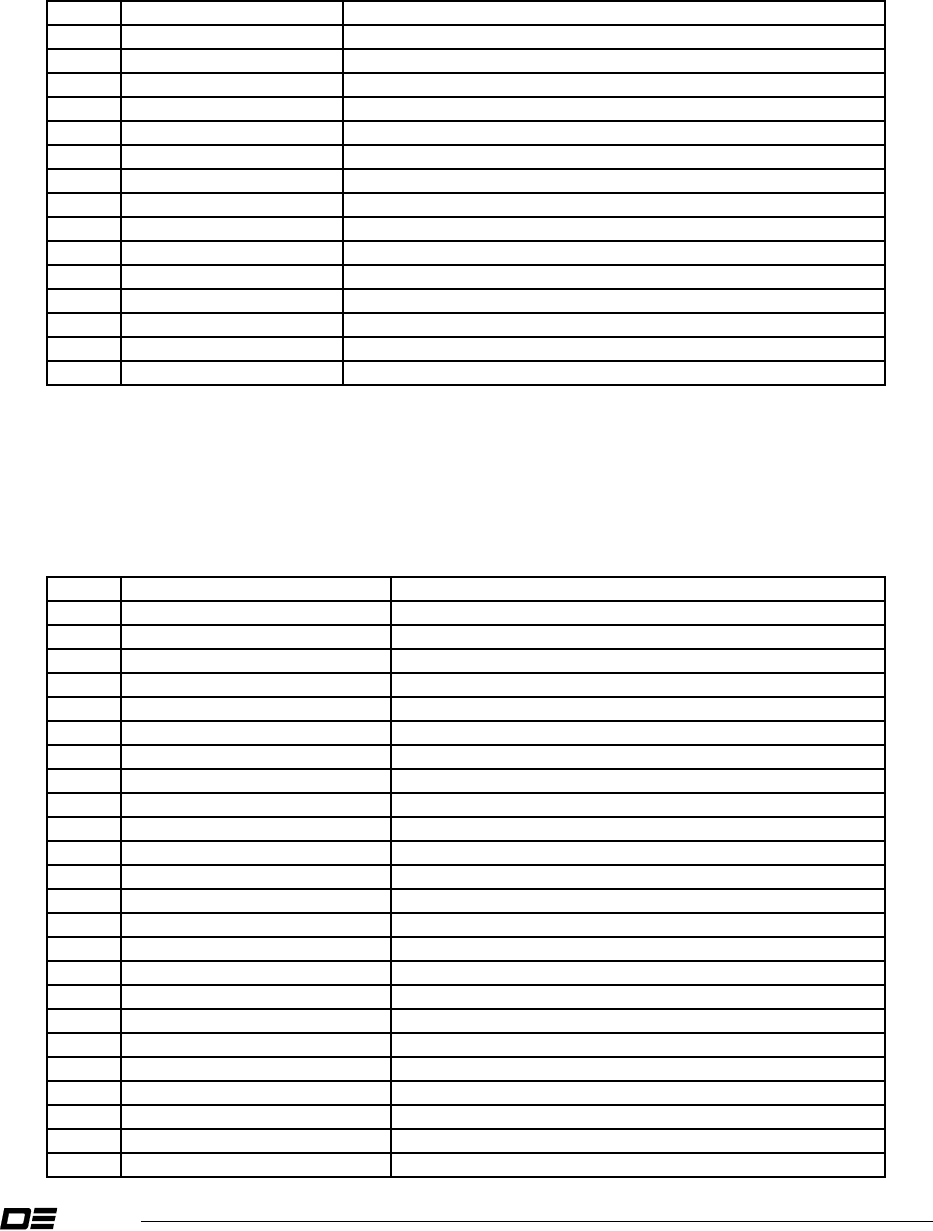
DANIELS
ELECTRONICS LTD
TM
CI-PM-3 Paging Modulator Instruction Manual 4-1
4 CONNECTOR PIN FUNCTIONS AND JUMPER FUNCTIONS
4.1 Data / Control Port (Connector J1) Pin Functions
Table 4-1 Data / Control Port (Connector J1) Pin Functions
PIN NAME FUNCTION
1 2-Lvl Data 2 Level RS-232 Data input.
2 4-Lvl Data 4 Level RS-232 Data input.
3 Ext Clock External Clock for 4 Level signal synchronization.
4 2-Lvl/4-Lvl Select 2 Level / 4 Level select. Low = 2 Level, High = 4 Level.
5 A/D Mode Select Analog / Digital Mode select. Low = Digital, High = Analog.
6 Discr O/P Discriminator Output from Receiver.
7 PTT Push To Talk.
8 Ground Ground.
9 Balanced Audio I/P 1 Balanced Audio Input 1. Routed directly to Transmitter.
10 Balanced Audio I/P 2 Balanced Audio Input 2. Routed directly to Transmitter.
11 Data Out Regenerated digital data from receiver.
12 HU/Busy CTCSS Hang Up / Busy signal from optional CTCSS module.
13 No Connection -
14 No Connection -
15 No Connection -
4.2 Motherboard Interface (Connector P1) Pin Functions
Table 4-2 Motherboard Interface Connector P1 Pin Functions
Note: Bolded entries are utilized by CI-PM-3
PIN NAME FUNCTION
C1 IMC1 Inter-module Communications Line No. 1
B1 5W RX AUDIO 5W RX A/RX B Audio From System Monitor
A1 5W RX AUDIO 5W RX A/RX B Audio From System Monitor
C2 TX A AUDIO CNTL TX A Audio Control
B2 13.8V 13.8V from M3 Motherboard J8 (Unregulated)
A2 13.8V 13.8V from M3 Motherboard J8 (Unregulated)
C3 IMC2 Inter-module Communications Line No. 2
B3 RX A AMPD AUDIO RX A Amplified Audio Output
A3 RX B AMPD AUDIO RX B Amplified Audio Output
C4 TX B AUDIO CNTL TX B Audio Control
B4 9.5V Regulated +9.5V from System Monitor
A4 9.5V Regulated +9.5V from System Monitor
C5 IMC3 Inter-module Communications Line No. 3
B5 RX A 9.5V RX A Current Sense Output Line (Supply)
A5 RX B 9.5V RX B Current Sense Output Line (Supply)
C6 ALARM 1 Inter-module Alarm Line No. 1.
B6 TX A PTT Transmitter A Press To Talk input.
A6 TX B PTT Transmitter B Press To Talk input.
C7 ALARM 2 Inter-module Alarm Line No. 2.
B7 RX A 9.5V MON RX A Current Sense Output Line (Module)
A7 RX B 9.5V MON RX B Current Sense Output Line (Module)
C8 ALARM 3 Inter-module Alarm Line No. 3
B8 RX A COR RX A Carrier Operated Relay Output
A8 RX B COR RX B Carrier Operated Relay Output
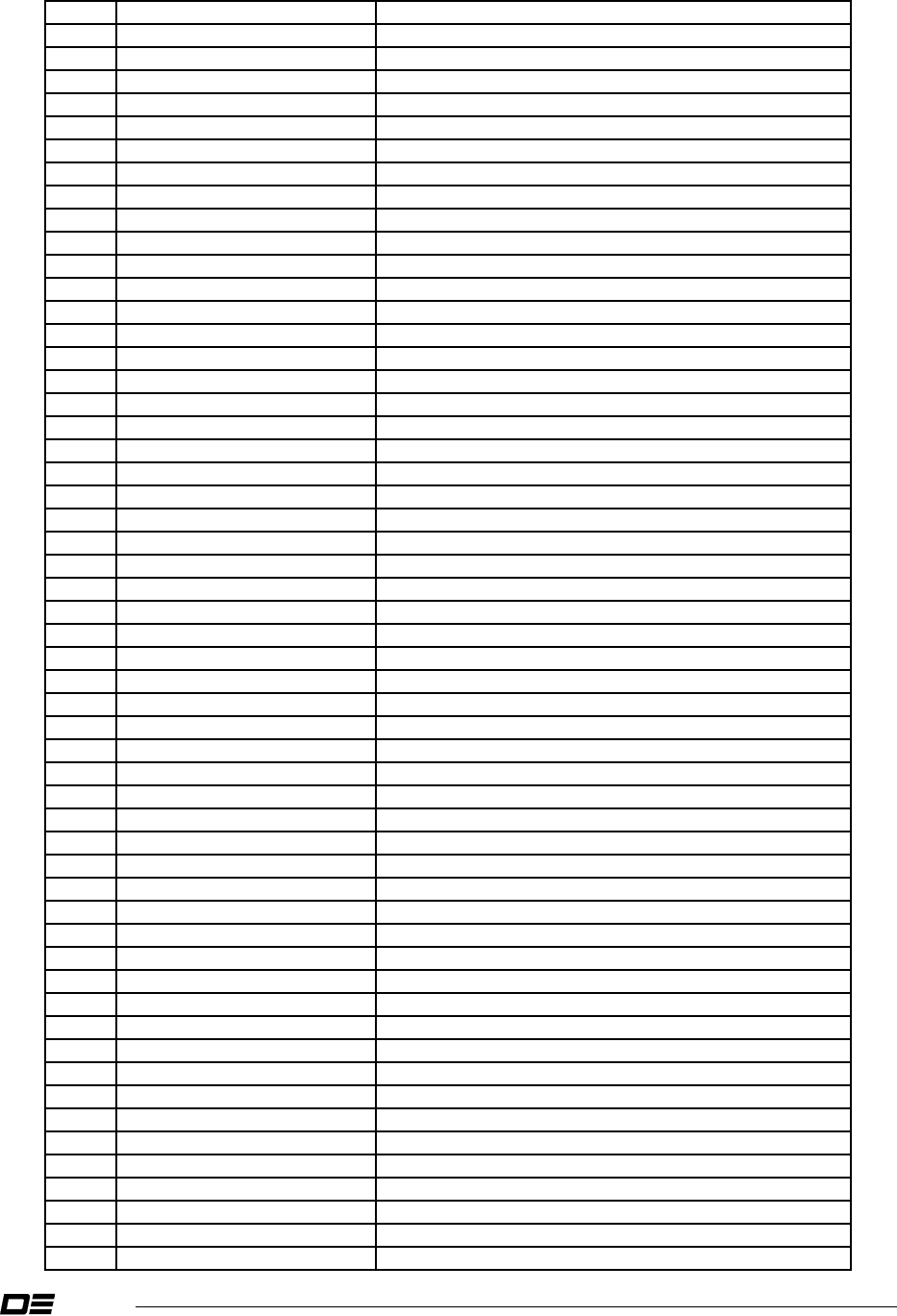
DANIELS
ELECTRONICS LTD
TM
4-2 CI-PM-3 Paging Modulator Instruction Manual
PIN NAME FUNCTION
C9 ALARM 4 Inter-module Alarm Line No. 4
B9 TX A STANDBY TX A Audio Standby
A9 TX B STANDBY TX B Audio Standby
C10 RX A SQL OVERRIDE RX A Squelch Disable Input
B10 RX A DISC O/P RX A Discriminator Output
A10 TX A PTT OUT TX A Microphone Press To Talk Output
C11 ALARM 5 Inter-module Alarm Line No. 5
B11 SPARE 5 Inter-module Spare Line No. 5
A11 SPARE 6 Inter-module Spare Line No. 6
C12 RX A SQL FLAT RX A Squelched, Flat Audio Output
B12 RX A ISO COR A RX A Isolated Carrier Operated Relay, Side A O/P
A12 RX A ISO COR K RX A Isolated Carrier Operated Relay, Side K O/P
C13 ALARM 6 Inter-module Alarm Line No. 6
B13 RX A DISC L/P O/P RX A Discriminator Low-Pass Audio Output
A13 RX B DISC L/P O/P RX B Discriminator Low-Pass Audio Output
C14 RX B SQL DE-EMP RX B Squelched, De-Emphasized Audio Output
B14 SPARE 3 Inter-module Spare Line No. 3
A14 SPARE 4 Inter-module Spare Line No. 4
C15 ALARM 7 Inter-module Alarm Line No. 7
B15 RX A SIG STREN RX A Signal Strength Indicator Output
A15 RX B SIG STREN RX B Signal Strength Indicator Output
C16 TX B BAL I/P 1 TX B Balanced Audio Input, Side 1
B16 TX B SUBT I/P 1 TX B Subtone Audio Input No. 1
A16 TX B PTT OUT TX B Microphone Press To Talk Output
C17 ALARM 8 Inter-module Alarm Line No. 8
B17 TX A VSWR FWD TX A VSWR Forward Level Indicator Output
A17 TX B VSWR FWD TX B VSWR Forward Level Indicator Output
C18 TX A BAL I/P 1 TX B Balanced Audio Input, Side 1
B18 TX A BAL I/P 2 TX B Balanced Audio Input, Side 2
A18 TX B BAL I/P 2 TX B Balanced Audio Input, Side 2
C19 SPARE 1 Inter-module Spare Line No. 1
B19 TX A VSWR REV TX A VSWR Reverse Level Indicator Output
A19 TX B VSWR REV TX B VSWR Reverse Level Indicator Output
C20 SPARE 2 Inter-module Spare Line No. 2
B20 TX A DIR MOD TX A Direct Modulation Input
A20 TX B DIR MOD TX B Direct Modulation Input
C21 TX A CSEL D0 TX A Channel Select Line No. D0
B21 TX A CSEL D1 TX A Channel Select Line No. D1
A21 TX A CSEL D2 TX A Channel Select Line No. D2
C22 TX A SUBT I/P 1 TX A Subtone Audio Input No. 1
B22 RX A MUTE RX A Mute Input
A22 RX A SQL DE-EMP RX A Squelched, De-Emphasized Audio Output
C23 TX A CSEL D3 TX A Channel Select Line No. D3
B23 RX A CSEL D0 RX A Channel Select Line No. D0
A23 RX A CSEL D1 RX A Channel Select Line No. D1
C24 TX A SUBT I/P 2 TX A Subtone Audio Input No. 2
B24 RX A BAL O/P 1 RX A Balanced Audio Output, Side 1
A24 RX A BAL O/P 2 RX A Balanced Audio Output, Side 2
C25 RX A CSEL D2 RX A Channel Select Line No. D2
B25 RX A CSEL D3 RX A Channel Select Line No. D3
A25 TX B CSEL D0 TX B Channel Select Line No. D0
C26 TX B SUBT I/P 2 TX B Subtone Audio Input No. 2
B26 RX B SQL OVERRIDE RX B Squelch Disable Input
A26 RX B MUTE RX B Mute Input
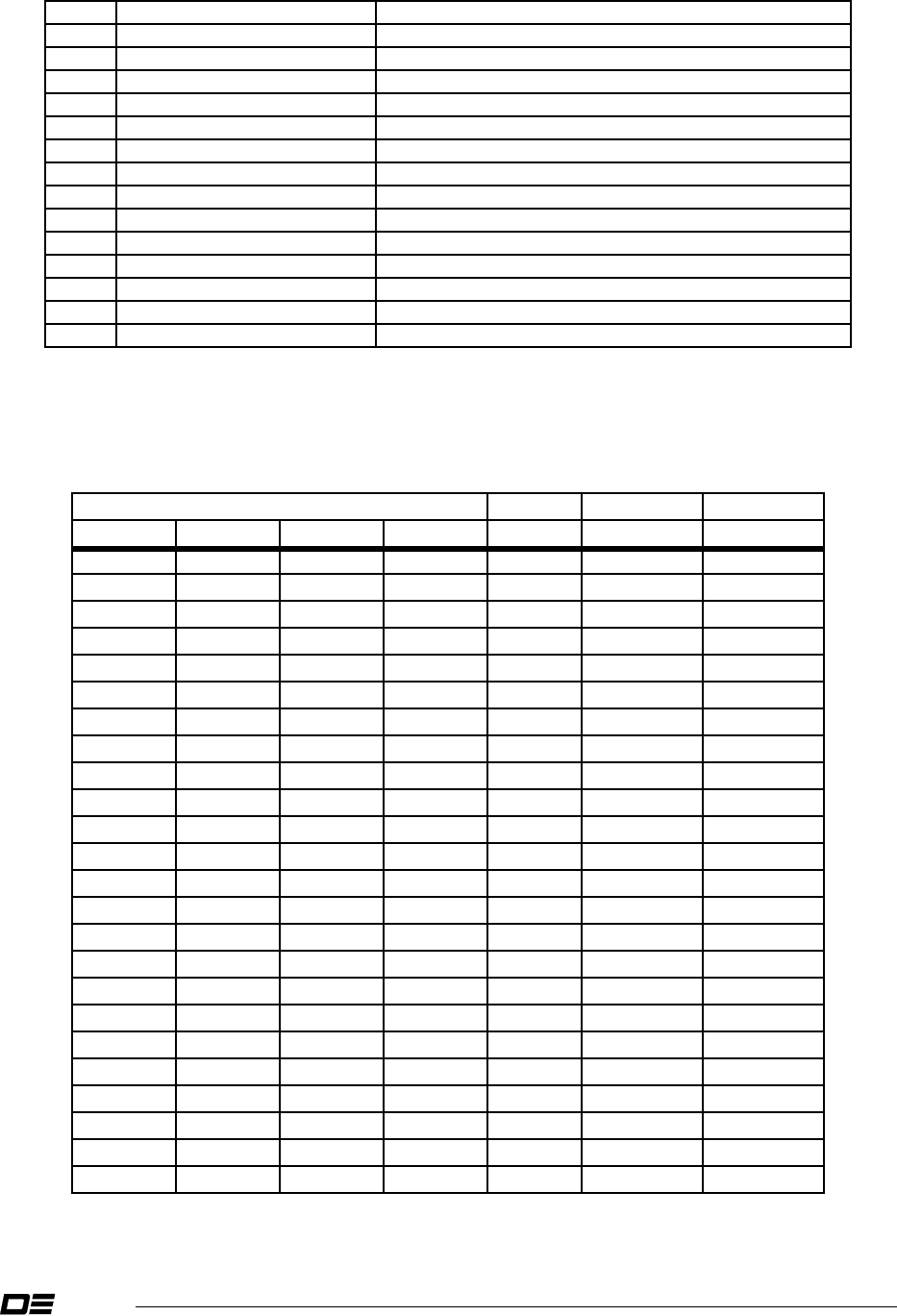
DANIELS
ELECTRONICS LTD
TM
CI-PM-3 Paging Modulator Instruction Manual 4-3
PIN NAME FUNCTION
C27 TX B CSEL D1 TX B Channel Select Line No. D1
B27 TX B CSEL D2 TX B Channel Select Line No. D2
A27 TX B CSEL D3 TX B Channel Select Line No. D3
C28 RX B DISC O/P RX B Discriminator Audio Output
B28 RX B ISO COR K RX B Isolated Carrier Operated Relay, Side K O/P
A28 RX B ISO COR A RX B Isolated Carrier Operated Relay, Side A O/P
C29 RX B CSEL D0 RX B Channel Select Line No. D0
B29 RX B CSEL D1 RX B Channel Select Line No. D1
A29 RX B CSEL D2 RX B Channel Select Line No. D2
C30 RX B BAL O/P 1 RX B Balanced Audio Output, Side 1
B30 RX B BAL O/P 2 RX B Balanced Audio Output, Side 2
A30 RX B SQL FLAT RX B Squelched, Flat Audio Output
C31 RX B CSEL D3 RX B Channel Select Line No. D3
B31 RX A PRIORITY COR RX A Priority COR (not affected by Mute)
4.3 CI-PM-3 Data Delay Jumper Settings
Table 4-3 Delay Settings
JUMPER SETTINGS DELAY DISTANCE DISTANCE
JU33 JU32 JU31 JU35 (µSec) (km) (mi)
AAAA41.20 0.75
AABA82.40 1.49
AAAC12 3.60 2.24
ABAA16 4.80 2.98
AAAE20 6.00 3.73
ABBC24 7.20 4.47
ABBA32 9.60 5.97
AABE40 12.00 7.46
ABAC48 14.40 8.95
BAAA64 19.20 11.93
ABAE80 24.00 14.91
ABBC96 28.80 17.90
BABA128 38.40 23.86
ABBE160 48.00 29.83
BAAC192 57.60 35.79
BBAA256 76.80 47.72
BAAE320 96.00 59.65
BABC384 115.20 71.59
BBAB512 153.60 95.45
BABE640 192.00 119.31
BBAC768 230.40 143.17
BBAD1024 307.20 190.89
BBAE1280 384.00 238.62
BBAF1536 460.80 286.34
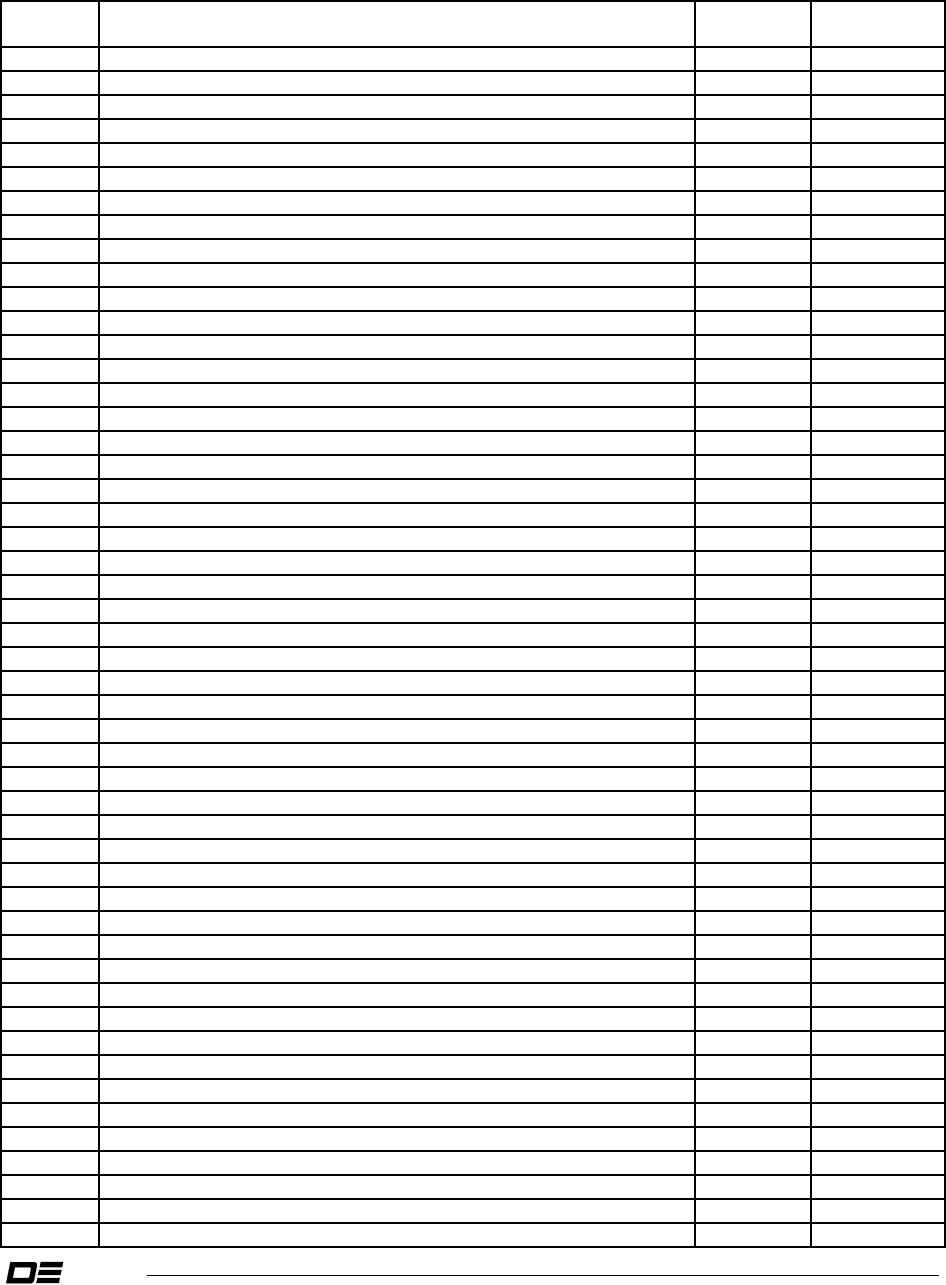
DANIELS
ELECTRONICS LTD
TM
4-4 CI-PM-3 Paging Modulator Instruction Manual
4.4 CI-PM-3 Circuit Board Jumpers
Table 4-4 CI-PM-3 Default Jumper Settings
REF.
DESIG. DESCRIPTION JUMPER
TYPE DEFAULT
POSITION
JU1 2-LVL Polarity Select (A = Inverted ; B = Normal) Shunt B
JU2 4-LVL Polarity Select (A = Normal; B = Inverted) Shunt A
JU3 RX A Balanced O/P 1 Enable SM Solder Not Installed
JU4 RX A Balanced O/P 2 Enable SM Solder Not Installed
JU5 XO Polarity Select (A = Normal; B = Inverted) Shunt B
JU6 XO Select (A=OCXO; B=VCXO) Shunt A
JU7 Data Regeneration (A = Disable; B = Enable) SM Solder A
JU8 Data Input (A = Data/Ctrl Port; B=RX A Regenerated Data) SM Solder A
JU9 Discriminator O/P To Front Panel J1 Enable SM Solder Not Installed
JU10 Repeater CTCSS Enable (A = Disable; B = Enable) SM Solder A
JU11 TX A Direct Modulation Enable SM Solder Installed
JU12 TX B Direct Modulation Enable SM Solder Not Installed
JU13 TX A Subtone I/P 2 Enable SM Solder Not Installed
JU14 TX B Subtone I/P 2 Enable SM Solder Not Installed
JU15 TX A Balanced I/P 1 Enable SM Solder Installed
JU16 TX B Balanced I/P 1 Enable SM Solder Not Installed
JU17 TX A Audio Control Enable SM Solder Installed
JU18 TX B Audio Control Enable SM Solder Not Installed
JU19 RX A COR Enable SM Solder Not Installed
JU20 TX A PTT Enable SM Solder Installed
JU21 TX B PTT Enable SM Solder Not Installed
JU22 Repeater PTT Enable SM Solder Not Installed
JU23 Level Select (A=2/4-LVL; B=4-LVL) Shunt A
JU24 TX A Balanced I/P 2 Enable SM Solder Installed
JU25 TX B Balanced I/P 2 Enable SM Solder Not Installed
JU26 Alarm 7 To TX A and B Balanced O/P 1 Enable SM Solder Installed
JU27 Alarm 5 To TX A and B Balanced O/P 2 Enable SM Solder Installed
JU28 CTCSS RX A Mute Bypass SM Solder Not Installed
JU29 RX A Discriminator Output Enable SM Solder Not Installed
JU30 RX A Mute Enable SM Solder Not Installed
JU31 Data Delay Selection (Refer to Table 4-3) SM Solder A
JU32 Data Delay Selection (Refer to Table 4-3) SM Solder A
JU33 Data Delay Selection (Refer to Table 4-3) SM Solder A
JU34 CTCSS PTT Bypass SM Solder Installed
JU35 Data Delay Selection (A - F, Refer to Table 4-3) SM Solder A
JU36 Data Delay/By-Pass Shunt Bypass
JU37 Switched 8.0 Volts For PLL I/O Circuitry SM Solder Not Installed
JU38 Switched 8.0 Volts For Data Delay Circuitry SM Solder Not Installed
JU39 Switched 5.0 Volts For PLL I/O Circuitry SM Solder Not Installed
JU40 Switched 5.0 Volts For Regenerated PTT and Data Delay Circuitry SM Solder Not Installed
JU41 Analog/Digital Mode Over-ride Shunt A
JU42 Low Frequency Deviation Enable SM Solder Not Installed
JU43 RX B Discriminator O/P Enable SM Solder Not Installed
JU44 RX B Mute Enable SM Solder Not Installed
JU45 RX B COR Enable SM Solder Not Installed
JU46 RX B Balanced O/P 1 Enable SM Solder Not Installed
JU47 RX B Balanced O/P 2 Enable SM Solder Not Installed
JU48 External Clock Enable (A = Disable; B = Enable) Shunt A
JU49 Switched 5.0 Volts For 2-LVL / 4-LVL Switching Circuitry SM Solder Installed
JU50 RS-232 Data Out Enable SM Solder Not Installed
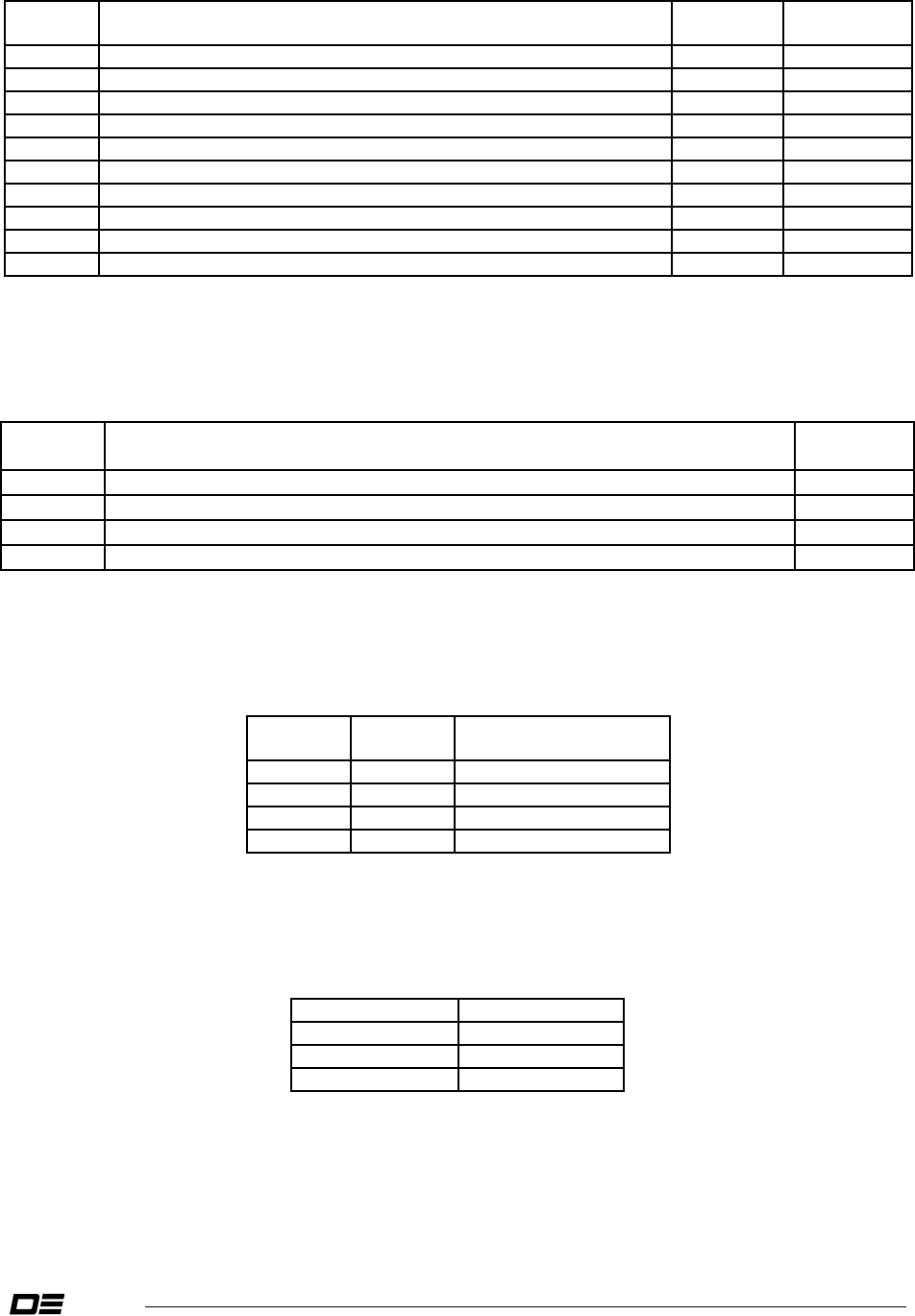
DANIELS
ELECTRONICS LTD
TM
CI-PM-3 Paging Modulator Instruction Manual 4-5
REF.
DESIG. DESCRIPTION JUMPER
TYPE DEFAULT
POSITION
JU51 Repeater Digital-Only PTT Enable SM Solder Installed
JU52 TS-64 Hang-up RX Mute SM Solder Not Installed
JU53 TS-64 Busy Input Enable SM Solder Not Installed
JU54 TS-64 Busy Input Connect to COR SM Solder Not Installed
JU55 TS-64 Repeater PTT Enable (Analog/Digital only) SM Solder Not Installed
JU56 Switched 9.5 Volts For Reference Input Circuitry SM Solder Not Installed
JU57 U18 (14174 IC) enable SM Solder Not Installed
JU58 Data regeneration SM Solder Not Installed
JU59 PLL calibration reference SM Solder Not Installed
JU60 U4 or U4A select SM Solder Not Installed
4.5 TS-64 MOD1 Jumper Settings - (If installed)
Table 4-5 CTCSS Jumper Settings
REF.
DESIG. DESCRIPTION DEFAULT
POSITION
JP1-JP6 CTCSS Tone Frequency Select *
JP7 RX Audio Mute Polarity (Installed: Mute = Open, Not Installed: Mute = Ground) Installed
JP8-JP10 TX Time-Out-Timer Interval Select *
JP11 Hang-Up/Busy-Input Configure (Installed = Busy-Input, Not Installed = Hang-Up Input) Not Installed
Note: Refer to TS-64 Instruction Sheet for configuration details.
4.6 4-Level Modulation Bit Pattern
Table 4-6 4-Level Modulation Bit Pattern
J1-PIN1
(BIT 0) J1-PIN2
(BIT 1) DEVIATION
SETTING
0 0 - 4800 Hz
0 1 - 1600 Hz
1 1 + 1600 Hz
1 0 + 4800 Hz
4.7 Receiver IF / Audio PCB Jumper Settings
Table 4-9 Receiver IF / Audio PCB Jumper Settings
JUMPER POSITION
JU5 Short
JU25 Short
JU37 Open
Note: All other jumper settings as per the factory defaults.
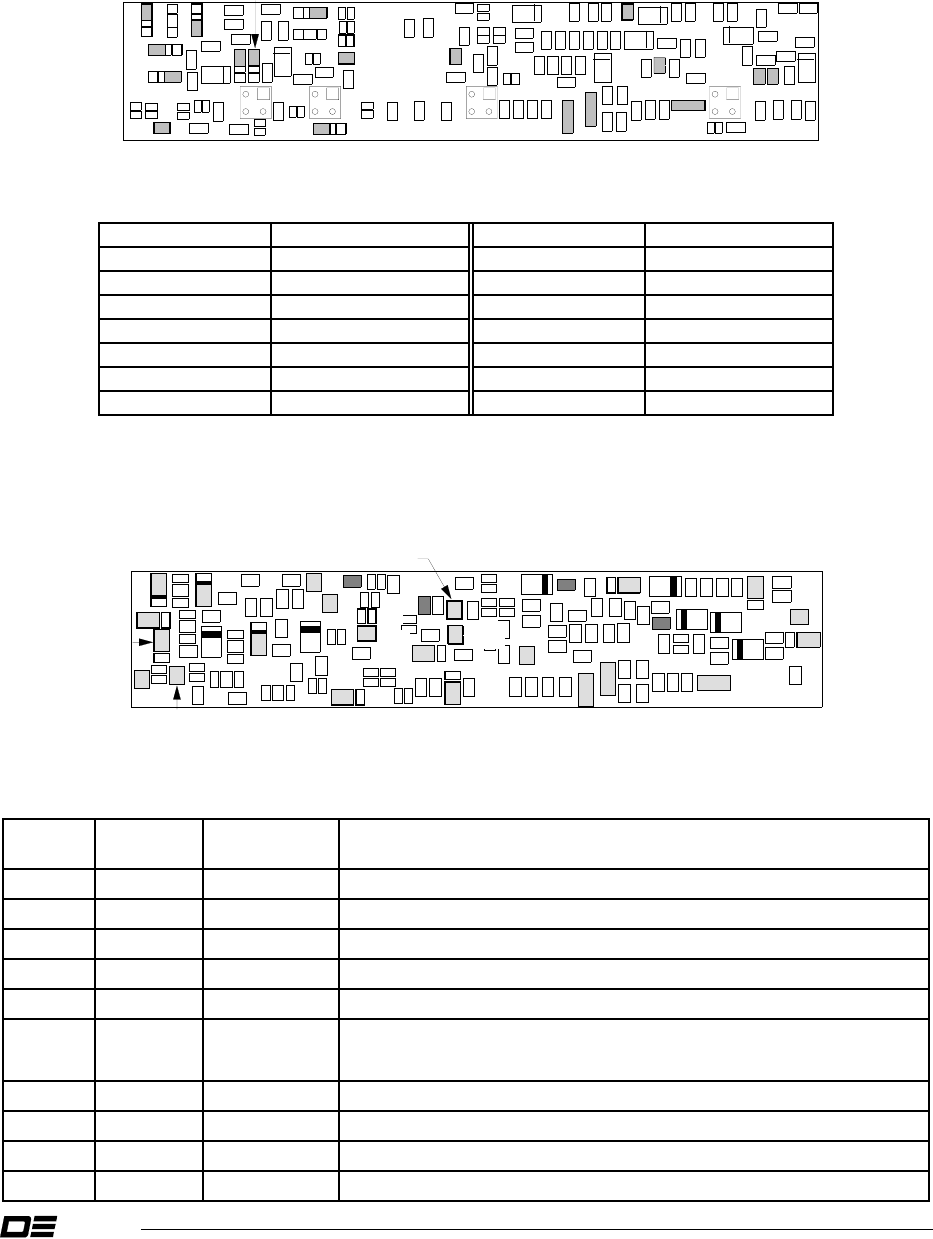
DANIELS
ELECTRONICS LTD
TM
4-6 CI-PM-3 Paging Modulator Instruction Manual
4.8 Transmitter Audio Processor Jumper Settings
Figure 4-1 Transmitter Audio Processor V1.6 Jumper Settings
JU28
JU34
JU35 JU38 JU1
JU8 JU27
JU6
100nF
JU9
JU11
JU15
CIPM3M6A
Table 4-7 Transmitter Audio Processor V1.6 Jumper Settings
JUMPER POSITION JUMPER POSITION
JU1 Y JU15 Open
JU6 (VHF) Replaced with 100nF JU27 Y
JU6 (UHF) Short JU28 Y
JU8 Short JU34 Y
JU9 Open JU35 Y
JU11 Open JU38 Y
JU10 Short
Note: All other jumper settings as per the factory defaults.
Figure 4-2 Transmitter Audio Processor V1.8 Jumper Settings
JU34
JU38
JU35 JU37
JU5
JU28 JU15
JU9
JU11
JU8
JU1
JU27
JU6
100nF
CIPM3M7A
Table 4-8 Transmitter Audio Processor V1.8 Jumper Settings
Jumper Balanced
I/P Subtone I/P
1 / 2 Description
JU1 OUT OUT Direct Modulation Circuits Power Source Select
JU2 OUT OUT MT-2 Deviation Enable (MT-2 Transmitters)
JU3 OUT OUT Microphone Preamplifier Flat Response
JU4 OUT IN Subtone Input 2 Audio Path Select
JU5 OUT OUT / Y Auxiliary Input Enable (DC Or AC Coupled)
JU6 IN(UHF) IN(UHF) Processed Audio Path Enable (Limited And Filtered). Replace with a
100nF capacitor for VHF
JU7 OUT OUT Unprocessed Auxiliary Audio Path Enable (Unfiltered)
JU8 IN IN Audio Output DC Coupled
JU9 OUT OUT Balanced Input Pre-emphasis Response Enable
JU10 IN OUT Balanced Input Flat Audio Response Enable
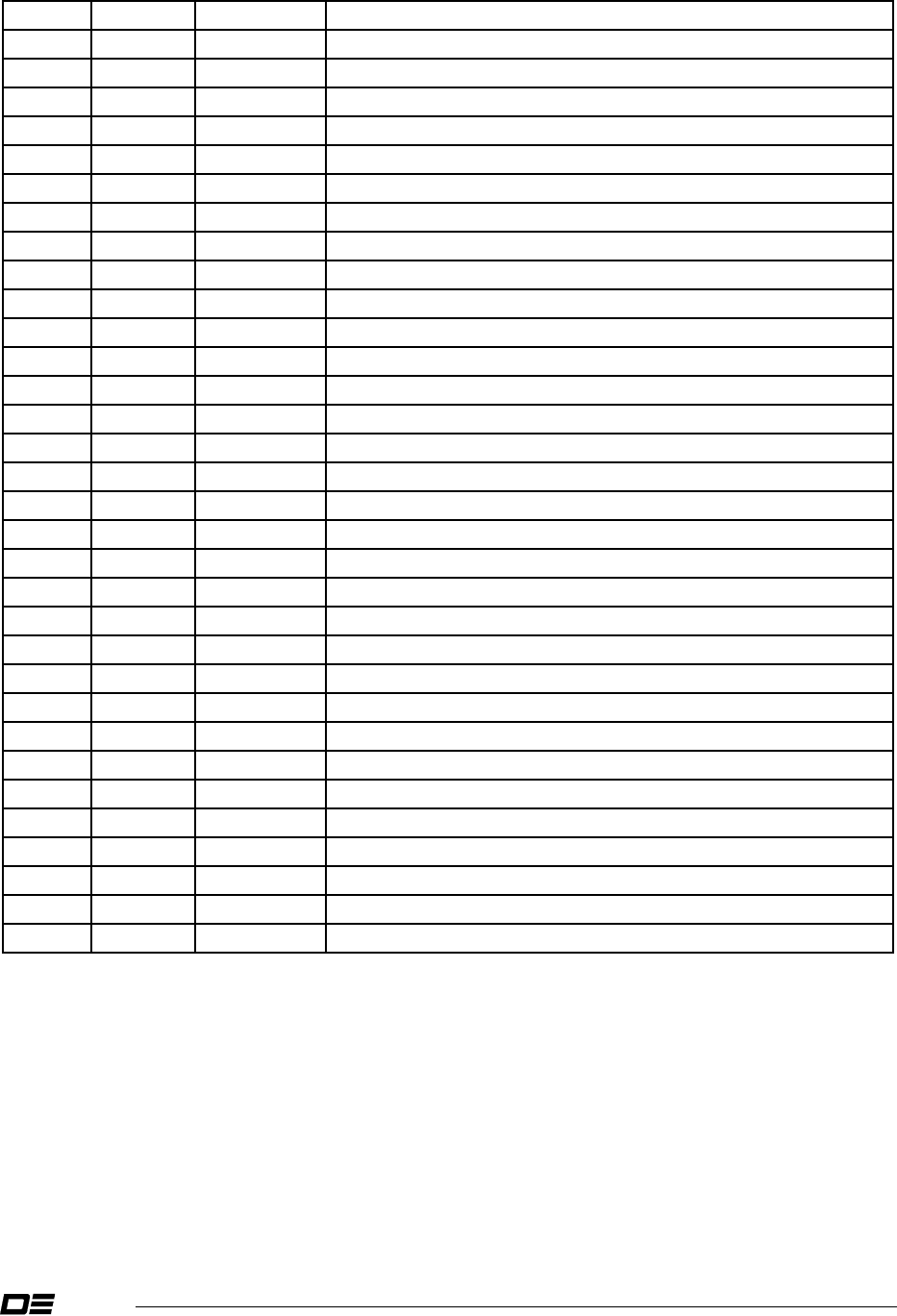
DANIELS
ELECTRONICS LTD
TM
CI-PM-3 Paging Modulator Instruction Manual 4-7
JU11 Y OUT Balanced Input To Auxiliary Audio Circuit Enable
JU12 OUT OUT Tone/Digital Input To Auxiliary Audio Circuit Enable
JU13 OUT OUT / IN Direct Modulation Input To Auxiliary Audio Circuit Enable
JU14 OUT OUT Auxiliary Input Pre-emphasis Response Enable
JU15 OUT OUT / IN Auxiliary Input Flat Audio Response Enable
JU16 OUT IN / OUT Subtone Input 1 Audio Path Select
JU17 OUT OUT MT-2 Temperature Compensation Bypass
JU18 OUT OUT Continuous Data Mode Selection
JU19 X X Audio Switches Power Source Select (X=Continuous, Y=Switched)
JU20 Y Y Q2 Power Source Select (Y=Continuous, X=Switched)
JU21 Y Y Bilateral Switch Power Source Select (Y=Continuous, X=Switched)
JU22 X X Audio Output To Splatter Filter
JU23 OUT OUT / IN Direct Modulation Input To Subtone 2 Enable
JU24 OUT OUT Splatter Filter Response Select
JU25 OUT OUT Splatter Filter Response Select
JU26 OUT OUT Splatter Filter Response Select
JU27 Y Y Direct Modulation Input Audio Path Select
JU28 Y Y Amplified Direct Modulation Bypass
JU29 OUT OUT Amplified Direct Modulation Input DC Coupled Enable
JU30 OUT OUT Amplified Direct Modulation Audio Path Select
JU31 OUT OUT Audio Output AC-Coupled (MT-3 Synthesized Transmitters)
JU32 OUT OUT Audio Output AC-Coupled (MT-3 Crystal Transmitters)
JU33 OUT OUT Audio Output AC-Coupled
JU34 Y Y Audio Output From Direct Modulation Circuits Select
JU35 OUT OUT Direct Modulation Output Source Select
JU36 Y OUT AGC Preamplifier Power Source Select (Y=Continuous, X=Switched)
JU37 OUT OUT Direct Modulation Output Enable
JU38 OUT OUT / X Subtone 2, DC Coupled, To Direct Modulation Output Select
JU39 OUT OUT Direct Modulation Low Input Impedance Enable
JU40 OUT OUT Microphone Preamplifier Power Enable
JU41 Not Used
JU42 OUT OUT Processed Audio Path To Direct Modulation Output
JU43 OUT OUT Bilateral Switch U9 Bypass Enable
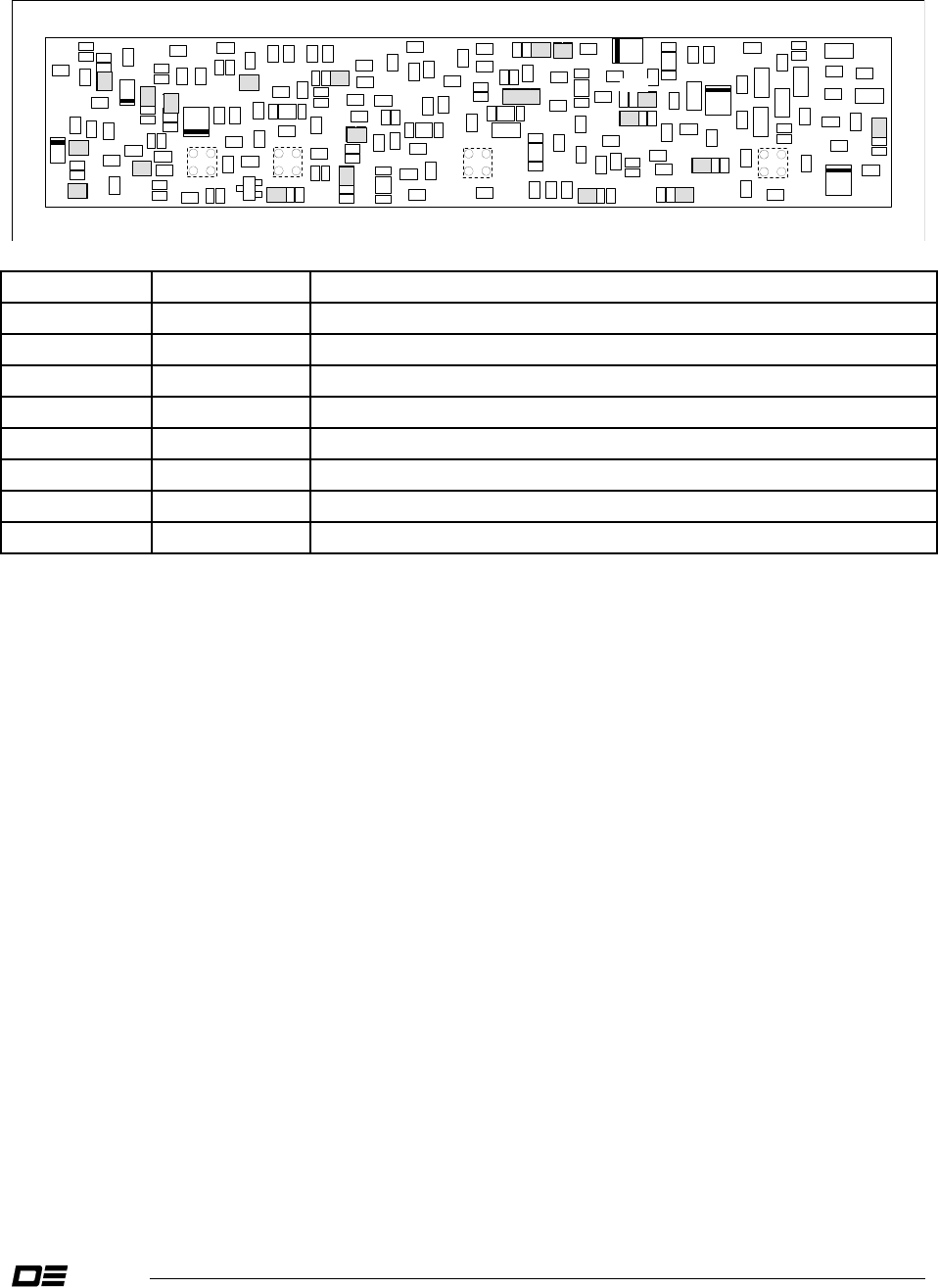
DANIELS
ELECTRONICS LTD
TM
4-8 CI-PM-3 Paging Modulator Instruction Manual
Figure 4-3 Transmitter Audio Processor V2.3 Jumper Settings
JU8 JU35
Y
X
JU8
JU25
X
JU43
JU34
Y
JU27
JU20
Y
X
JU42
X
CIPM3M8A
Table 4-9 Transmitter Audio Processor V2.3 Jumper Settings
JUMPER POSITION DESCRIPTION
JU8 Short Audio Output DC couple
JU20 X Direct modulation input buffer ( X enabled, Y bypass )
JU21 Y Transmit audio control
JU25 X Wide/Narrow Band Switched Select (X wide )
JU27 Y Direct Modulation Input Offset Output (Y enabled, X Bypass)
JU34 Y Audio Routing ( Y enabled , X dual port)
JU42 X Modulation input bias select ( X no offset, Y offset adjust)
JU43 Short Modulation input Direct (Short) / Cap Couple (Open)
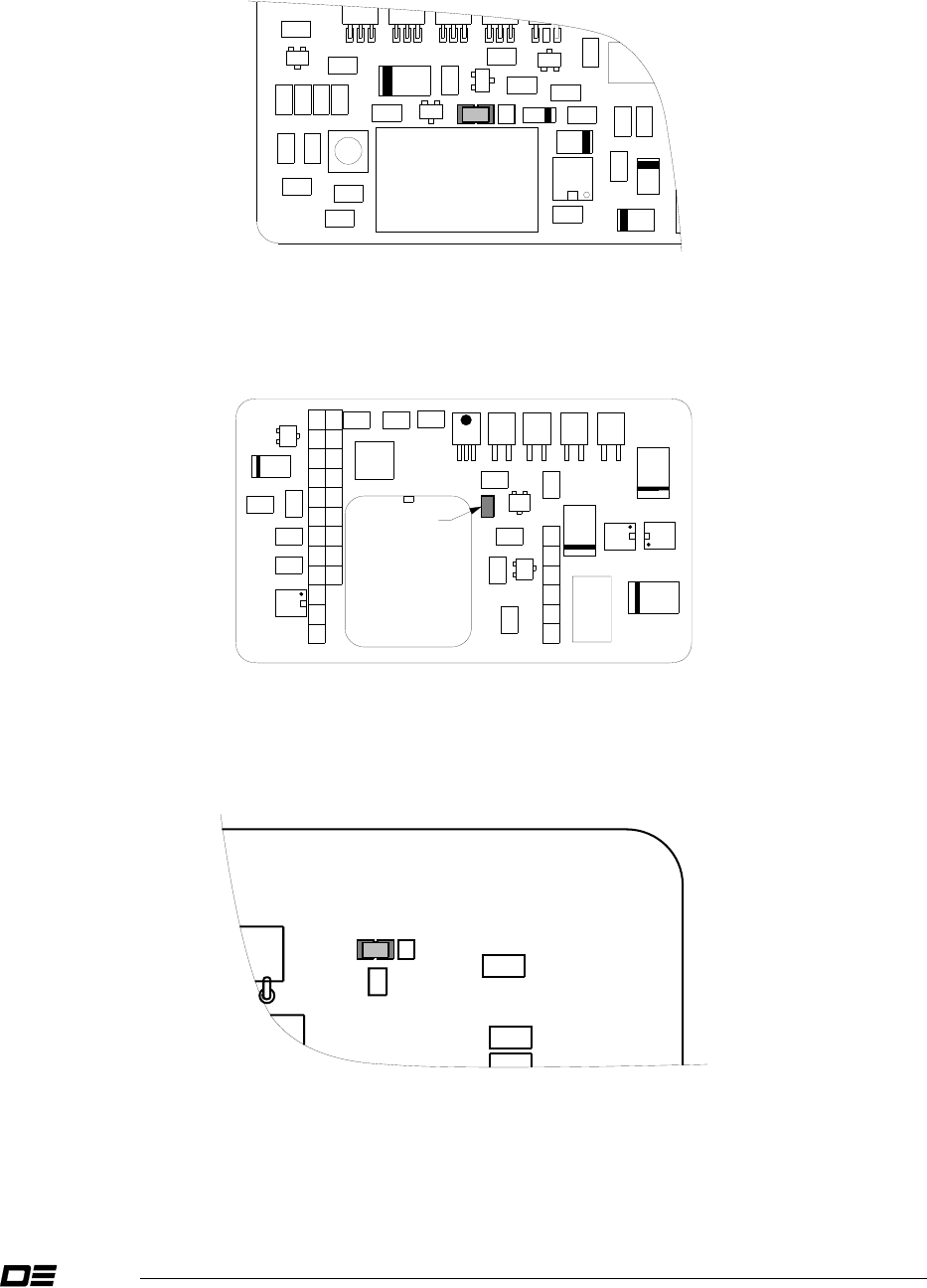
DANIELS
ELECTRONICS LTD
TM
CI-PM-3 Paging Modulator Instruction Manual 4-9
4.9 Transmitter Synthesizer Jumper Settings
Figure 4-3 VHF and (400 MHz) UHF Synthesizer Analog PCB Jumper Settings
A B
JU1
CIPM3M8
Jumper JU1 must be installed in the ‘A’ position to enable the external reference option.
Figure 4-4 VHF and (400 MHz) UHF Synthesizer Digital PCB Jumper Settings
JU2
CIPM3M10
Jumper JU2 must be installed to enable the 10MHz reference option.
Figure 4-5 800MHz and 900MHz Transmitter Synthesizer Jumper Settings
JU1
A B
CIPM3M9
Jumper JU1 must be installed in the ‘A’ position to enable the external reference option.
Bottom
View of
PCB
Bottom
View of
PCB
Top View
Of PCB
Bottom
View of
PCB
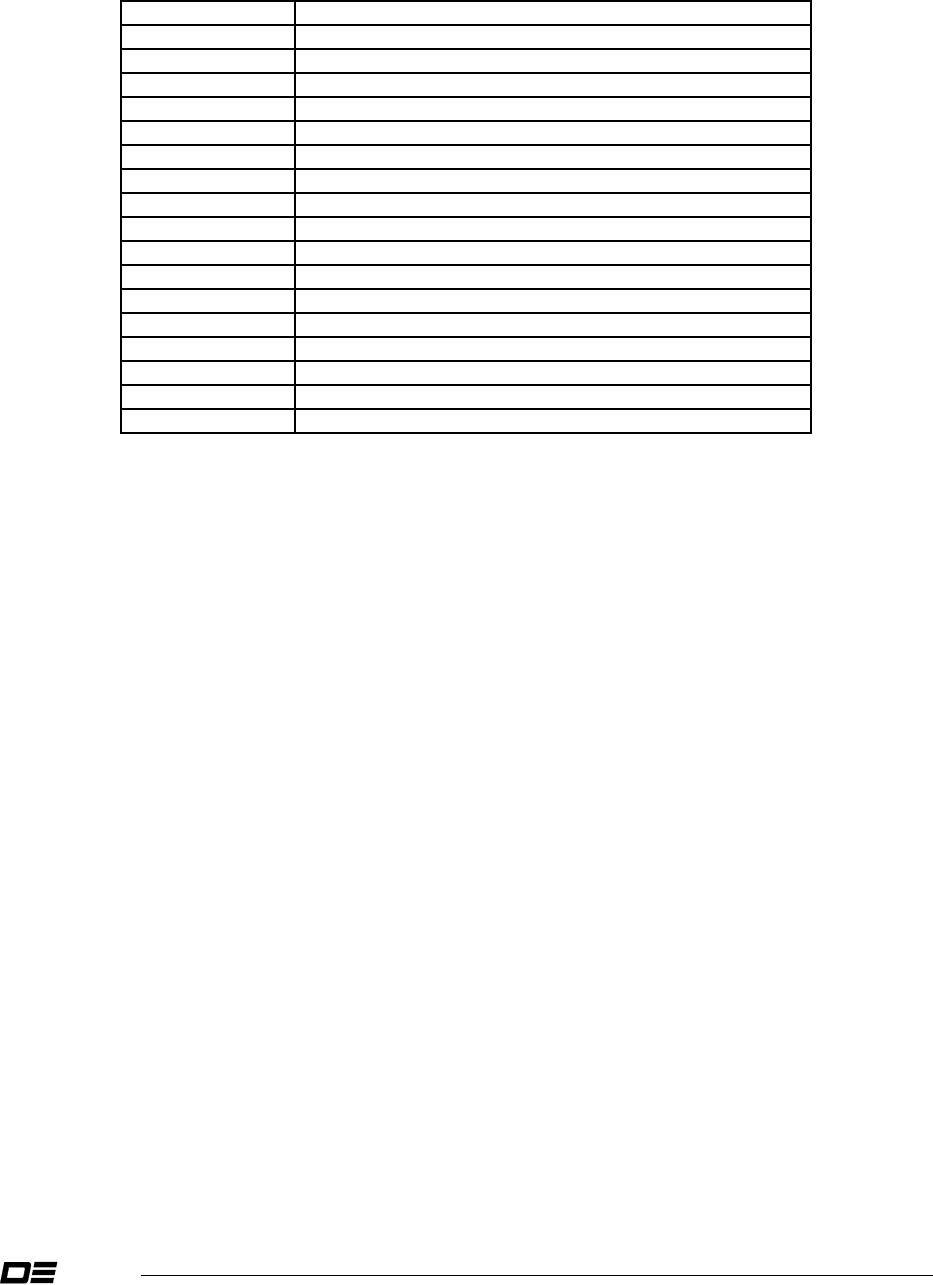
DANIELS
ELECTRONICS LTD
TM
4-10 CI-PM-3 Paging Modulator Instruction Manual
4.10 CI-PM-3 Test Points
Table 4-10 CI-PM-3 Test Points
TEST POINT DESCRIPTION
TP1 +8 Vdc Supply
TP2 +4 Vdc Supply
TP3 +5 Vdc Supply
TP4 Analog / Digital Mode (High = Digital, Low = Analog)
TP5 2 Level Data (TTL)
TP6 OCXO 9.5 Vdc Supply
TP7 Positive and Negative Edge Integrator Output
TP8 Data Delay Programmable Counter Output.
TP9 Input to Data Delay Circuitry
TP10 2 Level Data
TP11 Level Adjusted Paging Signal
TP12 OCXO Reference Adjust (nominally 2.5 Vdc)
TP13 PLL Correction Voltage
TP14 Tx A/B Direct Modulation Output
TP15 13.8 Vdc Supply Input (from Subrack)
TP16 9.5 VDC Supply Input (from Subrack)
TP17 Low Pass Filter Output

DANIELS
ELECTRONICS LTD
TM
CI-PM-3 Paging Modulator Instruction Manual 5-1
5 ILLUSTRATIONS AND SCHEMATIC DIAGRAMS
5.1 CI-PM-3 Front Panel Controls

DANIELS
ELECTRONICS LTD
TM
CI-PM-3 Paging Modulator Instruction Manual 6-1
6 PARTS LISTS
6.1 CI-PM-3 Electrical Parts List

DANIELS
ELECTRONICS LTD
TM
CI-PM-3 Paging Modulator Instruction Manual 7-1
7 REVISION HISTORY
Issue Issued Revised Details
3 Nov 99 N/A All prototype updates incorporated in this issue.
All previous revision history in preliminary issue 3 (Pre3).
Jan 02 New CI-PM-3 version to accommodate multiple footprints for
U4
( AD9901 ) , and incorporate changes to the reference input
circuit
( MMIC removed ).
4 Jan 02 New Issue, incorporates all changes since release of Issue 3.
4 A Dec 02 Correct component layout (bottom CIPM3M4E)
- TP14 & TP15 locations corrected
- JU56 designation removed

DANIELS
ELECTRONICS LTD.
TM
MT-3 RADIO SYSTEMS
UHF SYNTHESIZED
TRANSMITTER
INSTRUCTION MANUAL
UT-3/400 406 - 512 MHz
Covers models:
UT-3/420-SNC2, UT-3/420-SWC2, UT-3/420-SNC8, UT-3/420-SWC8,
UT-3/460-SNC2, UT-3/460-SWC2, UT-3/460-SNC8, UT-3/460-SWC8,
UT-3/480-SNC2, UT-3/480-SWC2, UT-3/480-SNC8, UT-3/480-SWC8,
UT-3/500-SNC2, UT-3/500-SWC2, UT-3/500-SNC8, UT-3/500-SWC8,
Copyright © 1998 Daniels Electronics Ltd. All rights reserved. No part of this publication may be
reproduced, stored in a retrieval system or transmitted in any form or by any means, electronic,
mechanical, photocopying, recording or otherwise, without the prior written consent of Daniels
Electronics Ltd.
DE™ is a registered trademark of Daniels Electronic Ltd. registered in the United States Patent and
Trademark Office.
Issue: 4 Previous Issue: 3
Issue Date: December 98 Previous Issue Date: August 98 Daniels Electronics Ltd.
Printing Date: December 98 Victoria, BC
Part No.: IM23-UT3400 PRINTED IN CANADA

DE DANIELS
ELECTRONICS
ii UHF Transmitter Instruction Manual UT-3 406 - 512 MHz
Reviewed By:
Quality Assurance:
Larry Freeman
_________________
Name Signature Date
NOTE:
The user's authority to operate this equipment could be revoked through any
changes or modifications not expressly approved by Daniels Electronics Ltd.
The design of this equipment is subject to change due to continuous
development. This equipment may incorporate minor changes in detail from the
information contained in this manual.

DE DANIELS
ELECTRONICS
UHF Transmitter Instruction Manual UT-3 406 - 512 MHz iii
TABLE OF CONTENTS
Page
1 GENERAL..................................................................................................................1-1
1.1 Introduction.....................................................................................................1-1
1.2 Manual Organization.......................................................................................1-1
1.3 UT-3 406 - 512 MHz Transmitter Family Models..........................................1-2
1.4 Performance Specifications.............................................................................1-3
1.4.1 General................................................................................................1-3
1.4.2 Audio Specifications ...........................................................................1-4
1.4.3 Physical Specifications........................................................................1-5
2 SYSTEM OVERVIEW...............................................................................................2-1
2.1 Transmitter Operation.....................................................................................2-1
2.2 Frequency Selection........................................................................................2-3
2.2.1 Synthesizer Transmitter....................................................................2-3
2.3 Transmitter Assembly and Adjustment............................................................2-3
2.3.1 Complete Transmitter Alignment.........................................................2-3
2.3.2 Frequency Change..............................................................................2-4
2.3.3 Output Power Adjustment...................................................................2-5
2.3.4 Deviation Setting.................................................................................2-5
2.3.5 Setting RF Alarm Thresholds..............................................................2-5
2.4 Recommended Test Equipment List................................................................2-6
2.5 Repair Note.....................................................................................................2-6
2.6 Printed Circuitboard Numbering Convention..................................................2-6
3 ILLUSTRATIONS.....................................................................................................3-1
3.1 MT-3 Transmitter Front Panel ........................................................................3-1
3.2 MT-3 Transmitter Case - Exploded View........................................................3-2
4 PARTS LIST ..............................................................................................................4-1
5 REVISION HISTORY ...............................................................................................5-1
MODULE MANUALS
Transmitter Main Board Instruction Manual ..................................... IM20-MT3TXMN
UHF Amplifier Instruction Manual UT-3 406 - 512 MHz ..............IM23-UT3400AMP
Enhanced Synthsizer Instruction Manual OS(R/T)-3A/H 29-470 MHz ..IM10-OS3AH
UHF Transmitter Channel Designation Table .....................................IM23-UT3400CT

DE DANIELS
ELECTRONICS
UHF Transmitter Instruction Manual UT-3 406 - 512 MHz 1-1
1 GENERAL
1.1 Introduction
The UT-3 406 - 512 MHz Transmitter is a synthesized FM transmitter capable of operating in 12.5
kHz or 25 kHz channels. The transmitter operates continuous duty in one of four frequency bands:
406 to 430 MHz, 450 to 470 MHz, 470 to 490 MHz or 490 to 512 MHz and its output power is
continuously adjustable from 0.5 T0 2.0 or 2.0 to 8.0 Watts. The transmitter is not to be operated
within the 406 to 406.1 MHz frequency band, unless specifically authorized by COSPAS/SARSAT
through the Federal Communications Commission and/or Industry Canada. A modular design
allows each of the transmitter's modules; MT-3 Transmitter Board, MT-3 Audio Processor, UT-
3/400 Amplifier, and OS-3H400 Synthesizer Module to be individually assembled and tested. This
facilitates construction, tuning, maintenance as well as troubleshooting procedures. The synthesizer
module can be programmed to have up to 16 channels exclusive to one frequency band.
The UT-3 406 - 512 MHz Transmitter is designed to interface with Daniels Electronics' MT-3
Repeater System while maintaining MT-2 System compatibility. Both repeater systems are
characterized by dependable, low maintenance performance under the most severe environmental
conditions.
1.2 Manual Organization
The organization of this manual reflects the modular makeup of the UT-3 product line. Each
module is fully described within its respective submanual, all of which are contained within this
document. In general, each submanual contains:
1. A functional description and specification summary,
2. A detailed technical description (Theory of Operation) and
3. Assembly, setup and alignment procedures relevent to that particular module.
The module manuals are as follows:
Note: material presented in a given "submanual" may include information related to other module
versions not directly applicable to the UT-3 406 - 512 MHz Transmitter family (eg, the OS-3H
Synthesizer Instruction Manual covers models from 29 MHz to 512 MHz).
UHF Transmitter Instruction Manual UT-3 406 - 512 MHz: This manual provides an overview of
the complete transmitter, manual organization and assembly in terms of the other modules.
MT-3 Transmitter Main Board Instruction Manual: This manual pertains to the audio processor
module, transmitter Main Board and Front Panel Board. Most of the user selectable options are
accessed within the Transmitter Main Board module, including channel selection. Since all external
connections (including power and signal lines) are made to the Transmitter Main Board, most of the
material pertaining to transmitter operation and installation is found here.

DE DANIELS
ELECTRONICS
1-2 UHF Transmitter Instruction Manual UT-3 406 - 512 MHz
UHF Amplifier Instruction Manual UT-3 406 - 512 MHz : The amplifier module provides the
final stages of RF power amplification and harmonic filtering for the transmitter. This manual is
intended primarily as a reference since the amplifier module is adjusted at the factory.
Enhanced Synthesizer Instruction Manual OS(R/T)-3(A/H) 132 - 470 MHz: This manual pertains
to the enhanced synthesizer module.
UHF Transmitter Channel Designation Table UT-3 406 - 512 MHz: This document relates the
operating frequency to the transmitter channel number (see section 2.1).
1.3 UT-3 406 - 512 MHz Transmitter Family Models
There are 16 distinct models in the UT-3/400 Transmitter family each with different bands of
operation, channel spacing and/or power outputs. The 16 models are as follows:
• UT-3/420-SN02 - synthesized, 406-430 MHz band, 12.5 kHz channels, 0.5-2.0 Watt
• UT-3/420-SN08 - synthesized, 406-430 MHz band, 12.5 kHz channels, 2.0-8.0 Watt
• UT-3/420-SW02 - synthesized, 406-430 MHz band, 25 kHz channels, 0.5-2.0 Watt
• UT-3/420-SW08 - synthesized, 406-430 MHz band, 25 kHz channels, 2.0-8.0 Watt
• UT-3/460-SN02 - synthesized, 450-470 MHz band, 12.5 kHz channels, 0.5-2.0 Watt
• UT-3/460-SN08 - synthesized, 450-470 MHz band, 12.5 kHz channels, 2.0-8.0 Watt
• UT-3/460-SW02 - synthesized, 450-470 MHz band, 25 kHz channels, 0.5-2.0 Watt
• UT-3/460-SW08 - synthesized, 450-470 MHz band, 25 kHz channels, 2.0-8.0 Watt
• UT-3/480-SN02 - synthesized, 470-490 MHz band, 12.5 kHz channels, 0.5-2.0 Watt
• UT-3/480-SN08 - synthesized, 470-490 MHz band, 12.5 kHz channels, 2.0-8.0 Watt
• UT-3/480-SW02 - synthesized, 470-490 MHz band, 25 kHz channels, 0.5-2.0 Watt
• UT-3/480-SW08 - synthesized, 470-490 MHz band, 25 kHz channels, 2.0-8.0 Watt
• UT-3/500-SN02 - synthesized, 490-512 MHz band, 12.5 kHz channels, 0.5-2.0 Watt
• UT-3/500-SN08 - synthesized, 490-512 MHz band, 12.5 kHz channels, 2.0-8.0 Watt
• UT-3/500-SW02 - synthesized, 490-512 MHz band, 25 kHz channels, 0.5-2.0 Watt
• UT-3/500-SW08 - synthesized, 490-512 MHz band, 25 kHz channels, 2.0-8.0 Watt
The transmitters' band of operation is determined by select components in the synthesizer module
and the channel width is determined by the roll-off of the splatter filter on the MT-3 Audio
Processor.

DE DANIELS
ELECTRONICS
UHF Transmitter Instruction Manual UT-3 406 - 512 MHz 1-3
1.4 Performance Specifications
1.4.1 General
The following is a general set of specifications for the generic UT-3/400 transmitter. Additional
specifications, specific to individual modules may be found in their respective submanuals.
Type: MT-3 Series Transmitter.
Family: UT-3 406 - 512 MHz.
Compatibility: MT-2 Series and MT-3 Series Radio Systems.
Frequency Range: 406 to 512 MHz (406 to 406.1 MHz unavailable, see note below).
RF Power Output: Continuously Adjustable: 0.5 to 2.0 W or 2.0 to 8.0 W.
Modulation: 11K0F3E or 16K0F3E (Frequency Modulation).
System Impedance: 50 Ω; Type N connector.
Duty Cycle: 100%; Continuous operation from -40°C to +60°C.
Spurious Emissions: More than 80 dB below carrier.
Harmonic Emissions: More than 90 dB below carrier.
Transmitter Mismatch Protection: 20:1 VSWR at all phase angles.
Transmitter Alarm: Forward power sense and reverse VSWR;
• open collector output (separate or 'OR'ed configuration);
• linear output (separate lines only).
Operating Temperature Range: -30˚C to +60˚C, optional -40˚C temperature test.
Operating Humidity: 95% RH (non-condensing) at +25°C.
Operating Voltage: +13.8 Vdc Nominal (range +11 to +16 Vdc),
+9.5 Vdc Regulated.
Transmit Current: 1.2 Amps at 2 Watts RF Power Output,
2.5 Amps at 8 Watts RF Power Output
Front Panel Controls: NORM (repeat mode), OFF, and KEY TX (Tx on).
PTT Activation: • Active to ground with or without time-out-timer;
• Microphone activated with or without time-out-timer;
• Front Panel switch: KEY TX - without time-out-timer;
• NORM - with or without time-out-timer.
• Isolated (optional relay) with or without time-out-timer.

DE DANIELS
ELECTRONICS
1-4 UHF Transmitter Instruction Manual UT-3 406 - 512 MHz
PTT Time-Out-Timer: Selectable from 1 sec. to 8 hrs. (factory set 5 min.).
Reference Frequency: 9.600000 MHz.
Channel Spacing: 12.5 kHz or 25 kHz.
Frequency Stability: Standard: ±1 ppm, -40°C to +60°C. Optional: high stability
external reference provided through front panel connection.
Channel Selection: In 12.5 kHz increments selected through four internal BCD
rotary switches. Preset capability for 16 channel memory
selectable through external control.
Standby Current and Rise time: 95% RF power, 95% system deviation within;
• 50 ms: typically 7 mA (normal configuration);
• 25 ms: typically 65 mA (synthesizer continuously enabled);
• 10 ms: typically 90 mA (synth. and audio circuitry enabled).
DOC Type Approval RSS119 142 194 241
RSS122 142 221 126
FCC Type Acceptance: H4JUT-3-420-S02 (406-430 MHz, 0.5-2.0 Watt),
H4JUT-3-420-S08 (406-430 MHz, 2.0-8.0 Watt),
H4JUT-3-460-S02 (450-470 MHz, 0.5-2.0 Watt),
H4JUT-3-460-S08 (450-470 MHz, 2.0-8.0 Watt).
Note: The transmitter is not to be operated within the 406 to 406.1 MHz frequency band, unless
specifically authorized by COSPAS/SARSAT through the Federal Communications Commission
and/or Industry Canada.
1.4.2 Audio Specifications
Audio Input: Balanced 600 ohm or unbalanced (optional).
Input level sensitivity, -25 dBm to 0 dBm.
Audio Response: Pre-emphasis (6 dB per octave); +0.5 to -2.0 dB from 300 Hz
to 3 kHz;
Flat Audio Response: +1 to -1 dB from 100 Hz to 3 kHz.
Audio Deviation: Preset to ±1.5 kHz or ±3.0 kHz with a 1 kHz tone;
(capable ±2.5 kHz or ±5.0 kHz).
Subtone Audio Input 1: 0.5 Vpp at 200 Hz for ±500 Hz deviation (internally
adjustable).
Subtone Audio Input 1 Freq range: 60 Hz to 300 Hz.

DE DANIELS
ELECTRONICS
UHF Transmitter Instruction Manual UT-3 406 - 512 MHz 1-5
Subtone Audio Input 2: 0.5 Vpp at 100 Hz for ±500 Hz deviation (internally
adjustable).
Subtone Audio Input 2 Freq range: DC to 150 Hz.
Direct Modulation Input: 0.5 Vrms at 1 kHz or ±3 kHz deviation.
Direct Modulation Freq range: DC to 5 kHz.
Audio Distortion: Less than 2.5% THD; 1 kHz tone at 1.5 kHz or 3 kHz
deviation (-40°C to +60°C).
Hum and Noise: Better than 40 dB (test receiver band limited: 400 Hz to 30
kHz).
1.4.3 Physical Specifications
Physical Dimensions: Width: Height: Depth:
7.1 cm (2.8 in) 12.8 cm (5.05 in) 19 cm (7.5 in)
Module Weight: 1.5 kg (3.3 lbs)
Corrosion Prevention: Anodized aluminum construction. Stainless steel hardware.
Selectively conformal coated glass epoxy 2 and 4 layer printed
circuitboards. Gold plated module connectors.
Module Design: Compact Eurostandard modular design. Plug-in modules mate
with Daniels standard M3 repeater subrack. Subracks /
modules comply with IEEE 1101, DIN 41494 and IEC 297-3
(mechanical size / modular arrangement).
External Connections: RF Connection: type N connector located on the transmitter
module front panel. Motherboard Connections (Audio, Power,
and Control) are made through a 48 pin, gold plated, type F
connector on the rear of the transmitter module. User
connection made through mated "motherboard" assembly of
the repeater subrack. Type F standard connector complies with
DIN 41612 Level 2 (200 mating cycles, 4 day 10 ppm SO2 gas
test with no functional impairment and no change in contact
resistance).
Handle Text Colour: Black.

DE DANIELS
ELECTRONICS
UHF Transmitter Instruction Manual UT-3 406 - 512 MHz 2-1
2 SYSTEM OVERVIEW
2.1 Transmitter Operation

DE DANIELS
ELECTRONICS
UHF Transmitter Instruction Manual UT-3 406 - 512 MHz 3-1
3 ILLUSTRATIONS
3.1 MT-3 Transmitter Front Panel

DE DANIELS
ELECTRONICS
UHF Transmitter Instruction Manual UT-3 406 - 512 MHz 4-1
4 PARTS LIST

DE DANIELS
ELECTRONICS
UHF Transmitter Instruction Manual UT-3 406 - 512 MHz 5-1
5 REVISION HISTORY
ISSUE DATE DESCRIPTION AND (REASON)
3 August 98 • Manual formatted to modular style. All previous revision history in
issue 2
4 December 98 • Added an advisory to our customers in section 1.1 and 1.4.1 that this
transmitter is not to be operated within the 406 to 406.1 MHz frequency
band.

DE DANIELS
ELECTRONICS
5-2 UHF Transmitter Instruction Manual UT-3 406 - 512 MHz
This Page Intentionally Left Blank

DANIELS
ELECTRONICS LTD.
TM
MT-3 RADIO SYSTEMS
TRANSMITTER
MAIN BOARD
INSTRUCTION MANUAL
Covers: Version 1.7 of the Transmitter Main Board
Version 1.6 & 1.8 of the FM Audio Processor Board
Copyright © 1998 Daniels Electronics Ltd. All rights reserved. No part of this publication may be
reproduced, stored in a retrieval system or transmitted in any form or by any means, electronic,
mechanical, photocopying, recording or otherwise, without the prior written consent of Daniels
Electronics Ltd.
DE™ is a registered trademark of Daniels Electronics Ltd. registered in the United States Patent
and Trademark Office.
Issue: 3 Previous Issue: 2
Issue Date: November 98 Previous Issue Date: May 98 Daniels Electronics Ltd.
Printing Date: NA Victoria, B.C.
Part No.: IM20-MT3TXMN PRINTED IN CANADA

DE DANIELS
ELECTRONICS
ii Transmitter Main Board Instruction Manual
Reviewed By:
Quality Assurance:
Larry Freeman
_________________
Name Signature Date
NOTE:
The user's authority to operate this equipment could be revoked through any
changes or modifications not expressly approved by Daniels Electronics Ltd.
The design of this equipment is subject to change due to continuous
development. This equipment may incorporate minor changes in detail from the
information contained in this manual.

DE DANIELS
ELECTRONICS
Transmitter Main Board Instruction Manual iii
TABLE OF CONTENTS
Page
1 GENERAL .................................................................................................................. 1-1
1.1 Introduction.................................................................................................... 1-1
1.2 Performance Specifications............................................................................ 1-1
1.2.1 General............................................................................................... 1-1
1.2.2 Audio Specifications .......................................................................... 1-2
2 THEORY OF OPERATION....................................................................................... 2-1
2.1 Transmitter Main Board................................................................................. 2-1
2.1.1 General............................................................................................... 2-1
2.1.2 Transmitter Push-To-Talk.................................................................. 2-1
2.1.2.1 Microphone PTT.................................................................... 2-1
2.1.2.2 PTT With Time-Out-Timer.................................................... 2-2
2.1.2.3 PTT No Time-Out-Timer....................................................... 2-2
2.1.2.4 Optional Relay ....................................................................... 2-2
2.1.2.5 PTT Output............................................................................ 2-3
2.1.2.6 PTT Voltage Switching .......................................................... 2-3
2.1.2.7 Transmitter Standby Modes................................................... 2-3
2.1.3 Audio Circuits.................................................................................... 2-4
2.1.3.1 Microphone Audio................................................................. 2-5
2.1.3.2 Received Audio ...................................................................... 2-5
2.1.4 Channel Selection............................................................................... 2-5
2.1.4.1 Synthesized Transmitter......................................................... 2-5
2.1.4.2 Crystal Controlled Transmitter............................................... 2-6
2.1.5 Amplifier Circuits............................................................................... 2-6
2.1.6 Time-Out-Timer Circuitry.................................................................. 2-6
2.2 MT-3 Front Panel Board................................................................................ 2-8
2.3 MT-3 Audio Processor (Version 1.6) ............................................................ 2-8
2.3.1 General............................................................................................... 2-8
2.3.2 Power Requirements .......................................................................... 2-8
2.3.3 Audio Processor Turn-on Time.......................................................... 2-9
2.3.4 Audio Processor Signals.................................................................... 2-9
2.3.4.1 Audio Processor Outputs....................................................... 2-9
2.3.4.2 Audio Processor Modulation Output ..................................... 2-10
2.3.4.3 Audio Processor Low Frequency / Direct Mod. Output......... 2-10
2.3.4.4 Audio Processor Inputs.......................................................... 2-10
2.3.4.5 Audio Processor Microphone Input....................................... 2-11
2.3.4.6 Audio Processor Balanced Input............................................ 2-11
2.3.4.7 Audio Processor Auxiliary Input............................................ 2-11
2.3.4.8 Audio Processor Subtone Inputs............................................ 2-11
2.3.4.9 Audio Processor Direct Modulation Input ............................. 2-12
2.4 MT-3 Audio Processor (Version 1.8) ............................................................ 2-12

DE DANIELS
ELECTRONICS
iv Transmitter Main Board Instruction Manual
2.4.1 General............................................................................................... 2-12
2.4.2 Power Requirements .......................................................................... 2-12
2.4.3 Audio Processor Turn-on Time.......................................................... 2-13
2.4.4 Audio Processor Signals.................................................................... 2-13
2.4.4.1 Audio Processor Outputs....................................................... 2-13
2.4.4.2 Audio Processor Modulation Output ..................................... 2-14
2.4.4.3 Audio Processor Low Frequency / Direct Mod. Output......... 2-14
2.4.4.4 Audio Processor Inputs.......................................................... 2-14
2.4.4.5 Audio Processor Microphone Input....................................... 2-15
2.4.4.6 Audio Processor Balanced Input............................................ 2-15
2.4.4.7 Audio Processor Auxiliary Input............................................ 2-15
2.4.4.8 Audio Processor Subtone Inputs............................................ 2-15
2.4.4.9 Audio Processor Direct Modulation Input ............................. 2-16
2.5 Low Frequency Modulation........................................................................... 2-16
3 TRANSMITTER ALIGNMENT ................................................................................ 3-1
3.1 General........................................................................................................... 3-1
3.2 Repair Note.................................................................................................... 3-1
3.3 Printed Circuitboard Numbering Convention................................................. 3-1
3.4 Recommended Test Equipment List............................................................... 3-1
3.5 Standard Factory Settings and Jumper Configuration.................................... 3-2
3.5.1 MT-3 Transmitter Board Factory Configuration................................ 3-2
3.5.2 MT-3 Audio Processor Factory Configuration .................................. 3-3
3.6 MT-3 Transmitter Board Alignment............................................................... 3-4
3.6.1 General............................................................................................... 3-4
3.6.2 MT-3 Transmitter Board Test Points ................................................. 3-5
3.7 Module Installation and Removal................................................................... 3-5
3.8 MT-3 Audio Processor Alignment................................................................. 3-6
3.8.1 General............................................................................................... 3-6
3.8.2 MT-3 Audio Processor Standard Deviation Adjustment .................... 3-6
3.9 Standard Factory Settings and Jumper Configuration.................................... 3-8
3.9.1 MT-3 Audio Processor Factory Configuration (Version 1.8) ............ 3-8
3.10 MT-3 Audio Processor Alignment (Version 1.8)........................................... 3-10
3.10.1 General............................................................................................... 3-10
3.10.2 MT-3 Audio Processor Standard Deviation Adjustment .................... 3-10
3.11 Low Frequency Modulation Configuration.................................................... 3-11
3.11.1 MT-3 Transmitters............................................................................. 3-11
3.11.2 MT-3 Transmitter Audio Processors.................................................. 3-12
3.11.3 Synthesizer and Crystal Controlled Oscillator.................................... 3-13
3.11.4 Tuning the Transmitter....................................................................... 3-14
4 TRANSMITTER INTERCONNECT PIN DEFINITIONS ....................................... 4-1
5 ILLUSTRATIONS AND SCHEMATIC DIAGRAMS.............................................. 5-1
5.1 Transmitter Block Diagram............................................................................ 5-1
5.2 Transmitter Main Board Electrical Assembly................................................. 5-3

DE DANIELS
ELECTRONICS
Transmitter Main Board Instruction Manual v
5.2.1 Transmitter Main Board Top Side Component Layout ...................... 5-3
5.2.2 Transmitter Main Board Bottom Side Component Layout................. 5-4
5.2.3 Transmitter Main Board Schematic Diagram ..................................... 5-5
5.3 Front Panel Board.......................................................................................... 5-6
5.3.1 Front Panel Board Component Layout............................................... 5-6
5.3.2 Front Panel Board Schematic............................................................. 5-7
5.4 Audio Processor Electrical Assembly (Version 1.6)....................................... 5-8
5.4.1 Audio Processor Component Layout ................................................. 5-8
5.4.2 Audio Processor Schematic Diagram................................................. 5-9
5.5 Audio Processor Electrical Assembly (Version 1.8)....................................... 5-10
5.5.1 Audio Processor Component Layout ................................................. 5-10
5.5.2 Audio Processor Schematic Diagram................................................. 5-11
5.5.3 TX Time-Out-Timer Electrical Assembly........................................... 5-12
5.5.3.1 TX Time-Out-Timer Component Layout................................ 5-12
5.5.3.2 TX Time-Out-Timer Schematic Diagram ............................... 5-12
6 PARTS LISTS............................................................................................................. 6-1
6.1 Transmitter Main Board Parts List................................................................. 6-1
6.1.1 Transmitter Main Board Electrical Parts List...................................... 6-1
6.1.2 Transmitter Main Board Mechanical Parts List.................................. 6-3
6.1.3 MT-3 Front Panel Board Electrical Parts List .................................... 6-4
6.2 MT-3 Audio Processor Parts List (Version 1.7) ............................................ 6-4
6.2.1 MT-3 Audio Processor Electrical Parts List (Version 1.6)................. 6-4
6.3 MT-3 Audio Processor Parts List (Version 1.8) ............................................ 6-6
6.3.1 MT-3 Audio Processor Electrical Parts List (Version 1.8)................. 6-6
7 REVISION HISTORY................................................................................................ 7-1

DE DANIELS
ELECTRONICS
Transmitter Main Board Instruction Manual 1-1
1 GENERAL
1.1 Introduction
The MT-3 Transmitter Main Board integrates the MT-3 Front Panel Board, MT-3 Audio
Processor, Synthesizer or Crystal Controlled Oscillator module, and Amplifier module together to
comprise a MT-3 series transmitter (see section 5.1: MT-3 Transmitter Block Diagram). The Front
Panel Board and the Audio Processor are soldered directly to the Transmitter Main Board while the
Amplifier and the Synthesizer or Crystal Controlled Oscillator module are frequency band sensitive,
plug-in modules. Circuitry and jumpers on the Transmitter Main Board control the operation of the
modules as well as the overall operation of the MT-3 transmitter. Power and signal connections are
made through the 48 pin type 'F' connector on the rear of the Transmitter Main Board where they
are then routed to the other MT-3 modules. The front and rear panels are attached to the
Transmitter Main Board and together with the extruded aluminum shell, form the transmitter
enclosure.
1.2 Performance Specifications
1.2.1 General
Type: MT-3 Series Transmitter
Compatibility: MT-3 Series Amplifier, OC-3 Crystal Controlled Oscillator
module, OS-3 and OS-3H Frequency Synthesizer modules.
Modulation: 11K0F3E or 16K0F3E (Frequency Modulation).
Operating Temperature Range: -30˚C to +60˚C, optional -40˚C to +60˚C temperature test.
Operating Humidity: 95% RH (non-condensing) at +25°C.
Operating Voltage: +9.5 Vdc Regulated. +13.8 Vdc Nominal (11 - 16 Vdc).
Front Panel Controls: NORM (repeat mode), OFF, and KEY TX (Tx on).
PTT Activation: • Active to ground with or without time-out-timer;
• Microphone activated with or without time-out-timer;
• Front Panel switch: KEY TX - without time-out-timer;
• NORM - with or without time-out-timer.
• Isolated (optional relay) with or without time-out-timer.
PTT Time-Out-Timer: Selectable from 1 sec. to 8 hrs. (Factory Default: 5 min.).

DE DANIELS
ELECTRONICS
1-2 Transmitter Main Board Instruction Manual
1.2.2 Audio Specifications
Audio Input: Balanced 600 ohm or unbalanced (optional).
Input level sensitivity, -25 dBm to 0 dBm.
Audio Response: Pre-emphasis (6 dB per octave); +0.5 to -2.0 dB
from 300 Hz to 3 kHz;
Flat Audio Response: +1 to -1 dB from 100 Hz to 3 kHz.
Audio Deviation: Preset to ±1.5 kHz (Narrow Band) or ±3.0 kHz (Wide Band)
with a 1 kHz tone (capable ±2.5 kHz or ±5.0 kHz).
Subtone Audio Input 1: 0.5 Vpp at 200 Hz for ±500 Hz deviation
(internally adjustable).
Subtone Audio Input 1 Frequency range: 60 Hz to 300 Hz.
Subtone Audio Input 2: 0.5 Vpp at 100 Hz for ±500 Hz deviation
(internally adjustable).
Subtone Audio Input 2 Frequency range: DC to 150 Hz.
Direct Modulation Input: 0.5 Vrms at 1 kHz or ±3 kHz deviation.
Direct Modulation Frequency range: DC to 5 kHz.

DE DANIELS
ELECTRONICS
Transmitter Main Board Instruction Manual 2-1
2 THEORY OF OPERATION
2.1 Transmitter Main Board
2.1.1 General

DE DANIELS
ELECTRONICS
Transmitter Main Board Instruction Manual 3-1
3 TRANSMITTER ALIGNMENT
3.1 General
Transmitter alignment is simplified by using an M-3 Subrack, SM-3 System Monitor, and RF
extender cable to provide transmitter power and signal interconnection. Alternatively, +9.5 Vdc and
+13.8 Vdc may be applied directly to a transmitter module through positive connection for the
+9.5 Vdc to pins B6 and Z6, for the +13.8 Vdc to pins B2 and Z2, and negative connection to pins
B30, Z30, B32, and Z32. Transmitter balanced audio (600 Ω) is available at pins B18 and Z18.
3.2 Repair Note
MT-3 Transmitter modules are mainly made up of surface mount devices which should not be
removed or replaced using an ordinary soldering iron. Removal and replacement of surface mount
components should be performed only with specifically designed surface mount rework and repair
stations complete with ElectroStatic Dissipative (ESD) protection.
When removing Surface Mount Solder Jumpers, it is recommended to use solder braid in place of
manual vacuum type desoldering tools when removing jumpers. This will help prevent damage to
the circuitboards.
3.3 Printed Circuitboard Numbering Convention
To ease troubleshooting and maintenance procedures, Daniels Electronics Limited has adopted a
printed circuitboard (PCB) numbering convention in which the last two digits of the circuitboard
number represent the circuitboard version. For example:
• PCB number 43-912010 indicates circuitboard version 1.0;
• PCB number 50002-02 indicates circuitboard version 2.0.
All PCB's manufactured by Daniels Electronics are identified by one of the above conventions.
3.4 Recommended Test Equipment List
Alignment of the complete transmitter requires the following test equipment or its equivalent. It is
assumed that any adjustment of the Transmitter Main Board will also involve the other modules.
Dual Power Supply: Regulated +9.5 Vdc at 2 A.
Regulated +13.8 Vdc at 2 A - Topward TPS-4000
Oscilloscope / Multimeter: Fluke 97 Scopemeter
Current Meter: Fluke 75 multimeter

DE DANIELS
ELECTRONICS
3-2 Transmitter Main Board Instruction Manual
Radio communications test set : Marconi Instruments 2955R
VSWR 3:1 mismatch load: JFW 50T-035-3.0:1
Alignment Tool: Johanson 4192
It is recommended that the radio communications test set be frequency locked to an external
reference (WWVH, GPS, Loran C) so that the high stability oscillator may be accurately set to
within its ±1 ppm frequency tolerance.
3.5 Standard Factory Settings and Jumper Configuration
Standard factory settings and the associated jumper configuration for each module of the MT-3
series transmitter are given below.
3.5.1 MT-3 Transmitter Board Factory Configuration
The MT-3 Transmitter Main Board is factory configured as follows:
• Transmitter standby mode 1 (lowest standby current consumption).
• Receiver squelched, de-emphasized audio amplifier disabled.
• Optional relay not installed.
• Separate amplifier power sense outputs.
The corresponding jumper settings are:
• Jumper J2: 'x' position Optional relay configuration
• Jumper J3: no connection Optional relay configuration
• Jumper J4: 'y' position Optional relay configuration
• Jumper J6: not installed Transmitter standby mode select - Mode 1
• Jumper J7: 'y' position Audio processor standby mode select
• Jumper J9: not installed Receiver audio ac/dc input coupling
• Jumper J12: not installed Amplifier power sense output configuration
• Jumper J13: 'x' position Amplifier power sense output configuration
• Jumper J14: 'x' position Amplifier power sense output configuration
• Jumper J15: 'x' position Amplifier power sense output configuration
• Jumper J16: 'x' position Microphone configuration
• Jumper J17: installed Microphone output line
• Jumper J18: 'y' position Synthesizer or crystal module standby mode select
• Jumper J19: 'x' position 600Ω audio transformer enable. 'y' position disables
• Jumper J20: 'x' position 600Ω audio transformer enable. 'y' position disables
• Jumper J21: not installed +8 Vdc audio processor supply bypass
• Jumper J22: 'x' position 600Ω audio transformer enable. 'y' position disables
• Jumper J23: 'x' position 600Ω audio transformer enable. 'y' position disables
• Jumper J24: installed Subtone #2 output enable
• Jumper J25: 'x' position Audio output enable

DE DANIELS
ELECTRONICS
Transmitter Main Board Instruction Manual 3-3
• Jumper J26: installed Time-Out-Timer Timing resistor select.
• Jumper J27: not installed Time-Out-Timer Timing resistor select.
• Jumper J28: not installed Time-Out-Timer Timing period output select.
• Jumper J29: installed Time-Out-Timer Timing period output select.
• Jumper J31: installed Time-Out-Timer Timing period output select.
• Jumper J32: not installed Time-Out-Timer Timing period output select.
• Jumper J33: installed Time-Out-Timer input enable
• Jumper J34: installed Time-Out-Timer power enable
• Jumper J35: installed Time-Out-Timer output enable
Note: Jumpers J1, J5, J8, J10, J11 designations not used
3.5.2 MT-3 Audio Processor Factory Configuration (Version 1.6)
The MT-3 Audio Processor is factory configured as follows:
• Maximum Deviation: ±2.5 kHz (12.5 kHz or 15 kHz channel),
±5.0 kHz (25 kHz or 30 kHz channel).
• Microphone Input: 1 kHz signal at -10 dBm gives ±50% maximum deviation,
1 kHz signal compression set at ±60% maximum deviation.
• Audio Balanced Input: Enabled - pre-emphasis response,
1 kHz tone at -8 dBm gives ±60% maximum deviation.
1 kHz signal compression set at ±60% maximum deviation.
• Subtone Input 1: 100 Hz tone at -18 dBm gives ±500 Hz deviation.
• All other audio inputs:Disabled.
• Time-Out-Timer: 5 minutes ± 30 seconds.
The corresponding Audio Processor jumper settings are:
• Jumper JU1: not installed Power source select for Direct Modulation circuits.
• Jumper JU2: not installed MT-2 deviation enable (MT-2 transmitters).
• Jumper JU3: installed Microphone preamplifier power enable.
• Jumper JU4: installed Balanced audio preamplifier power enable.
• Jumper JU5: not installed Balanced audio ground enable.
• Jumper JU6: installed Processed audio path enable (limited and filtered).
• Jumper JU7: not installed Unprocessed auxiliary audio path enable (unfiltered).
• Jumper JU8: not installed Audio output DC coupled (MT-2 transmitters).
• Jumper JU9: installed Balanced input preemphasis response enable.
• Jumper JU10: not installed Balanced input flat audio response enable.

DE DANIELS
ELECTRONICS
3-4 Transmitter Main Board Instruction Manual
• Jumper JU11: not installed Balanced input to auxiliary audio circuit enable.
• Jumper JU12: not installed Tone/Digital input to auxiliary audio circuit enable.
• Jumper JU13: not installed Direct modulation input to auxiliary audio circuit enable.
• Jumper JU14: not installed Auxiliary input preemphasis response enable.
• Jumper JU15: not installed Auxiliary input flat audio response enable.
• Jumper JU16: not installed Subtone input 2 audio path select.
• Jumper JU17: installed MT-2 Temperature compensation bypass.
• Jumper JU18: not installed Continuous data mode selection.
• Jumper JU19: 'y'position Power source for audio switches.
• Jumper JU20 to JU22: not used
• Jumper JU23: not installed Direct modulation input to subtone 2 enable.
• Jumper JU24: installed Lowpass filter response select.
• Jumper JU25: installed Lowpass filter response select.
• Jumper JU26: installed Lowpass filter response select.
• Jumper JU27: not installed Direct Modulation input audio path select.
• Jumper JU28: not installed Amplified direct modulation bypass.
• Jumper JU29: not installed Amplified direct modulation input DC couple enable.
• Jumper JU30: not installed Amplified direct modulation audio path select.
• Jumper JU31: not installed Subtone 2, AC coupled,to direct modulation output enable.
• Jumper JU32: not installed Audio output AC coupled (MT-3 crystal transmitters).
• Jumper JU33: not installed Audio output AC coupled (MT-3 synthesized transmitters).
• Jumper JU34: not installed Audio output from Direct Modulation circuits select.
• Jumper JU35: not installed Direct Modulation output source select.
• Jumper JU36: 'x' position Subtone input 1 audio path select.
• Jumper JU37: not installed Summed Subtone audio to direct modulation output enable
• Jumper JU38: not installed Subtone 2, DC coupled, to direct modulation output select.
• Jumper JU39: not installed Direct Modulation low input impedance enable.
3.6 MT-3 Transmitter Board Alignment
3.6.1 General
Before proceeding with the transmitter alignment, check that the appropriate jumpers are installed.
The standard jumper configuration for the Transmitter Main Board, given in section 3.5.1, is
normally employed for transmitter alignment. In a standard configuration, the only alignment
required on the MT-3 Transmitter Main Board for a synthesized transmitter is to set the frequency
switches (FSW1, FSW2, FSW3, and FSW4) for the desired channel frequency. FSW1 is the
most significant digit of the frequency switches. The switch settings for the desired channel
frequency can be found in the channel designation tables. If the transmitter is using a crystal
control oscillator module, the switch settings are irrelevant.

DE DANIELS
ELECTRONICS
Transmitter Main Board Instruction Manual 3-5
3.6.2 MT-3 Transmitter Board Test Points
TP1: squelched, de-emphasized audio / +13.8 Vdc
TP2: microphone audio
TP3: microphone PTT WTO; inactive +9.5 Vdc, active 0 Vdc
TP4: microphone PTT NTO; inactive +9.5 Vdc, active 0 Vdc
TP5: +9.5 Vdc from backplane connector
TP6: +9.5 Vdc from front panel board
TP7: +9.5 Vdc Switched
TP8: Qualified PTT; inactive +9.5 Vdc, active 0 Vdc: activated by synthesizer
TP9: synthesizer enable; selected by J18
TP10: synthesizer bootstrap line; +5 Vdc
TP11: synthesizer PTT input; inactive +9.5 Vdc, active 0 Vdc
TP12: audio processor TOT input; inactive +9.5 Vdc, active 0 Vdc
TP13: audio processor TOT output; inactive +9.5 Vdc, active 0 Vdc
TP14: audio processor audio output
TP15: audio processor audio control line
TP16: audio processor subtone #2 output
TP17: audio processor direct modulation input
TP18: audio processor subtone #2 input
TP19: audio processor continuous +9.5 Vdc
TP20: audio processor subtone #1 input
TP21: audio processor supply +8 Vdc, selected by J7
TP22: audio processor tone/digital input
TP23: synthesizer receive data line; 0 Vdc
TP24: synthesizer transmit data line; +5 Vdc
TP25: Q1 collector; inactive 0 Vdc, active +9.5 Vdc
TP26: U2d output; inactive +9.5 Vdc, active 0 Vdc
TP27: U1a output (PTT WTO); inactive +9.5 Vdc, active 0 Vdc
TP28: U1b output (PTT NTO); inactive +9.5 Vdc, active 0 Vdc
TP29: Q6 collector / Q7 gate; inactive +9.5 Vdc, active 0 Vdc
TP30: +9.5 Vdc PTT Switched
TP31: U8 pin 1, Time-Out-Timer circuitry set input
TP32: U8 pin 2, Time-Out-Timer circuitry reset input
TP33: Audio processor balanced audio input
TP34: Audio processor balanced audio input
3.7 Module Installation and Removal
Installation of the Enhanced Synthesizer or Crystal Controlled Oscillator module is facilitated by
alignment pins on each corner of the module. When the four pins are aligned with their
corresponding hole in the Transmitter Main Board, push the module down, taking care to ensure the
connector pins on the bottom of the Synthesizer or Crystal Controlled Oscillator module are not
bent.

DE DANIELS
ELECTRONICS
3-6 Transmitter Main Board Instruction Manual
To remove the Enhanced Synthesizer or Crystal Controlled Oscillator module, simply remove the
center screw from the module lid and pull the module out. The module should be pulled straight
out so that the four alignment pins do not bend or damage the circuitboard.
The Low Power Synthesizer uses two tabs soldered to the Transmitter Main Board for mounting.
No alignment pins are used. As a result care must be taken to ensure the connector pins on the
bottom of the Synthesizer are not bent. To install the low Power Synthesizer module, remove the
two of the synthesizer side screws that correspond to the tabs on the Transmitter Main board and
install the synthesizer module taking care not to bend the pins. Replace the two side screws;
installing them through the tabs to hold the synthesizer module in place.
When removing the Low Power Synthesizer module, it is important to gently lift the synthesizer
module "straight out" in order to prevent damage to the connector pins. Remove the two side
screws holding the sinthesizer module to the tabs. Using a plastic coated lifting tool, such as a
small screwdriver with the tip covered in heat shrink material, gently lift the synthesizer module
from the Transmitter Main Board by applying pressure in a rotating fashion about four corners of
the synthesizer module. Replace the two side screws.
3.8 MT-3 Audio Processor Alignment (Version 1.6)
3.8.1 General
Verify the standard factory settings for the MT-3 Audio Processor as given in section 3.5.2 before
beginning the standard deviation adjustment procedure. If the transmitter's channel frequency
changes, the audio processor should be realigned to optimize the transmitter's performance. The
schematic diagram for the audio processor is shown in section 5.4.2 and the component layout is
shown in section 5.4.1.
3.8.2 MT-3 Audio Processor Standard Deviation Adjustment
Note: clockwise rotation of controls increases signal levels.
1 Connect the transmitter to the radio communications test set and monitor FM
deviation, distortion, and audio frequency. Before adjusting the audio deviation,
confirm that the transmitter RF output frequency is correct.
2 Connect the 600 ohm input to the incoming audio (pins B18, Z18). Set the audio
frequency to 1 kHz at the desired level of -8 dBm.
3 Increase the balance level control (R31) for maximum gain.

DE DANIELS
ELECTRONICS
Transmitter Main Board Instruction Manual 3-7
4 Turn the transmitter on.
5 Adjust the balance compression level (R38) for compression at ±60% maximum
deviation.
6 Set the audio frequency to 2.4 kHz, then adjust the deviation control (R29) for
maximum deviation.
7 Reset the modulating frequency to 1 kHz and re-adjust R38 for ±60% maximum
deviation.
8 Repeat steps 6 and 7 until both conditions are met.
9 Vary the audio signal from 1 kHz to 3 kHz and measure the positive deviation and
then the negative deviation. Adjust the symmetry control (R14) until the ± deviation is
symmetrical. The variation between ± deviation levels should not exceed 300 Hz over
the 1 kHz to 3 kHz range.
10 Repeat steps 6 and 7 and re-adjust if necessary.
11 Adjust the balanced input level control (R31) until the deviation produced by a 1 kHz
tone at -8 dBm falls below ±60% maximum deviation, then adjust R31 so that the
deviation increases until compression is observed. The deviation should be ±1.5 kHz
or ±3 kHz for narrowband and wideband channels respectively.
12 A 1 kHz tone at -8 dBm input level should produce ±60% maximum deviation. If not,
go back to step 4 and make sure the pot is set for maximum gain and repeat the
procedure. If so, increasing the input level by +20 dBm should not increase the
deviation. This confirms that the AGC action of preamplifier U2 is working.
13 A 2.4 kHz tone at the desired audio input level should produce the maximum
deviation. Increasing the input level by +20 dBm should not increase the deviation.
This confirms that the limiting action of U4a and U5a is working.
14 Set the audio frequency back to 1 kHz at -8 dBm output. Confirm and record audio
distortion with the appropriate filter on the communications test set.
15 Confirm the audio frequency response by referencing all output deviation
measurements to a 1 kHz input tone at ±20% maximum deviation (±500 Hz for
narrowband or ±1 kHz for wideband).
16 Remove the signal to the balanced input (pins B18, Z18).

DE DANIELS
ELECTRONICS
3-8 Transmitter Main Board Instruction Manual
17 Apply a 1 kHz tone at -8 dBm to the microphone audio input. Set the microphone
compression control (R8) to produce ±60% maximum deviation. Reduce the signal
to -10 dBm and adjust the microphone input level control (R2) for ±50% maximum
deviation. Remove the signal.
18. Apply a 100 Hz tone at -18 dBm to the subtone 1 input and adjust the subtone 1 level
control (R42) to produce ±500 Hz deviation. Remove the signal.
3.9 Standard Factory Settings and Jumper Configuration
Standard factory settings and the associated jumper configuration for the MT-3 Audio Processor
(Version 1.8) are given below.
3.9.1 MT-3 Audio Processor Factory Configuration (Version 1.8)
The MT-3 Audio Processor is factory configured as follows:
• Maximum Deviation: ±2.5 kHz (12.5 kHz or 15 kHz channel),
±5.0 kHz (25 kHz or 30 kHz channel).
• Microphone Input: 1 kHz signal at -10 dBm gives ±50% maximum deviation,
1 kHz signal compression set at ±60% maximum deviation.
• Audio Balanced Input: Enabled - pre-emphasis response,
1 kHz tone at -8 dBm gives ±60% maximum deviation.
1 kHz signal compression set at ±60% maximum deviation.
• Subtone Input 1: 100 Hz tone at -18 dBm gives ±500 Hz deviation.
• All other audio inputs:Disabled.
• Time-Out-Timer: 5 minutes ± 30 seconds.
The corresponding Audio Processor jumper settings are:
• Jumper JU1: not installed Power source select for Direct Modulation circuits.
• Jumper JU2: not installed MT-2 deviation enable (MT-2 transmitters).
• Jumper JU3: 'y' position Microphone preamplifier flat response.
• Jumper JU4: not installed Subtone input 2 audio path select.
• Jumper JU5: not installed Auxiliary input enable (DC or AC coupled).
• Jumper JU6: installed Processed audio path enable (limited and filtered).
• Jumper JU7: not installed Unprocessed auxiliary audio path enable (unfiltered).
• Jumper JU8: not installed Audio output DC coupled (MT-2 transmitters).
• Jumper JU9: installed Balanced input preemphasis response enable.

DE DANIELS
ELECTRONICS
Transmitter Main Board Instruction Manual 3-9
• Jumper JU10: not installed Balanced input flat audio response enable.
• Jumper JU11: 'y' position Balanced input to auxiliary audio circuit enable.
• Jumper JU12: not installed Tone/Digital input to auxiliary audio circuit enable.
• Jumper JU13: not installed Direct modulation input to auxiliary audio circuit enable.
• Jumper JU14: not installed Auxiliary input preemphasis response enable.
• Jumper JU15: not installed Auxiliary input flat audio response enable.
• Jumper JU16: installed Subtone input 1 audio path select.
• Jumper JU17: not installed MT-2 Temperature compensation bypass.
• Jumper JU18: not installed Continuous data mode selection.
• Jumper JU19: not installed Power source for audio switches.
• Jumper JU20: not installed Power source for Q2.
• Jumper JU21: not installed Power source for bilateral switch U9.
• Jumper JU22: 'x' position Audio output to lowpass filter
• Jumper JU23: not installed Direct modulation input to subtone 2 enable.
• Jumper JU24: installed Lowpass filter response select.
• Jumper JU25: installed Lowpass filter response select.
• Jumper JU26: installed Lowpass filter response select.
• Jumper JU27: not installed Direct modulation input audio path select.
• Jumper JU28: not installed Amplified direct modulation bypass.
• Jumper JU29: not installed Amplified direct modulation input DC coupled enable.
• Jumper JU30: not installed Amplified direct modulation audio path select.
• Jumper JU31: not installed Audio output AC coupled (MT-3 synthesized transmitters)
• Jumper JU32: not installed Audio output AC coupled (MT-3 crystal transmitters).
• Jumper JU33: installed Audio ouput AC coupled.
• Jumper JU34: not installed Audio output from direct modulation circuits select.
• Jumper JU35: not installed Direct Modulation output source select.
• Jumper JU36: 'y' position Power source select for AGC Preamplifier.
• Jumper JU37: not installed Direct modulation output enable.
• Jumper JU38: not installed Subtone 2, DC coupled, to direct modulation output select.
• Jumper JU39: not installed Direct modulation low input impedance enable.
• Jumper JU40: installed Power for Microphone preamplifier enable.
• Jumper JU41: not used.
• Jumper JU42: not installed Processed audio path to dircet modulation output.
• Jumper JU43: installed Bilateral switch U9 bypass enable.

DE DANIELS
ELECTRONICS
3-10 Transmitter Main Board Instruction Manual
3.10 MT-3 Audio Processor Alignment (Version 1.8)
3.10.1General
Verify the standard factory settings for the MT-3 Audio Processor as given in section 3.9.1 before
beginning the standard deviation adjustment procedure. If the transmitter's channel frequency
changes, the audio processor should be realigned to optimize the transmitter's performance. The
schematic diagram for the audio processor is shown in section 5.5.2 and the component layout is
shown in section 5.5.1.
3.10.2MT-3 Audio Processor Standard Deviation Adjustment
Note: clockwise rotation of controls increases signal levels.
1 Connect the transmitter to the radio communications test set and monitor FM
deviation, distortion, and audio frequency. Before adjusting the audio deviation,
confirm that the transmitter RF output frequency is correct.
2 Connect the 600 ohm input to the incoming audio (pins B18, Z18). Set the audio
frequency to 1 kHz at the desired level of -8 dBm.
3 Increase the balance level control (R31) so that the deviation increases until
compression is observed.
4 Adjust the compression control pot (R38) for compression at ±60% maximum
deviation.
5 Set the audio frequency to 2.4 kHz, then adjust the deviation control (R29) for
maximum deviation.
6 Reset the modulating frequency to 1 kHz and re-adjust R38 for ±60% maximum
deviation.
7 Repeat steps 4 and 6 until both conditions are met.
8 Vary the audio signal from 1 kHz to 3 kHz and measure the positive deviation and
then the negative deviation. Adjust the symmetry control (R14) until the ± deviation is
symmetrical. The variation between ± deviation levels should not exceed 300 Hz over
the 1 kHz to 3 kHz range.
9 Repeat steps 4 and 6 and re-adjust if necessary.

DE DANIELS
ELECTRONICS
Transmitter Main Board Instruction Manual 3-11
10 Adjust the balanced input level control (R31) so that the deviation increases until
compression is observed. The deviation should be ±1.5 kHz or ±3 kHz for
narrowband and wideband channels respectively.
11 Increase the input level (R31) by +20 dBm, it should not increase the deviation more
than maximum. This confirms that the AGC action of preamplifier U1 is working.
12 A 2.4 kHz tone at the desired audio input level should produce the maximum
deviation. Increasing the input level by +20 dBm should not increase the deviation.
This confirms that the limiting action of U4a and U5a is working.
13 Set the audio frequency back to 1 kHz at -8 dBm output. Confirm and record audio
distortion with the appropriate filter on the communications test set.
14 Confirm the audio frequency response by referencing all output deviation
measurements to a 1 kHz input tone at ±20% maximum deviation (±500 Hz for
narrowband or ±1 kHz for wideband). Remove the signal to the balanced input (pins
B18, Z18).
15 Apply a 1 kHz tone at -8 dBm to the microphone audio input. Set the microphone
compression control (R2) to produce ±50% maximum deviation. Reduce the signal
to -10 dBm and adjust the microphone input level control (R2) for ±50% maximum
deviation. Remove the signal.
16. Apply a 100 Hz tone at -18 dBm to the subtone 1 input and adjust the subtone 1 level
control (R42) to produce ±500 Hz deviation. Remove the signal.
3.11 Low Frequency Modulation Configuration
Note: the following information originates from Daniels Electronics document number A0361-06.
3.11.1MT-3 Transmitters
For transmitters, the LTR™ or DCS signal should be applied to the DIRECT MODULATION
input (pin Z28), which is also available on the M-3 and SR-3 motherboards at the control
connectors J1, P1, or J7 on pins B20 (TX A DIR MOD) and A20 (TX B DIR MOD). The signal
from an LTR™ or DCS encoder should be applied through a 47k resistor to reduce the
loading effect of the DIRECT MODULATION input. The signal should be capacitively
coupled to avoid pulling the transmitter frequency off centre. Most LTR™ and DCS encoder
modules already have a capacitive output. Note that the controller generating the low frequency
signal will need to key the transmitter's PTT input. Note that the synthesizer and the audio
processor may require modifications as described later in this document.

DE DANIELS
ELECTRONICS
3-12 Transmitter Main Board Instruction Manual
MT-3 Transmitter (board version 43-920910 through 43-920911)
• J6 installed (synthesizer always powered up by +9.5V SWITCHED line).
• J7 installed in 'X' position (audio processor always powered up by +9.5VSWITCHED
line).
• solder a wire from JA4-2 of main board to J51-18 of synthesizer. This connects the
subtone output 2 to the synthesizer's phase modulation input.
MT-3 Transmitter (board version 43-920912 through 43-920913)
• J6 installed (synthesizer always powered up by +9.5V SWITCHED line).
• J7 installed in 'X' position (audio processor always powered up by +9.5VSWITCHED
line).
MT-3 Transmitter (board version 43-920914 or higher)
• J6 installed (+9.5V SWITCHED line always powered).
• J7 installed in 'X' position. (audio processor always powered up by +9.5VSWITCHED
line).
• J18 installed in the ''X' position (synthesizer always powered up by +9.5VSWITCHED
line).
LTR™ is a Trademark of E.F. Johnson Company.
3.11.2MT-3 Transmitter Audio Processors
MT-3 Transmitter Audio Processor (board version 43-911910 through 43-911913)
• Remove R47 to avoid having too low an input impedance.
• Change C40 to a 10 uF tantalum capacitor (stock code 1054-6E106M25) with the "+"
polarity mark nearest to the edge of the PCB (see figure 3-1). This allows low
frequencies to pass.
• Short pins P4-1 and P4-3 (or install J23) together with a short piece of 22 or 24 gauge
solid wire and solder (see diagram below). This allows the DIRECT MODULATION
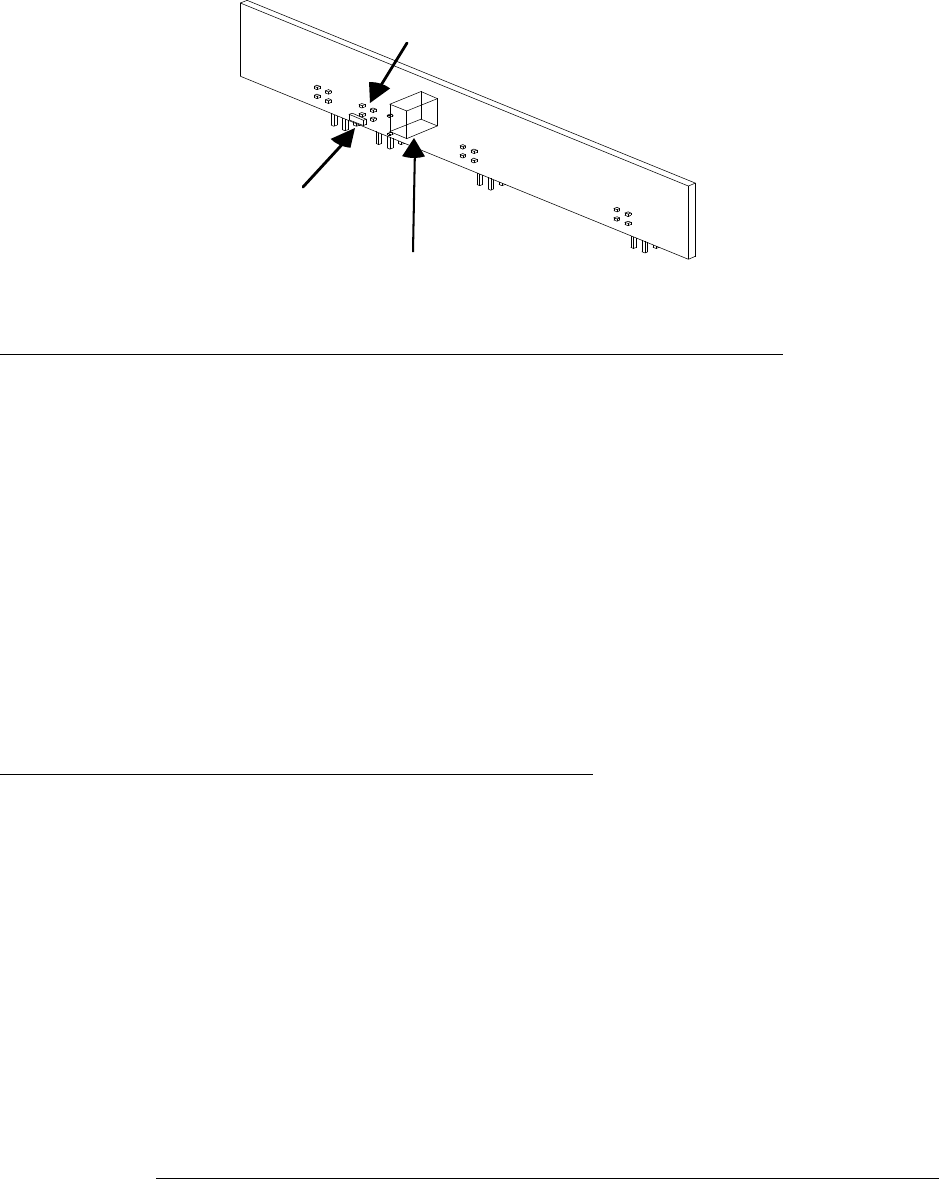
DE DANIELS
ELECTRONICS
Transmitter Main Board Instruction Manual 3-13
input to the transmitter to be used to gain access to the SUBTONE INPUT 2 which
connects to the PHASE MOD IN input of a modified synthesizer.
• Make sure J13 and J16 are not installed.
Figure 3-1 Transmitter Audio Processor Low Frequency Modulation.
REMOVE
R47
REPLACE WITH
10 uF
+
SHORT TOP TWO PINS
MT3TXMNM7
MT-3 Transmitter Audio Processor (board version 43-911914 through 43-911916)
• Install jumpers: JU38Y, JU35Y
• Remove jumpers: JU27X, JU27Y, JU31, JU35X, JU37, JU38X
• Short pins P4-1 and P4-3 (or install J23) together with a short piece of 22 or 24 gauge
solid wire and solder (see figure 3-1). This allows the DIRECT MODULATION input
to the transmitter to be used to gain access to the SUBTONE INPUT 2 which connects to
the PHASE MOD IN input of a modified synthesizer.
Note that the SUBTONE 2 input should not be used while this modification is in effect. Note also
that adjusting R44 has no effect on the deviation of the low frequency signal.
MT-3 Transmitter Audio Processor (board version 43-911918)
• Contact factory for configuration.
3.11.3Synthesizer and Crystal Controlled Oscillator
Refer to the manual for the Oscillator used in your Transmitter for the required Low Frequency
Modulation modifications.

DE DANIELS
ELECTRONICS
3-14 Transmitter Main Board Instruction Manual
3.11.4Tuning the Transmitter
For all MT-3 transmitters, apply a low impedance source of 20-300 Hz to the Direct Modulation
input of the transmitter (Pin Z28 of the 48 pin connector) through a 22 uF capacitor, positive
terminal connected to pin Z28. A Marconi 2955 works well for this test. Adjust R44 on the audio
processor to the fully clockwise position.
• Apply a 100 Hz tone at -8 dBm to the Direct Modulation input of the transmitter (Pin Z28
of the 48 pin connector, and key the transmitter. Adjust the level of the tone until a
deviation of 1.5 kHz is acheived. Note that the level required may be anwhere from -10
dBm to 0 dBm depending on the type of transmitter.
• Confirm that the frequency response rolls off by checking that the following deviations
are observed: (note that the deviation will NOT roll off at 300 Hz if an OC-3 crystal
oscillator is used instead of a synthesizer).
- 20 Hz tone gives about 700 Hz deviation
- 100 Hz tone gives 1.5 kHz deviation
- 300 Hz tone gives about 500 Hz deviation
• Finally, confirm subtone 1 modulation: set-up for 100 Hz Mod with 500 Hz Dev.
- Check 200 Hz Mod, Dev = 1.5 (VHF) / 2.0 kHz (UHF)
- Check 300 Hz Mod, Dev = 1.5 (VHF) / 4.0 kHz (UHF)

DE DANIELS
ELECTRONICS
Transmitter Main Board Instruction Manual 4-1
4 TRANSMITTER INTERCONNECT PIN DEFINITIONS
The MT-3 series Transmitter employs a 48 pin Eurostandard connector for interfacing to all
transmitter power, audio, and control functions. The following are the MT-3 series Transmitter
backplane connections to the M-3 Motherboard.
Pin Name Pin Name Pin Name
D2 No Connect B2 +13.8 Vdc Z2 +13.8 Vdc
D4 No Connect B4 MIC Out Z4 MIC In
D6 No Connect B6 +9.5 Vdc Z6 +9.5 Vdc
D8 No Connect B8 Relay Positive Z8 Relay Negative
D10 No Connect B10 PTT WTO Z10 PTT WTO
D12 No Connect B12 Tx Standby Z12 Tx Standby
D14 No Connect (IMC1) B14 PTT NTO Z14 PTT NTO
D16 No Connect (IMC2) B16 No Connect (MT-2 +9.5V) Z16 No Connect (MT-2 +9.5V)
D18 No Connect (IMC3) B18 Balanced Input 2 Z18 Balanced Input 1
D20 Channel Select 0 (LSB) B20 Squelched,De-emph Audio Z20 Squelched, Flat Audio
D22 Channel Select 1 B22 Subtone Input 1 Z22 Tx Audio Control
D24 Channel Select 2 B24 PTT Output Z24 Subtone Input 2
D26 Channel Select 3 (MSB) B26 Forward Power Sense Z26 Reverse Power Sense
D28 Synth Tx Data (Output) B28 Monitor Out Z28 Direct Mod Input
D30 Synth Rx Data (Input) B30 Ground Z30 Ground
D32 Synth Bootstrap (Input) B32 Ground Z32 Ground

DE DANIELS
ELECTRONICS
4-2 Transmitter Main Board Instruction Manual
This Page Intentionally Left Blank

ELECTRONICS LTD.
DANIELS
TM
MT-3 AM Transmitter Main Board Instruction Manual
5 ILLUSTRATIONS AND SCHEMATIC DIAGRAMS
5.1 Transmitter Block Diagram
5-1

DE DANIELS
ELECTRONICS
Transmitter Main Board Instruction Manual 6-1
6 PARTS LISTS
6.1 Transmitter Main Board Parts List

DE DANIELS
ELECTRONICS
Transmitter Main Board Instruction Manual 7-1
7 REVISION HISTORY
ISSUE DATE REVISION
1 August 97 First Issue.
Sept. 97 Included PCB version 1.4 Component Layout and Schematic diagrams.
2 Dec 97 Main PCB version now 1.7 (ECO 515).
• BCD Switches changed from Surface Mount Part to Through Hole Part.
• Audio Amplifier was removed because this option was never used.
• Added Timer Out Timer circuitry to Main Tx Board.
• TOT PCB no longer installed on Audio Processor.
For
A21-TX3-00 TX MAIN/FP, MT-3, STANDARD
A21-TX3-30 TX MAIN/FP, MT-3, + REF. INPUT
TUBING, TFE-260C,14AWG T/W,CLR 7610-260C14TW
18mm Long and Consummable Buss Wire 16 Awg 40mm Long
NOW NOT INSTALLED
Dec 97 For
A21-TX3-01 TX MAIN/FP, MT-3, WITH FUSE
A21-TX3-02 TX MAIN/FP, MT-3, + DC RELAY
A21-TX3-03 TX MAIN/FP, MT-3, + FUSE,RELAY
• Removed Jumpers J1, J5, J8, J10, J11.
• Added Jumpers J22 - J29, J31 - J35.
• Added Test Points TP28 - TP34
Dec 97 Front Panel Board version now 1.2 (ECO 521).
Modified MT-3 Tx Front Panel Board (FPB) to support all options on the
New Transmitter Main Board . Also, the Front Panel Board is now easier to
configure if new microphones (other than Daniels microphones) are used.
The new FPB can be used on the old TX-3 main - all options will function.
However, the old version of FPB will NOT work with the new version TX-3
Main PCB (unless you hard wire one of the microphone pins into the main
PCB (13.8V line.)
Added J2 SM Jumper. This jumper now selects Rx Audio or 13.8V to Pin
4 of the Microphone. This capability used to be selected by a jumper on the
Main Tx Board. For Normal Opertion J2 'x' position must be installed
Options - This is for future use (not used now). Added 2x4 header land
pattern to Tx Front Panel Board. A 2x4 header can be installed to make
other microphones compatible with Daniels Transmitters.
3 Nov 98 MT-3 FM Audio Processor now version 1.8
The MT-3 FM Audio Processor was re-designed because the IC, XXXXXX,
XXXXX, SO-8 is no longer available from the supplier. Also, the new
design improves the flat and 300Hz Pre-emphasis audio responses.
Included PCB version 1.8 Component Layout, Schematic diagram, Parts List
and Section 2.4, 3.9 and 3.10.

DE DANIELS
ELECTRONICS
7-2 Transmitter Main Board Instruction Manual
ISSUE DATE REVISION
3 Nov 98 Updated the DE logo and added the statuary trademark statement to the title
page. Updated the Low Frequency Modulation section 3.11 to reflect the in
house document A0361-06.

MT-3 RAD
I
O SYSTEMS
Audio Processor
I
nstruction Manual
For AM/FM Transmitters
Covers the following
V 2.2 and V2.3 of the FM Audio Processor Board
used in the VT-3/xxx, UT-3/xxx, VT-3Hxxx and
A22-VAP130 AM Audio Processor Version 04
Copyright © 2000 Daniels Electronics Ltd. All rights reserved. No part of this publication may be reproduced, stored
in a retrieval system or transmitted in any form or by any means, electronic, mechanical, photocopying, recording or
otherwise, without the prior written consent of Daniels Electronics Ltd.
DE™ is a registered trademark of Daniels Electronic Ltd. registered in the U.S. Patent and Trademark Office.
Issue: 2 Previous Issue: 1
Issue Date: November 2000 Previous Issue Date: October 2000 Daniels Electronics Ltd.
Printing Date: January 2001 Victoria, BC.
Part No.: IM20-AP3 PRINTED IN CANADA
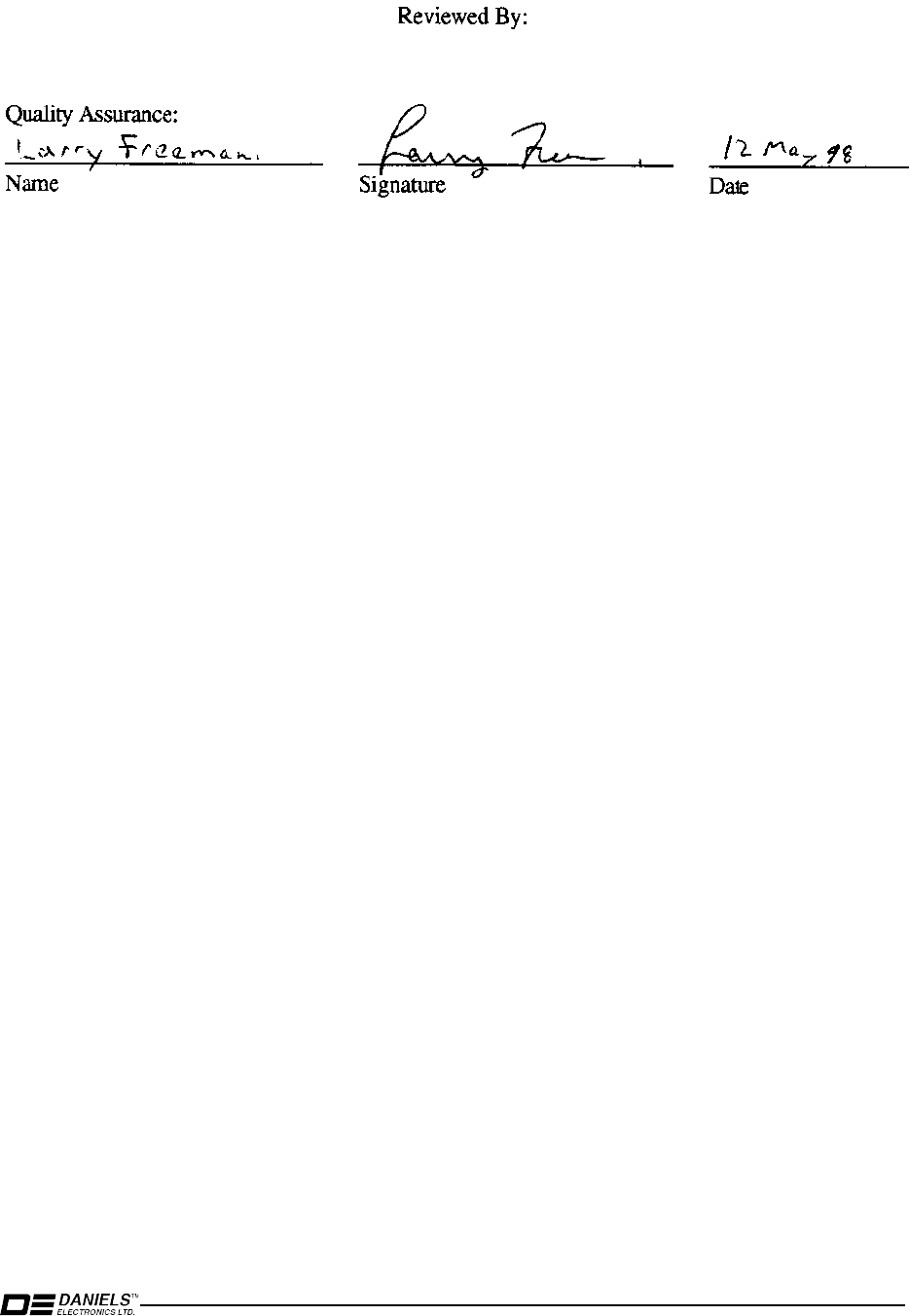
ii Audio Processor Board Instruction Manual
NOTE:
The user's authority to operate this equipment could be revoked through any
changes or modifications not expressly approved by Daniels Electronics Ltd.
The design of this equipment is subject to c
hange
due to continuous
development. This equipment may incorporate minor changes in detail from the
information contained in this manual.

Audio Processor Board Instruction Manual iii
TABLE OF CONTENTS Page
1 FM AUDIO PROCESSOR .............................................................................................1-1
1.1 Introduction ..........................................................................................................1-1
1.2 Block Diagram (FM Audio Processor).................................................................1-3
1.3 FM Audio Processor Board Pin Connections.......................................................1-4
1.4 Factory Configuration...........................................................................................1-4
1.5 Turn-on Time........................................................................................................1-5
1.6 Low Frequency Modulation..................................................................................1-5
1.7 Transmitter Standby Modes..................................................................................1-5
2 SIGNALS.........................................................................................................................2-1
2.1 FM Audio Processor Outputs...............................................................................2-1
2.2 Modulation Output...............................................................................................2-1
2.3 Low Frequency / Direct Mod. Output...................................................................2-1
2.4 Microphone Input.................................................................................................2-1
2.5 Balanced Input......................................................................................................2-1
2.6 Auxiliary Input......................................................................................................2-2
2.7 Subtone Inputs......................................................................................................2-2
2.8 Direct Modulation Input.......................................................................................2-2
3 THEOR
Y
OF OPERATION............................................................................................3-1
4 ALIGNMENT..................................................................................................................4-1
4.1 Standard Deviation Adjustment.............................................................................4-1
4.2 Balanced Input Setup............................................................................................4-1
4.3 Microphone Input Setup.......................................................................................4-1
4.4 Subtone Input Setup .............................................................................................4-2
4.5 Balanced Input Frequency Response....................................................................4-2
5 TROUBLESHOOTING - TEST EQUIPMENT NEEDED ............................................5-1
5.1 Balanced Input Test ..............................................................................................5-1
5.2 Frequency Response Test.....................................................................................5-1
5.3 Subtone Input Test................................................................................................5-2
5.4 Audio benchmarks................................................................................................5-2
6 TEMPERATURE COMPENSATION ............................................................................6-1
7 ILLUSTRATIONS, TABLES AND SCHEMATIC DIAGRAMS ..................................7-1
7.1 Special Jumper Configuration Table.....................................................................7-1
7.2 FM Audio Processor Component Layout.............................................................7-2
7.3 FM Audio Processor Schematic Diagram.............................................................7-3
8 FM AUDIO PROCESSOR PARTS LIST.......................................................................8-1
9 AM AUDIO PROCESSOR.............................................................................................9-5
9.1 Introduction ..........................................................................................................9-5
9.2 Performance Specifications...................................................................................9-5
9.3 Audio Specifications.............................................................................................9-6

iv Audio Processor Board Instruction Manual
9.4 Audio Circuits.......................................................................................................9-6
9.5 Power Requirements.............................................................................................9-6
9.6 Transmitter Standby Modes..................................................................................9-6
9.7 Audio Circuitry.....................................................................................................9-7
9.8 AM Audio Processor Factory Configuration........................................................9-8
9.9 AM Audio Processor Alignment...........................................................................9-8
9.10 AM Audio Processor Electrical Parts List...........................................................9-11
9.11 AM Audio Processor Component Layout...........................................................9-14
9.12 AM Audio Processor Schematic Diagram..........................................................9-15
10 REVISION HISTOR
Y
...................................................................................................10-1
LISTS OF FIGURES
Figure 1 Block Diagram - Audio Processor............................................................... 1-3
Figure 2 Pin Connection Diagram.............................................................................. 1-4
Figure 3 Microphone and Balanced Input Circuitry................................................... 3-1
Figure 4 Limiter and Splatter Filter ............................................................................ 3-2
Figure 5 Bypassing Compression.............................................................................. 3-3
Figure 6 TX Audio Control Circuitry......................................................................... 3-4
LIST OF TABLES
Table 1 Bandwidth Definition................................................................................... 1-1
Table 2 Factory Configuration..................................................................................1-4
Table 3 Turn On Time.............................................................................................. 1-5
Table 4 Mode Condition Table................................................................................. 1-6
Table 5 Standby Mode Selection Table.................................................................... 1-6
Table 6 MT-3 Audio Processor Total Current Consumption.................................... 1-6
Table 7 Operating Current........................................................................................ 5-1
Table 8 Waveform Levels......................................................................................... 5-2
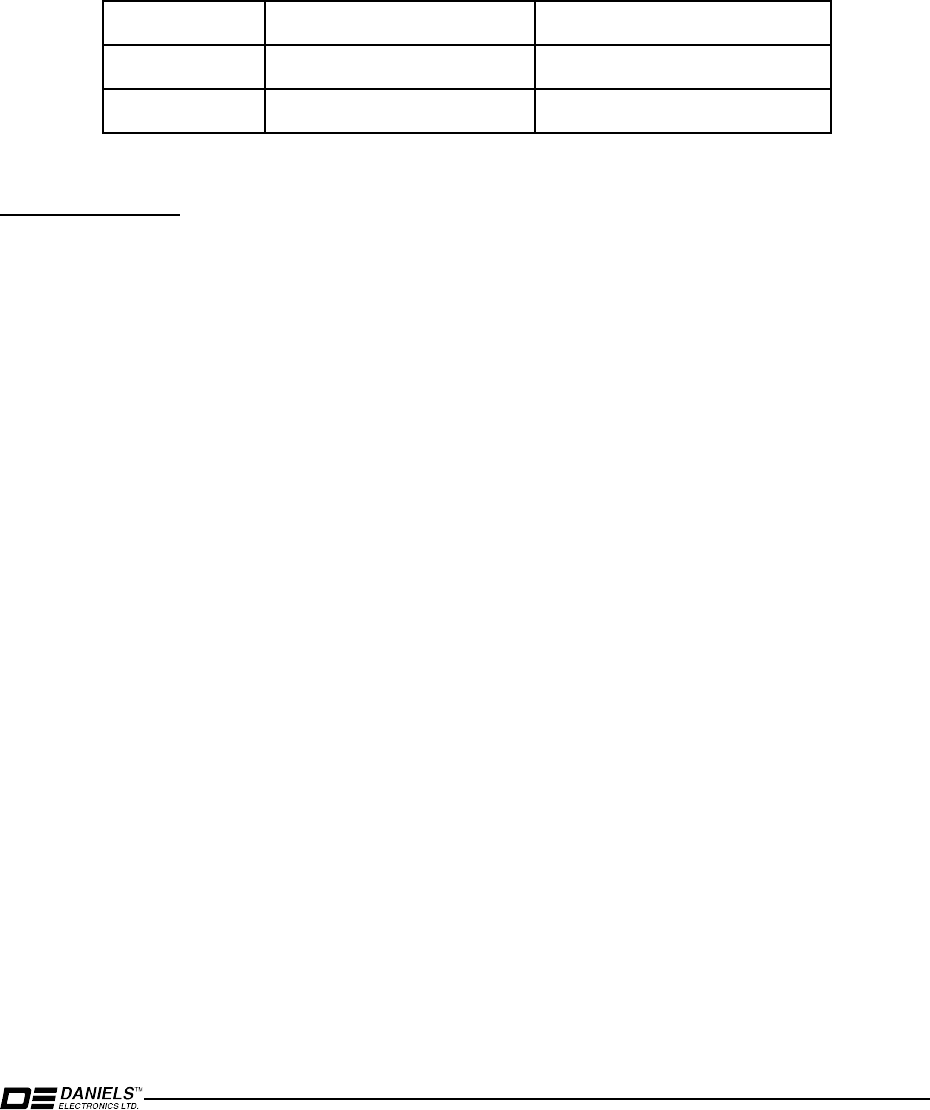
Audio Processor Board Instruction Manual 1-1
1 F
M
A
U
D
I
O PROC
E
SSOR
1.1 Introduction
The MT-3 FM Audio Processor is a versatile circuit board that can provide several types of audio
processing for voice or data transmission.
The following terms are defined:
Table 1 Bandwidth Definition
Term Channel Spacing Rated System Deviation
Wideband 25 kHz or 30 kHz
±
5.00 kHz
Narrowband 12.5 kHz or 15 kHz
±
2.50 kHz
LTR™ is a trademark of E.F. Johnson Co.
Features include:
• Automatic level control using a compression amplifier with a 25 dB dynamic range
• Limiter and Splatter filter that removes noise and harmonics
• Selectable pre-emphasis or flat audio response
• Temperature compensated audio output
• Ability to transmit data and voice switched by a single control line.
• Backwards compatible with Daniels Electronics MT-2 series transmitters.
• Direct modulation input for LTR™, DCS, paging and other digital modulations that
require very low frequency modulation to the synthesizer or crystal oscillator module.
• Separate voice and direct modulation outputs, each individually configurable.
• Multiple jumpers that can be configured to allow maximum flexibility in routing signals
from inputs to outputs, and disabling selected circuits to reduce operating current.
• Dual microphone and balanced audio compression circuits.
• On-board multi-configurable temperature compensation to correct for changes in
transmitter deviation over temperature caused by changing characteristics of synthesizers
and oscillators.
• A single chip 10th Order Linear Phase Lowpass splatter filter for increased cutoff
attenuation responses needed in today
’
s narrow band environment.
• The ability to switch between narrow and wideband through a single control line which
can be externally controlled. This can be useful when configured as a multi-channel
transmitter which uses mixed wide and narrowband frequencies.
• The ability to easily reconfigure fixed operations from narrow to wideband through
simple jumper settings

1-2 Audio Processor Board Instruction Manual
A continuous
+
9.5 VDC supply and a switched
+
8.0 VDC supply are required to power the
module which is normally supplied by the Main Transmitter Board.
The 6 audio inputs on the FM Audio Processor are:
• D
Y
NAMIC MICROPHONE INPUT
• 600 OHM BALANCED INPUT
• subtone inputs
• auxiliary input.
• direct modulation input for data signals.
The Audio Processor's balanced input pins are isolated by a transformer (T1) on the Transmitter
Main Board. Two audio outputs from the MT-3 Audio Processor are routed to the Synthesizer or
Crystal Controlled Oscillator Modules.

Audio Processor Board Instruction Manual 1-3
1.2 Block Diagram (FM Audio Processor)
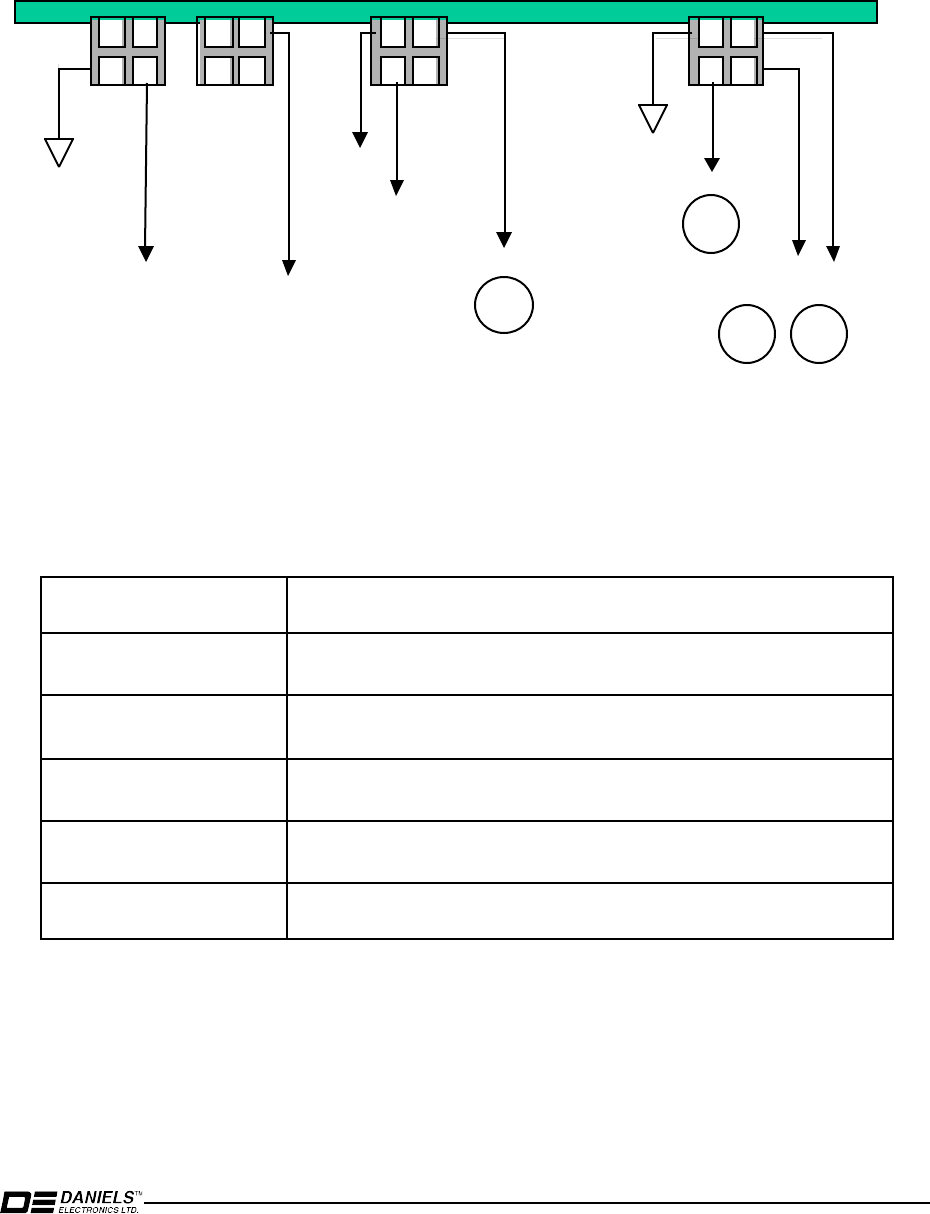
1-4 Audio Processor Board Instruction Manual
1.3 FM Audio Processor Board Pin Connections
Figure 2 Pin Connection Diagram
1.4 Factory Configuration
The MT-3 FM Audio Processor is factory configured as follows:
Table 2 Factory Configuration
Parameter Specification
Maximum Deviation
±
2.5 kHz (Narrowband),
±
5.0 kHz (Wideband).
Microphone Input 1 kHz signal at -10 dBm gives
±
60% rated system deviation
1 kHz signal compression set at
±
84% rated system deviation
Audio Balanced Input
pre-emphasis response
1 kHz tone at -8 dBm gives
±
60% rated system deviation
1 kHz signal compression set at
±
84% rated system deviation
Subtone Input 1 100 Hz tone at -18 dBm gives
±
500 Hz (Wideband)
±
350 Hz (Narrowband) deviation
All other audio inputs Disabled
P
CB
1
2
3
4
1
2
3
4
1
2
3
4
1
2
3
4
P1
P2
P4
P3
Ba
l
an
c
ed Input
E
ND V
IEW
M
i
c Input
S
ubtone Inpu
t 1
+
8V
+
9.5
V
Lo
w Fr
equen
c
y
D
i
r
e
c
t Mod
O
utput
Vo
i
c
e
An
d Subtone
O
utput
-
8
d
B
m
-
10
d
B
m
-
18
d
B
m
Su
r
fa
c
e Mount Side
0
d
B
m
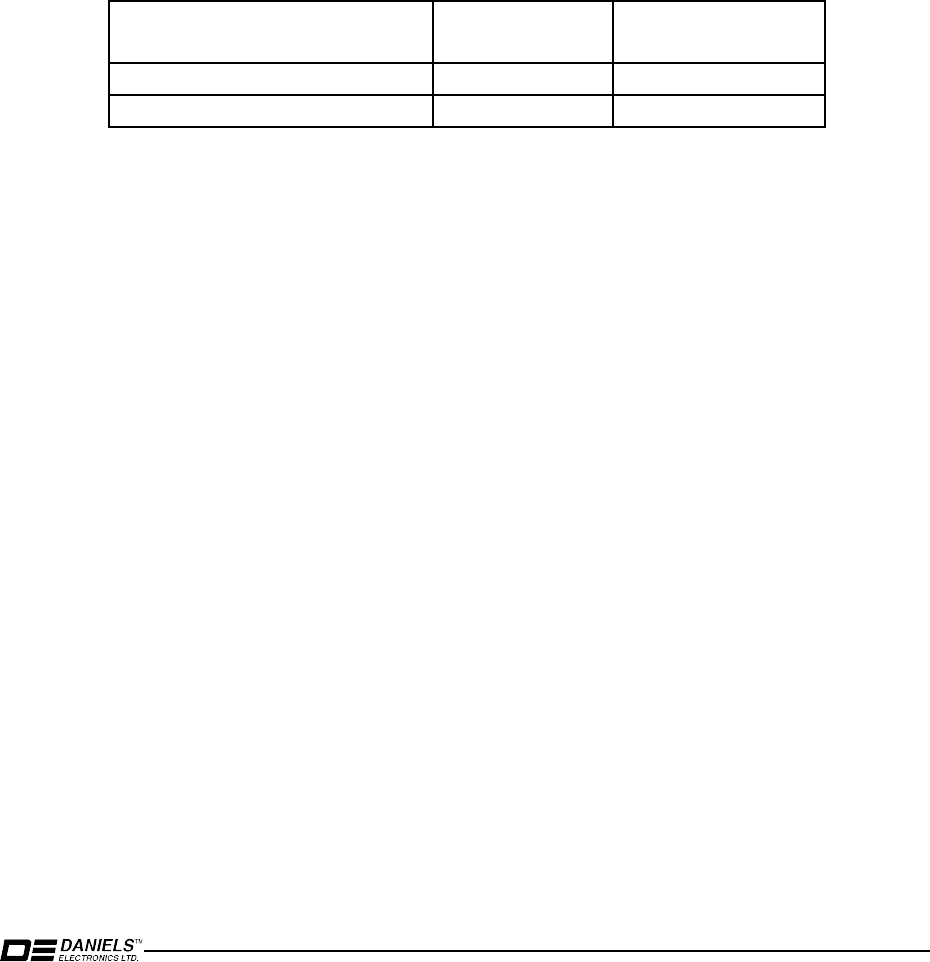
Audio Processor Board Instruction Manual 1-5
1.5 Turn-on Time
This measurement is made with the standard factory settings with a 1 kHz tone applied to the
balanced input. The turn-on time is the time it takes the FM Audio Processor to output a stable
audio signal to P3-1 from the time its power (
+
8.0 VDC) is switched on.
The turn-on time can be virtually eliminated by configuring the FM Audio Processor for
continuous audio standby (see section 1.7 Transmitter Standby Modes). The drawback is that
more current is used to enable the audio circuits to minimize the turn on time. The bulk of the delay
is in the powering of the compression amplifier. For applications that do not use the compression
amplifier, the fast turn on times apply as in the case of data transmission, or audio with no
compression.
Table 3 Turn On Time
Mode Turn on time Audio Processor
Standby Current
Fast turn on – higher current Approx 1mS 15 mA
Current save – slower response Approx 150mS 450uA
1.6
L
ow Frequency Modulation
The transmitter has an additional option to address low frequency user modulation requirements. A
phase modulated bandwidth from 0 (dc) to 100 Hz (PLL loop filter bandwidth) allows specialized
applications such as paging or trunking where a separate low frequency digital/analog modulation
channel is required. Low Frequency Modulation allows external access to the low frequency
modulation capabilities of the synthesizer module. The DIRECT MODULATION inputs on the J1
control connector of the M-3 motherboard will be used (B20 for TX A, and A20 for
TX B). Refer to
“
Data Modulation and Signalling Applications Manual
”
, P/N AM20-DMS for
specific FM Audio Processor configuration methods.
1.7 Transmitter
S
tandby Modes
The MT-3 series transmitters has 8 different standby modes that trade-off standby current
consumption for start-up speed.
Three of these jumpers are on the Transmitter Main Board :
• J6 which always turns on the '
+
9.5 VDC Switched' supply,
• J7 which selects the power source for the MT-3 FM Audio Processor
• J18 which selects the enable line for the OS-3 or OS-3H Synthesizer, or OC-3 Crystal
Controlled Oscillator module.
Additionally, there is a jumper on the FM Audio Processor Board:
• JU36 which determines the power hookup for the dual compression amplifiers
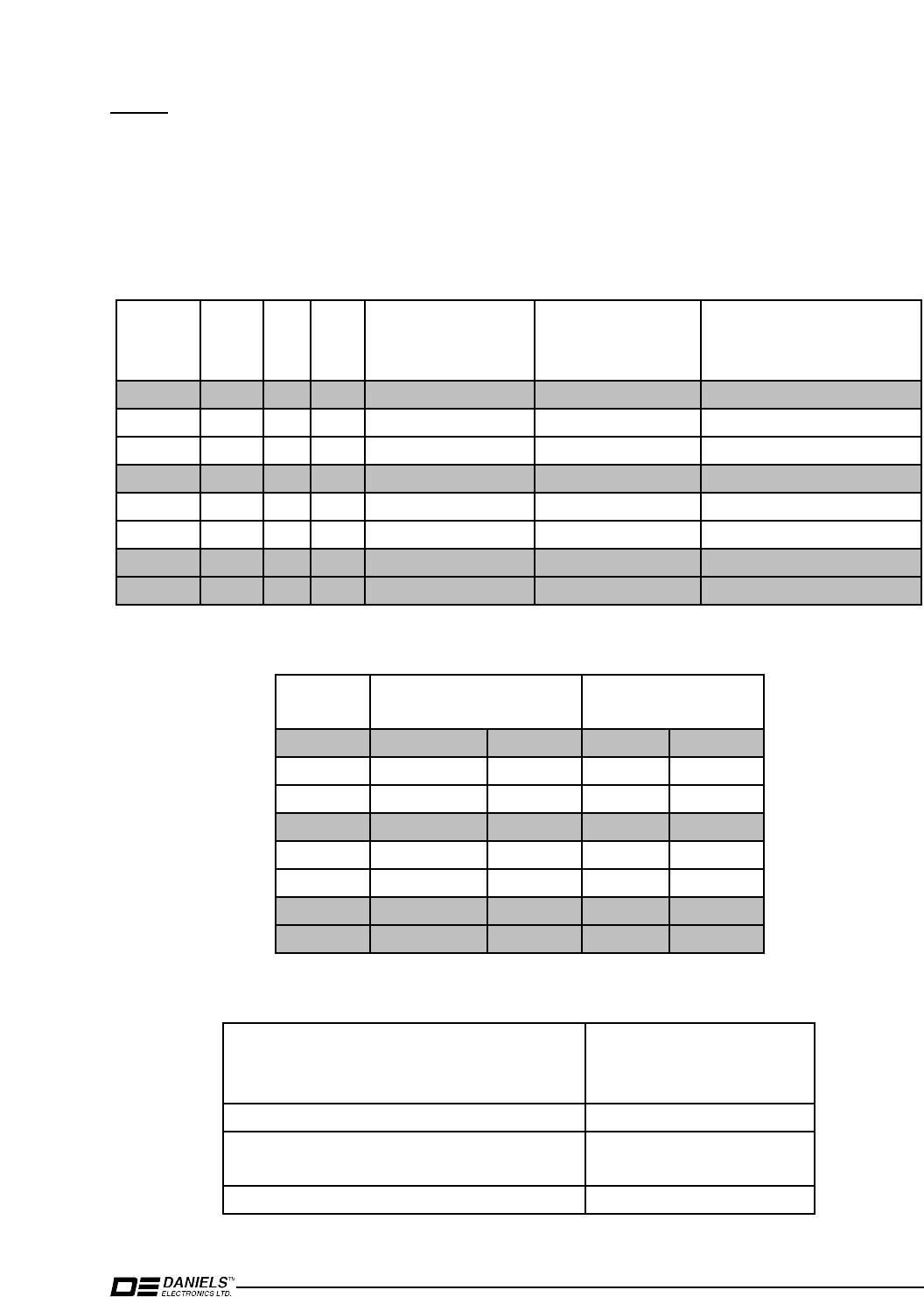
1-6 Audio Processor Board Instruction Manual
Notes:
If FM Audio Processor JU36 is not installed, both microphone and balanced audio compression
amplifiers will be disabled. This means that the front panel microphone jack will be disabled for
local microphone operations. When in this condition, balanced audio is routed around the
compression circuitry via JU11 (installed) with JU1 and JU2 removed.
Table 4 Mode Condition Table
MODE
#J6
J7
J18
Synthesizer/Osc
State Audio
Processor State
(
8V Switched
)
Audio Processor
Compression
JU36
1a
OUT
Y Y
PTT Switched PTT Switched Switched
+
8.0V(X)
1b
OUT
Y Y
PTT Switched PTT Switched Continuous 9.5V(
Y
)
1c
O
UT
Y Y
PTT Switched PTT Switched
Disabled (Not Installed)
2a IN
Y
X Always enabled PTT Switched Switched
+
8.0V (X)
2b IN
Y
X Always enabled PTT Switched Continuous 9.5V (
Y
)
2c IN
Y
X Always enabled PTT Switched
Disabled (Not Installed)
3 IN X
Y
PTT Switched Always enabled Doesn
’
t matter
4 IN X X Always enabled Always enabled Doesn
’
t matter
Table 5 Standby Mode Selection Table
MODE
#Total Xmtr Standby
Current Startup Time
1a 13 mA 6 mA
150 mS
150 mS
1b 22 mA 15 mA 10 mS 10 mS
1c 13 mA 6 mA 10 mS 10 mS
2a 165 mA 25 mA
150 mS
150 mS
2b 174 mA 34 mA 10 mS 10 mS
2c 165 mA 25 mA 10 mS 10 mS
3 27 mA 20 mA 10 mS 10 mS
4 175 mA 34 mA 10 mS 10 mS
Table 6 FM Audio Processor Total Current Consumption.
Compression configuration Audio Processor
Current Draw
keyed / unkeyed
Compression enabled (JU36X) 15 mA/0.45 mA
Compression and microphone disabled
(JU36 Open)
9.2 mA/0.45 mA
Compression enabled (JU36
Y
) 15 mA /9.2 mA

Audio Processor Board Instruction Manual 2-1
2 S
I
G
NALS
The MT-3 FM Audio Processor has six audio inputs, two audio outputs and one audio control
input. Five of the audio inputs are used primarily for voice and tone signals. The sixth, the Direct
modulation input, is used primarily for data signals. The audio control input is used to switch audio
outputs so the transmitter can transmit voice or data.
2.1 FM Audio Processor Outputs
Both the audio outputs, Modulation Output (P3-1) and Low Frequency / Direct Modulation Output
(P4-2), are gated by audio switches U5 and U6 respectively which are controlled by the Transmit
Audio Control Input (P4-4). The audio switches can be operated complimentary to each other so
there can ever only be one source modulating the transmitter. In standard configuration, the
Modulation Output port is used so switch U5 is always on.
2.2 Modulation Output
The Modulation Output port is the output port used by all voice input signals. The voice inputs are
passed to U1A and U1B, a dual programmable compandor which is configured as an automatic
level control amplifier. Op-amp U3A provides the limiting action for the FM Audio Processor.
After the audio signals have been combined limited and buffered, they are filtered by 10th order
Linear Phase Lowpass Filter (U4). The output signal from the filter is then level adjusted by the
deviation control pot, R29, before buffer amplifier U3D.
In special applications, jumper JU6 can be disabled and JU7 enabled, this allows the transmitter to
be modulated directly from the auxiliary input. This should not be done without external filtering
since jumper JU7 bypasses the limiting and filter circuits.
2.3
L
ow Frequency / Direct Mod. Output
The Low Frequency / Direct Modulation Output port has two functions depending on whether the
transmitter is synthesized or crystal controlled. In a synthesized transmitter, this port is used to
modulate the synthesizer reference frequency. The frequency response of this port is typically DC
to 300 Hz. In a crystal controlled transmitter, this port can be used by the Direct Modulation Input
to directly modulate the crystal control oscillator module. The frequency response of this port is
essentially flat from DC to 5 kHz with no limiting or filtering.
2.4 Microphone Input
The microphone input has an automatically level controlled (ALC) preamplifier U1 whose input
level is controlled by R2. The microphone input level control (R2) can accommodate a -25 dBm to
0 dBm input signal. The microphone input is limited and filtered and is output at the standard
modulation output port. The microphone input can have a standard 6dB/octave pre-emphasis
response or a flat-audio response, jumper JU1 at 'y' and 'x' position respectively.
2.5 Balanced Input
The 600 ohm balanced input uses the ALC preamplifier U1B, with input level control pot (R31).
The balanced input level control can accommodate a -25 dBm to 0 dBm input. (install JU17 when

2-2 Audio Processor Board Instruction Manual
using the lower input levels) Like the microphone input, the balance input is limited and filtered and
is output at the standard modulation output port.
If no compression is required (i.e.: customer is providing their own), JU11 can be enabled
providing a path through R48 (Auxiliary Input Level Control) to amplifier U2C where pre-
emphasis or flat audio can then be selected from its output.
2.6 Auxiliary Input
The auxiliary input is a special input and does not have an ALC. This input can be configured for a
pre-emphasis response (enable JU9
Y
) or a flat-audio response (enable JU9X). The level for this
input is set by R48. The auxiliary output is normally summed with the voice signals by op-amp
U3A, limited, then filtered and output at the standard modulation output port. When jumper JU6 is
disabled and jumper JU7 is enabled, the auxiliary input can be used to directly modulate the
transmitter. Care should be taken when directly modulating the transmitter with the auxiliary input
because the MT-3 transmitters use direct FM modulation and there is no filtering or limiting action
provided by the auxiliary input. The input level to the auxiliary input should be -18 dBm and can
be driven by one of three inputs:
• the balanced input – JU11
• the tone/digital input – JU12 X or
Y
enabled
• the direct modulation input – through JU28
When the 600 ohm balanced input is connected to the auxiliary input, the balanced input level
control can be used to adjust the level for the auxiliary input.
2.7
S
ubtone Inputs
There are two subtone inputs available on the FM Audio Processor. Both subtone inputs can be
individually configured to be output from the standard Modulation Output port or to be output from
the Low Frequency / Direct Modulation Output. In standard configuration, Subtone 1 is summed
with the voice signals to be output from the standard Modulation Output port while Subtone 2 is
used for DCS. Both subtone inputs have an input level control.
2.8 Direct Modulation Input
The Direct Modulation Input is an extremely versatile input. This port is designed to be used for
data signals. Depending on the application, the signal can be amplified, AC or DC coupled and
output to the Modulation Output or the Low Frequency / Direct Modulation Output port. Please
consult the factory for specific jumper settings for your application.

Audio Processor Board Instruction Manual 3-1
3 T
H
E
OR
Y
OF OP
E
RAT
I
ON

Audio Processor Board Instruction Manual 4-1
4 AL
I
G
N
M
E
NT
Verify the standard factory settings for the MT-3 FM Audio Processor as given in section 1 before
beginning the standard deviation adjustment procedure. If the transmitter's operating frequency is
changed beyond the factory recommended bandwidth or if the synthesizer is changed, the FM
Audio Processor should be realigned to optimize the transmitter's performance. The schematic
diagram for the FM Audio Processor is shown in section 7-2 of this manual.
The settings tolerance is
+
/- 0.1 kHz.
4.1
S
tandard Deviation Adjustment
Set up the Communications Analyzer :
-Audio filter to LOW PASS 15 or 20 kHz
-To monitor transmit frequency and audio deviation level.
4.2 Balanced Input
S
etup
1 Connect audio generator output to the BALANCED INPUT (Transmitter
Main Board edge connector pins B18, Z18).
2 Preset R31 (BALANCED INPUT LEVEL CONTROL)
R38 (COMPRESSION CONTROL)
R29 (DEVIATION CONTROL)
all maximum clockwise
3 Set audio generator to 2.4 kHz at 0 dBm.
4 Adjust R29 for
±
4.8 kHz (Wideband) or
±
2.4 kHz (Narrowband).
5 Set audio generator to 1 kHz at 0dBm
6 Set R38 for
±
4.2 kHz (Wideband) or
±
2.1 kHz (Narrowband).
7 Repeat steps c) to f) (slight interaction)
8 Set audio generator to 1 kHz at –8 dBm
9 Adjust R31 for
±
3.0 kHz (Wideband) or
±
1.5 kHz (Narrowband).
10 Set audio generator to 1 kHz at –18 dBm
11 Ensure deviation is at
±
1.0 kHz (Wideband) or
±
0.5 kHz (Narrowband).
12 Set audio generator to 1 kHz at –8 dBm. Set Communications Analyzer Audio
Filter to BANDPASS 300-3400 Hz. Activate distortion analyzer. Confirm that
the distortion is within specification.
4.3 Microphone Input
S
etup
1. Set R2 fully clockwise
2. Apply a 1 kHz tone at 0 dBm to the microphone audio input (PIN 1 on the front
panel connector. Pin 2 is ground). Set R63 (MICROPHONE
COMPRESSION for
±
4.2 kHz (Wideband) or
±
2.1 kHz (Narrowband).
3. Reduce the audio generator level to –10 dBm. Adjust R2 (MICROPHONE
INPUT LEVEL) for
±
3.0 kHz (Wideband) or
±
1.5 kHz (Narrowband).

4-2 Audio Processor Board Instruction Manual
4.4
S
ubtone Input
S
etup
• Apply a 100 Hz tone at -18 dBm to the subtone 1 input .
• Adjust R42 (SUBTONE INPUT 1) to produce:
•
±
500 Hz(Wideband) or
±
350 Hz(Narrowband) deviation.
• Remove the signal.
4.5 Balanced Input Frequency Response
• Apply a 1 kHz tone at –18 dBm to the BALANCED INPUT (Transmitter Main
Board edge connector pins B18, Z18).
• Record deviation and use this level as the 0 dB reference.
• Sweep frequency from 100 Hz to 5 kHz.
• The audio response should be within
+
/- 1dB from 300 Hz to 2500 Hz.
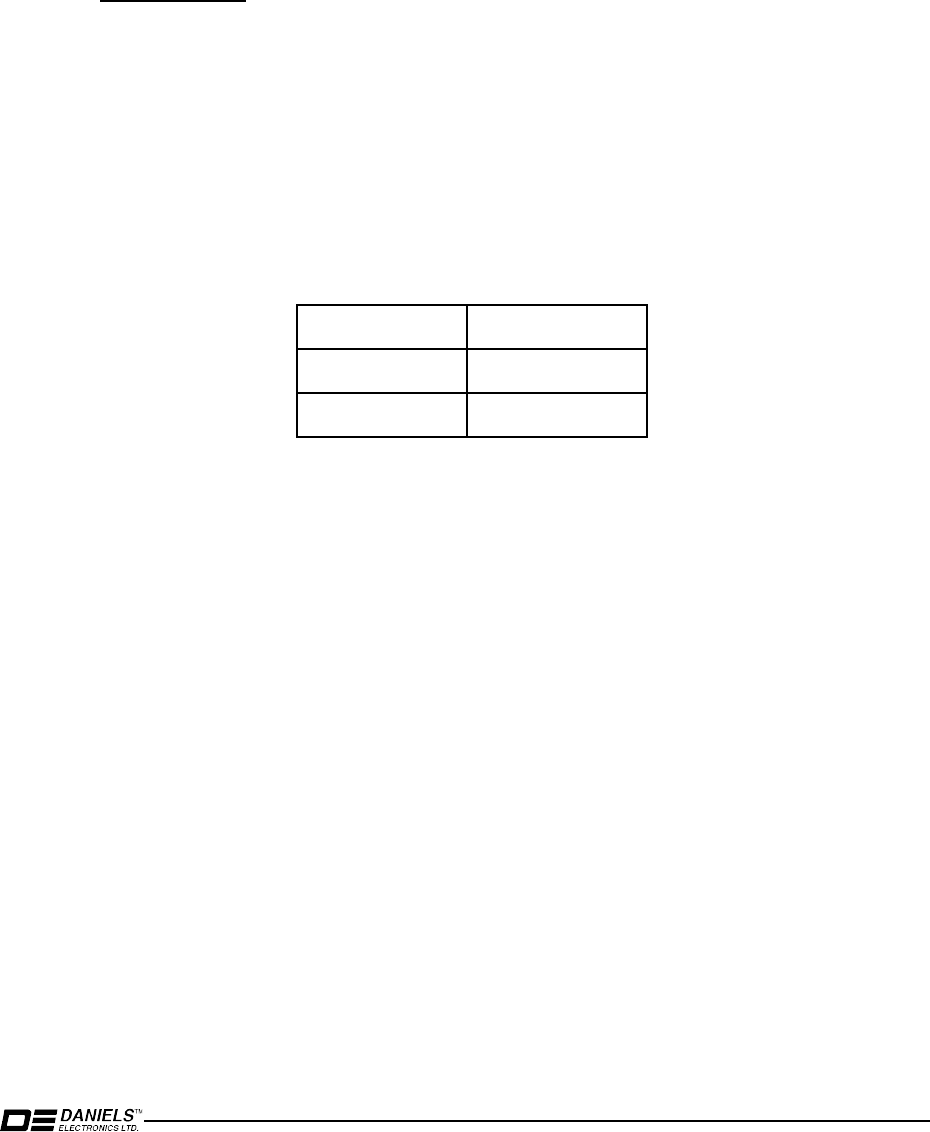
Audio Processor Board Instruction Manual 5-1
5 TRO
U
BL
E
S
H
OOT
I
N
G
- T
E
ST
E
Q
U
I
P
M
E
NT N
EE
D
E
D
1 Variable Power supply/supplies to supply 9.6V and 8.0V at the same time.
2 Digital Voltmeter to measure RMS AC Volts, DC Volts, DC Current and resistance.
3 20 MHz Oscilloscope, single channel.
4 Audio Signal Generator (600 Ohm Output Impedance) capable of frrequencies from
67 Hz to 5000 Hz.
Power Supply
• Connect a regulated power supply with
+
9.5V as follows:
Positive to P2-4
Negative to P1-4 (Ground)
• Connect a regulated power supply with
+
8.0V as follows:
Positive to P2-3
Negative to P1-4 (Ground)
• Measure total current from both power line inputs:
Table 7 Operating Current
Voltage Input
Current
(
mA
)
8.0V 15.7
9.5V 0.47
5.1 Balanced Input Test
Connect an Audio Generator set for a 2.4 kHz tone @ 0 dBm (775 mV RMS) output to the
Balanced Input (P1-1 and P1-2). Refer to Table 8 Waveform Levels for measurement points,
levels and waveforms that should be present.
Change Audio Generator settings for a 1 kHz tone @ -8 dBm (309 mV RMS) output. Refer to
Table 8 Waveform Levels for levels and waveforms that should be present.
5.2 Frequency Response Test
Reduce Audio Generator level to –18 dBm (98 mV RMS). Step frequency to 500, 1000, 2000 and
3000 Hz. Ensure that the results conform to the 6dB/octave
+
/- 1 dB from 300 Hz to 2500 Hz
referenced to 1000 Hz. Measurements are made at JU8 with respect to ground.
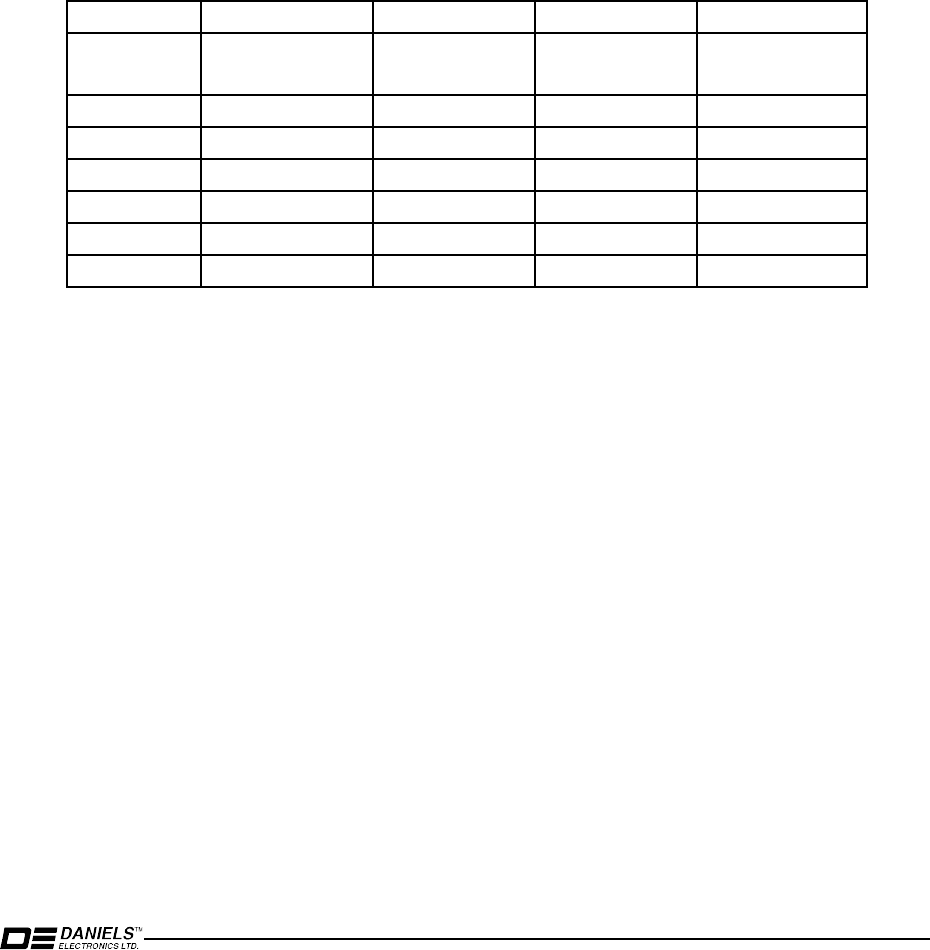
5-2 Audio Processor Board Instruction Manual
5.3
S
ubtone Input Test
Change Audio Generator frequency to 100 Hz and maintain level at –18 dBm (98 mV RMS).
Connect output to Subtone Input 1 (P2-2) and ground (P1-4). Refer to Table 8 Waveform
Levels, for levels and waveforms that should be present.
5.4 Audio benchmarks
Set the audio generator to 2.4 kHz @ 0 dBm at the Balanced Input. Compare the waveform levels
with those listed in table below.
Repeat for the various audio frequencies and levels and compare with the levels in the table below.
Table 8 Waveform Levels
Limiting Test
Std Level Mic Test Subtone
Measured
@
2.4kHz
@0dBm
1 kHz @
-8dBm
1 kHz @
-10 dBm
100 Hz @
-18 dBm
TP3 5.2V P-P 3.8V P-P N/A N/A
TP12 N/A N/A 3.8V P-P N/A
TP10 6.5V P-P 4.9V P-P 4.8V P-P 1.1V P-P
TP5 2.4V P-P 1.3V P-P 1.9V P-P 0.4V P-P
JU6 5.5V P-P 1.7V P-P 1.8V P-P 0.4V P-P
TP8 1.5V 0.9V P-P 0.9V P-P 0.2V P-P

Audio Processor Board Instruction Manual 6-1
6 T
E
M
P
E
RAT
U
R
E
CO
M
P
E
NSAT
I
ON
The FM Audio Processor includes temperature compensation circuitry to maintain constant
transmitter audio deviation with a fixed level input signal. It is capable of not only compensating for
temperature related level variations within the FM Audio Processor (typically –0.3 to –0.5 dB at
–40C) but can also compensate for changes caused by the synthesizer or crystal oscillator module
that is not equipped with its own temperature compensation.
The factory specification is as follows:
Wideband
When a 2.4 kHz tone is applied at a level of –8dBm to the balanced input of the transmitter, the
transmitter deviation shall be
±
4.8 kHz at room temperature and can vary from
±
4.5 kHz to
±
5.0 kHz from -40ºC to
+
60ºC.
Narrowband
When a 2.4 kHz tone is applied at a level of –8 dBm to the balanced input of the transmitter, the
transmitter deviation shall be
±
2.4 kHz at room temperature and can vary from
±
2.25 kHz to
±
2.5 kHz from -40ºC to
+
60ºC.
Since the specifications of the components used in the synthesizer or oscillator may change over
time, changes to the temperature compensation circuit may be necessary even for the same type of
equipment.
Contact the factory for more information on values used.

6-2 Audio Processor Board Instruction Manual
This Page Intentionally Left Blank

ELECTRONICS LTD.
DANIELS TM
Audio Processor Board Instruction Manual 7-1
7 ILLUSTRATIONS, TABLES AND SCHEMATIC DIAGRAMS
7.1 Special Jumper Configuration Table

Audio Processor Board Instruction Manual 8-1
8 F
M
A
U
D
I
O PROC
E
SSOR PARTS L
I
ST

Audio Processor Board Instruction Manual 9-5
9 A
M
A
U
D
I
O PROC
E
SSOR
9.1 Introduction
The MT-3 AM Transmitter Main Board integrates the MT-3 Front Panel Board, MT-3 AM
Audio Processor, Synthesizer or Crystal Control module and Amplifier module together to make
a working MT-3 AM series transmitter. The Front Panel Board and the Audio Processor are
soldered directly to the Transmitter Main Board while the Amplifier and the Synthesizer or
Crystal Control module are frequency band sensitive, plug-in modules. Circuitry and jumpers on
the Transmitter Main Board control the operation of the modules as well as the overall operation
of the MT-3 transmitter. Power and signal connections are made to the 48 pin type 'F' connector
on the rear of the Transmitter Main Board and are routed to the other modules. The front and
rear back plates are attached to the Transmitter Main Board and together with the extruded
aluminum shell, as discussed in the assembly section of the Transmitter Manual, form the
transmitter enclosure.
9.2 Performance
S
pecifications
Type: MT-3 AM Series Transmitter
Compatibility: VT-3A Series Amplifier, OCT-3 Crystal Oscillator, OST-3
Frequency Synthesizer.
Modulation: 6K00A3 (Amplitude Modulation)
Operating Temperature Range: -30˚C to
+
60˚C, optional - 40˚C temperature test.
Operating Humidity: 95% RH (non-condensing) at
+
25°C.
Operating Voltage:
+
13.8Vdc ,
+
9.5 Vdc Regulated.
Front Panel Control: One 3 position switch
• NORM (repeat mode)
• OFF
• KE
Y
TX
PTT Activation: • Active to ground with or without time-out-timer;
• Microphone activated with or without time-out-timer;
• Front Panel switch: KE
Y
TX - without time-out-timer;
• NORM - with or without time-out-timer.
• Isolated (optional relay) with or without time-out-timer.
PTT Time-Out-Timer: Selectable from 1 sec. to 8 hrs. (factory set 5 min.).

9-6
9.3 Audio
S
pecifications
Audio Input: -30 to 0 dBm into a 600Ω balanced load.
Audio Response: Flat audio;
+
1/-3 dB: 300 Hz - 3 kHz
Audio Distortion: Less than 3% -40˚C to
+
60˚C at 30% modulation,
Less than 5% -40˚C to
+
60˚C at 90% modulation
9.4 Audio Circuits
All of the audio signal conditioning (e.g. limiting, filtering) is performed by the MT-3 AM Audio
Processor. The transmitter board routes the audio lines from the backplane connector to the
audio processor. The audio lines routed to the audio processor are: a 600 ohm balanced input
(pins B18 and Z18), and a MIC AUDIO from the MT-3 FRONT PANEL BOARD. It is here
that the MIC audio is processed in the same manner as the 600 ohm balanced audio. The audio
processor's balanced input pins are isolated from pins B18 and Z18 by a transformer (T1). Two
audio outputs from the MT-3 AM Audio Processor are routed to the VT-3A130 Amplifier.
The MT-3 AM Audio Processor is a versatile circuitboard that can provide several types of audio
processing. The module also has an on-board programmable push-to-talk (PTT) time-out-timer
(TOT) on an attached circuitboard. A continuous
+
9.5 Vdc supply and a continuous
+
13.8 Vdc
supply together with a switched
+
8.0 Vdc supply are required to power the module. Refer to
section 9.11 "MT-3 AM Audio Processor Component Layout" and to section 9.12 "MT-3 AM
Audio Processor Schematic Diagram" for component location and designation references.
9.5 Power Requirements
The audio processor can be configured for continuous audio standby or for switched audio
standby by the Transmitter Main Board. If fast audio risetime is desired, the transmitter should
be operated in standby mode 3 or 4 as specified below. The current for the associated TOT is
approximately 4 mA when the transmitter is keyed.
9.6 Transmitter
S
tandby Modes
The VT-3A130 Transmitter has four different standby modes that trade-off standby current
consumption for start-up speed. The standby modes are determined by three jumpers: jumper J6
which always turns on the '
+
9.5 Vdc Switched' supply, jumper J7 which selects the power source
for the MT-3 AM Audio Processor and jumper J18 which selects the enable line for the OST-
3A128 Synthesizer Module.

Audio Processor Board Instruction Manual 9-7
The actual current and start-up time may depend on the frequncy controlled source (crystal or
synthesizer) and amplifier module. The current and start-up times given below are representative
values intended only as a guideline.
MODE 1:Jumper J6 out
- the audio processor is switched by a PTT signal
- the synthesizer is switched by a PTT signal
- standby current typically 13 mA
- start-up time typically 40 ms
MODE 2:Jumper J6 in, jumper J7 in the 'y' position, jumper J18 in the 'x' position
- the audio processor is switched by a PTT signal
- the synthesizer is enabled all of the time
- standby current not used in this mode
- start-up time not used in this mode
MODE 3:Jumper J6 in, jumper J7 in the 'x' position, jumper J18 in the 'y' position
- the audio processor is enabled all of the time
- the synthesizer is switched by a PTT signal
- standby current typically 19 mA
- start-up time typically 40 ms
MODE 4:Jumper J6 in, jumper J7 in the 'x' position, jumper J18 in the 'x' position
- the audio processor is enabled all of the time
-the synthesizer is enabled all of the time
-standby current typically 163 mA
-start-up time typically 12 ms
9.7 Audio Circuitry
The MT-3 AM Tx Audio Processor refer to section 9.12 "MT-3 AM Audio Processor
Schematic Diagram" has two audio inputs (Microphone input and Balanced input) which can be
used to modulate the transmitter. The input signals are combined by R2 and R17 at a
compandor U1. U1b controls the input level and makes gain inversely proportional to the input
level (say a 20 dB drop in input level will produced a 20 dB increase in gain). The output will
remain fixed at a constant level without clipping and distortion. (Automatic Level Control) The
input signals are adjusted by the pots R1, R16. The variable gain cell in U1a is used as a voltage-
controlled amplifier so that if the power supply (13.8Vdc) has changed the output level will
change in order to keep the modulation of the RF output signal at the same level. The gain
control can be adjust by the pot R4. (Automatic Modulation Control) The audio signal then
amplifies and filters at U2. The output signal is adjusted by the pot R14.

9-8
9.8 AM Audio Processor Factory Configuration
The MT-3 AM Transmitter Audio Processor is factory configured as follows:
• Microphone Input: 1kHz tone at -10 dBm gives 50% maximum
modulations.
• Audio Balanced Input: 1 kHz tone at -8 dBm gives 90% maximum
modulations.
• Automatic Modulation Control enabled
• Automatic Level Control enabled
The corresponding jumper settings are:
• Jumper JU1: 'x' position Automatic Modulation Control disabled
• Jumper JU2: not installed Modulation configuration
• Jumper JU3: 'y' position Automatic Level Control enabled
• Jumper JU4: not installed Time-out-time power supply (optional)
• Jumper JU5: 'y' position Voice application
• Jumper JU6: 'y' position Voice application
• Jumper JU7: not installed Modulation configuration
• Jumper JU8: 'y' position Automatic Level Control enabled
• Jumper JU9: installed Power AMC and Microphone enabled
9.9 AM Audio Processor Alignment
Verify the standard factory settings for the MT-3 AM Audio Processor as given in section 9.8
before beginning the standard modulation adjustment procedure. If the transmitter's channel
frequency changes, the audio processor should be realigned to optimize the transmitter's
performance. The schematic diagram for the audio processor is shown in section 9.12 and the
component layout is shown in section 9.11.
*Note: clockwise rotation of controls increases signal levels
1 Before adjusting the audio board, confirm that the transmitter frequency is correct.
2 Unscrew and slide out the case of the transmitter. Locate the Tx Audio Board.
3 Connect the transmitter RF Output to a Radio communications test set.
4 Connect the 600 ohm input to the incoming audio (pins B18, Z18). Set the audio
frequency to 1 kHz at the desired level of -8 dBm.
5 Turn the transmitter on.
6 Adjust the pot R16, in order to achieve about 0.700 Vrms at TP4.
7 Adjust the pot R14, in order to achieve about 0.200 Vrms at TP8.
8 Tune the Audio Adjust pot R35 on the Power Amplifier board to obtain 90% modulation.
9 Apply a 1 kHz, -20 dBm input signal and adjust the pot R16 in order to obtain 30%
modulation.

Audio Processor Board Instruction Manual 9-9
10 Apply a 1 kHz, -8 dBm input signal, the modulation should be 90%, observe that the
distortion of the transmitted signal is within 5.0%.
11 Slowly increase the input audio signal level to 5 dBm and observe that the modulation
does not go over 100%. This step verifies the correct operation of the ALC .
12 Change 13.8Vdc power supply to 10V and then to 17V, the modulation of the output RF
signal should remain at the same level of 90%
±
7% and distortion should be less then
3%. This step verifies the correct operation of the power regulator on the transmitter
amplifier board.
13 Repeat steps 7 and 9 if required.
14 Supply a 1 kHz, -10 dBm signal to the microphone input. (Note the level restriction of -
25 dBm to 0 dBm.)
15 Adjust the Microphone Input Level Adjust pot (R1) to achieve 50% of RF signal
modulation. Observe that the distortion should be under 5%.
16 Turn off the transmitter. Remove the signal source and replace all the screws.

9-10
This Page Intentionally Left Blank

Audio Processor Board Instruction Manual 10-1
10 R
E
V
I
S
I
ON
H
I
STOR
Y
ISSUE DATE REVISION
1 Oct 2000 First Issue.
2 Nov 2000 Second Issue
Incorporated the AM Audio Processor documentation into this manual.
For specific AM revision history, see manual IM22-MT3AMTXMN-4IM

10-2 Audio Processor Board Instruction Manual
This Page Intentionally Left Blank
DANIELS
ELECTRONICS LTD. ®
MT-3 RADIO SYSTEMS
UHF AMPLIFIER
INSTRUCTION MANUAL
UT-3
406 - 512 MHz
Covers models:
UT-3/400 Amplifier
Copyright © 1998 Daniels Electronics Ltd. All rights reserved. No part of this publication may be
reproduced, stored in a retrieval system or transmitted in any form or by any means, electronic,
mechanical, photocopying, recording or otherwise, without the prior written consent of Daniels
Electronics Ltd.
Issue: 1 Previous Issue: N/A
Issue Date: May 98 Previous Issue Date: N/A Daniels Electronics Ltd.
Printing Date: May 98 Victoria, B.C.
Part No.: IM23-UT3400AMP PRINTED IN CANADA

DE DANIELS
ELECTRONICS
ii UHF Amplifier Instruction Manual UT-3 406 - 512 MHz
Reviewed By:
Quality Assurance:
_________________
Name Signature Date
NOTE:
The user's authority to operate this equipment could be revoked through any
changes or modifications not expressly approved by Daniels Electronics Ltd.
The design of this equipment is subject to change due to continuous
development. This equipment may incorporate minor changes in detail from the
information contained in this manual.

DE DANIELS
ELECTRONICS
UHF Amplifier Instruction Manual UT-3 406 - 512 MHz iii
TABLE OF CONTENTS
Page
1 GENERAL.................................................................................................................... 1-1
1.1 Introduction....................................................................................................... 1-1
1.2 Performance Specification................................................................................. 1-1
2 THEORY OF OPERATION ........................................................................................ 2-1
2.1 Amplifier Operation .......................................................................................... 2-1
2.2 Power Requirements ......................................................................................... 2-2
2.3 RF Circuitry...................................................................................................... 2-2
2.3.1 UT-3/400 Lowpass Filter...................................................................... 2-2
2.4 Power Control Circuitry.................................................................................... 2-3
2.5 Power Sensing Circuitry ................................................................................... 2-3
2.5.1 Output Power Sense.............................................................................. 2-3
2.5.2 VSWR Sense........................................................................................ 2-4
2.5.3 VSWR Overload................................................................................... 2-4
3 UT-3/400 AMPLIFIER ALIGNMENT........................................................................ 3-1
3.1 General.............................................................................................................. 3-1
3.2 Repair Note....................................................................................................... 3-1
3.3 Recommended Test Equipment List.................................................................. 3-1
3.4 Printed Circuitboard Numbering Convention.................................................... 3-2
3.5 Standard Factory Settings and Jumper Configuration....................................... 3-2
3.6 UT-3/400 Amplifier Alignment......................................................................... 3-2
3.6.1 General.................................................................................................. 3-2
3.6.2 UT-3/400 Amplifier Adjustment ........................................................... 3-3
3.6.2.1 General Set-Up ......................................................................... 3-3
3.6.2.2 Output Power Alarm (Forward Power) ..................................... 3-4
3.6.2.3 Output Power............................................................................ 3-5
3.6.2.4 Antenna VSWR Alarm (Reverse Power)................................... 3-5
3.6.2.5 Antenna VSWR Overload......................................................... 3-6
3.6.2.6 Procedure Verification............................................................... 3-6
4 ILLUSTRATIONS AND SCHEMATIC DIAGRAMS............................................... 4-1
4.1 UT-3/400 UHF Amplifier Component Layout.................................................. 4-2
4.2 UT-3/400 UHF Amplifier Schematic Diagram ................................................. 4-3
4.3 UT-3/400 UHF Lowpass Filter Component Layout ......................................... 4-5
4.4 UT-3/400 UHF Lowpass Filter Schematic Diagram......................................... 4-5

DE DANIELS
ELECTRONICS
iv UHF Amplifier Instruction Manual UT-3 406 - 512 MHz
5 PARTS LISTS.............................................................................................................. 5-1
5.1 UT-3/400 UHF Amplifier Electrical Parts List.................................................. 5-1
5.2 UT-3/400 UHF Amplifier Mechanical Parts List.............................................. 5-4
5.3 UT-3/400 UHF Low Pass Filter Electrical Parts List........................................ 5-4
6 REVISION HISTORY ................................................................................................. 6-1

DE DANIELS
ELECTRONICS
UHF Amplifier Instruction Manual UT-3 406 - 512 MHz 1-1
1 GENERAL
1.1 Introduction
The UT-3/400 Amplifier provides the final stage of RF amplification and filtering for the entire
UHF Transmitter UT-3 406 -512 MHz family. The amplifier has four distinct frequency ranges:
406 to 430 MHz, 450 to 470 MHz, 470 to 490 MHz and 490 to 512 MHz as well as two distinct
output power ranges: 0.5 to 2.0 Watts and 2.0 to 8.0 Watts. The UT-3/400 Amplifier is housed in
a machined aluminum case that ensures optimum RF shielding, provides a good ground, and also
acts as a heatsink.
Additionally, the UT-3/400 Amplifier is equipped with output power and VSWR sensing lines
which can be individually configured as open collector or linear outputs. The internal VSWR
sensor protects the amplifier from high antenna VSWR by approximately halving the amplifier's
RF gain when a VSWR overload condition is present.
Output filtering for the UT-3/400 Amplifier is provided by the UT-3/400 Lowpass Filter Board.
The lowpass filter assembly is mounted in a separate compartment of the amplifier case in order to
provided maximum attenuation of harmonic and other spurious signals.
Refer to Section 4 for the UT-3 406 - 512 MHz UHF amplifier and lowpass filter component
layouts and schematic diagrams
1.2 Performance Specification
Type: MT-3 series UHF Amplifier module.
Compatibility: MT-3 series Transmitter Main Board.
Frequency Range: 406 to 430 MHz, 450 to 470 MHz, 470 to 490 MHz or
490 to 512 MHz.
RF Power Output: adjustable 0.5 to 2.0 Watts or 2.0 to 8.0 Watts
RF power Input: nominal level adjustable from +4 dBm to +10 dBm,
held within +/- 2 dB of nominal.
Ouput Impedance and VSWR: 50 Ω, Type N connector; 3:1 max. VSWR.
Input /Output Isolation: > 60 dB
Duty Cycle: 100%: Continuous operation from -40˚ C to +60˚C.

DE DANIELS
ELECTRONICS
1-2 UHF Amplifier Instruction Manual UT-3 406 - 512 MHz
Harmonic Emissions: Less than -80 dBc .
Transmitter Mismatch Protection: 20:1 VSWR at all phase angles.
Transmitter Alarm: Forward power sense and reverse VSWR;
- open collector output (separate or 'OR'ed configuration);
-linear output (separate lines only).
Operating Temperature Range: -30˚ C to +60˚ C, optional -40˚ C temperature test.
Operating Humidity: 95% RH (non-condensing) at +25˚ C.
Operating Voltage: +13.8 Vdc Nominal (range +11 to +16 Vdc),
+9.5 Vdc Regulated.
Transmit Current: 0.7 Amp typical; 1.1 Amp maximum
Amplifier Standby Current: less than 0.5 mA.
Amplifier Enable: Active to ground.
Amplifier Enable Response: typically overdamped, rising to within 90% of full power
within 5 msec; maximum (underdamped) overshoot of 30%.

DE DANIELS
ELECTRONICS
UHF Amplifier Instruction Manual UT-3 406 - 512 MHz 2-1
2 THEORY OF OPERATION
2.1 Amplifier Operation

DE DANIELS
ELECTRONICS
UHF Amplifier Instruction Manual UT-3 406 - 512 MHz 3-1
3 UT-3/400 AMPLIFIER ALIGNMENT
3.1 General
Connections to the power supply, alarm and transmit enable lines (ENA), are clearly marked on the
amplifier case. The amplifier is enabled when the enable line (ENA) is grounded.
If the amplifier is installed in the transmitter, alignment is simplified by using an SR-3 Subrack,
SM-3 System Monitor, and RF extender cable to provide transmitter power and signal
interconnection (see the Transmitter Main Board Manual for details). For complete transmitter
alignment, the Transmitter Main Board, Synthesizer, Amplifier, and Audio Processor should be
tuned in the aforementioned order. Please refer the corresponding manuals for each module.
If the input RF level is not changed, adjustments to the output power and alarm thresholds may be
made without removing the amplifier cover. However, in the case of a complete amplifier alignment,
the amplifier should be separated from the Transmitter Main Board and the amplifier cover removed
to expose all amplifier circuitry. All jumpers and test points are clearly marked.
3.2 Repair Note
The UT-3/400 Transmitter is mainly made up of surface mount devices which should not be
removed or replaced using an ordinary soldering iron. Removal and replacement of surface mount
components should be performed only with specifically designed surface mount rework and repair
stations complete with ElectroStatic Dissipative (ESD) protection.
When removing Surface Mount Solder Jumpers, it is recommended to use solder braid in place of
manual vacuum type desoldering tools when removing jumpers. This will help prevent damage to
the circuitboards.
3.3 Recommended Test Equipment List
Alignment of the transmitter requires the following test equipment or its equivalent.
Dual Power Supply: Regulated +9.5 Vdc at 0.1 A.
Regulated +13.8 Vdc at 2 A - Topward TPS-4000
Oscilloscope / Multimeter: Fluke 97 Scopemeter
Current Meter: Fluke 75 multimeter
Radio communications test set : Marconi Instruments 2955R
VSWR 3:1 mismatch load: JFW 50T-035-3.0:1
coaxial test cable set three 50 Ω cables of incremental length 20 to 40 cm
Alignment Tool: Johanson 4192

DE DANIELS
ELECTRONICS
3-2 UHF Amplifier Instruction Manual UT-3 406 - 512 MHz
It is recommended that the radio communications test set be frequency locked to an external
reference (WWVH, GPS, Loran C) so that the high stability oscillator may be accurately set to
within its ±1 ppm frequency tolerance.
3.4 Printed Circuitboard Numbering Convention
To ease troubleshooting and maintenance procedures, Daniels Electronics Limited has adopted a
printed circuitboard (PCB) numbering convention in which the last two digits of the circuitboard
number represent the circuitboard version. For example:
• PCB number 43-912010 indicates circuitboard version 1.0;
• PCB number 50002-02 indicates circuitboard version 2.0.
All PCB's manufactured by Daniels Electronics are identified by one of the above conventions.
3.5 Standard Factory Settings and Jumper Configuration
The UT-3/400 Amplifier is factory configured as follows:
• Open collector configuration for Output Power Alarm (3 dB drop).
• Open collector configuration for Antenna VSWR Alarm (VSWR ≥ 3:1).
• Output power of 2 Watts or 6 Watts for low and high power amplifiers respectively.
The corresponding jumper settings are:
• Jumper JU1: not installed Output power alarm - linear output
• Jumper JU2: installed Output power alarm - open collector output
• Jumper JU3: installed Antenna VSWR alarm - open collector output
• Jumper JU4: not installed Antenna VSWR alarm - linear output
• Jumper JU5: installed Low power (2 W) transmitters
• Jumper JU5: not installed High power (8 W) transmitters
3.6 UT-3/400 Amplifier Alignment
3.6.1 GENERAL
The UT-3/400 Amplifier is a frequency sensitive module that is factory assembled to operate in one
of four frequency bands: 406 to 430 MHz, 450 to 470 MHz, 470 to 490 MHz or 490 to 512
MHz. The amplifier is available in a low power version, 0.5 to 2.0 Watts output power, and a high
power version, 2.0 to 8.0 Watts output power. Both amplifier versions require 5 dBm of input
power and in both versions the amplifiers output power is continuously adjustable over the its
respective power range. The UT-3/400 Amplifier provides Output Power and Antenna VSWR
Alarm outputs which can be configured for open collector output or linear operation. The

DE DANIELS
ELECTRONICS
UHF Amplifier Instruction Manual UT-3 406 - 512 MHz 3-3
amplifier's output power level, alarm levels, and tuning for the transistor matching circuit in the high
power version can be set without detaching the amplifier from the transmitter board. However, if
the output power alarm or the Antenna VSWR alarm output configuration requires changing, the
UT-3/400 Amplifier must be detached from the MT-3 Transmitter Board. Refer to section 4 page 2
"UT-3/400 Amplifier Component Layout" for the location of solder jumpers JU1 to JU5.
3.6.2 UT-3/400 AMPLIFIER ADJUSTMENT
The Amplifier alignment consists of two adjustment procedures; (i) a general set up (section
3.6.2.1) procedure which sets up the proper bias conditions for the RF transistors and (ii) the RF
threshold adjustments which set up the desired alarm threshold levels as well as the RF output
power. The general alignment procedure is required following major repair operations, changes in
RF input levels or large changes in operating frequency (greater than ± 1.0 MHz).
The RF output and alarm threshold level adjustments are more easily accessible so that fine
adjustments can be made in the field. Depending on user requirements, the RF alarm threshold
levels should be checked whenever a significant change in operating frequency (± 0.5 MHz) is
made. As the antenna VSWR alarm is dependent on the output power alarm, the output power alarm
should always be set first. The order of adjustment should be:
The adjustment procedures for the high power and the low power version amplifiers are identical
after the matching for transistor Q1 is tuned in the high power version. As the antenna VSWR
alarm is dependent on the output power alarm, the output power alarm should always be set first.
The order of adjustment should be:
1) High Power Amplifiers Only — Tune the transistor matching circuit at the
desired frequency and power.
2) Set the desired output power alarm level (section 3.6.2.2).
3) Set the desired output power level (section 3.6.2.3).
4) Set the desired Antenna VSWR alarm level (section 3.6.2.4).
5) Set the desired overload condition level (section 3.6.2.5).
Details for the preceding four steps are outlined below.
3.6.2.1 General Set-Up
1 Connect the transmitter's antenna output connector to the type N input of the radio
communications test set through a short section of low loss 50 Ω coaxial cable.
2 Turn all four (4) of the adjustment potentiometers (R7, R21, R36, and R38) fully
counterclockwise.

DE DANIELS
ELECTRONICS
3-4 UHF Amplifier Instruction Manual UT-3 406 - 512 MHz
3 Turn on the power to the transmitter.
4 For high power amplifier units, follow steps 5 to 7 below. For low power amplifiers,
skip to the Output Power Alarm procedure.
5 Tune the output matching capacitor for maximum output power. This should be
approximately 8 Watts.
6 For single frequency applications, tune the input matching capacitor so that +9.5 Vdc
current is minimized without sacrificing output power. For wideband applications it is
best to tune the amplifier at the highest frequency in the band of interest and then tune
the input matching capacitor so that the +9.5 Vdc current never exceeds 1.2 amps over
the desired frequency band.
7 For single frequency applications, re-peak the output matching capacitor. For
wideband applications it is best to tune the amplifier at the highest frequency in the
band of interest and then re-peak the output matching capacitor so that the +13.8 Vdc
current never exceeds 1.5 amps over the desired frequency band.
3.6.2.2 Output Power Alarm (Forward Power)
Open Collector Output
* note: the output power alarm output is factory configured as an open collector output
so a pull-up resistor may be required on transmitter pin B26 if one is not already
present.
1 Adjust R7, the output power adjustment, to the output power at which the Output
Power Alarm is to be activated.
2 Monitor transmitter pin B26, the Output Power Alarm line, and slowly turn R21, the
output power alarm adjustment, clockwise until pin B26 goes low. The alarm is now
set for the current output power of the transmitter.
Linear Output
1 Open the amplifier case to disable (open circuit) jumper JU2 and enable (short)
jumper JU1.
2 Monitor transmitter pin B26 with a voltmeter.
3 Adjust R7, the output power adjustment, for full transmitter output power.

DE DANIELS
ELECTRONICS
UHF Amplifier Instruction Manual UT-3 406 - 512 MHz 3-5
4 Adjust R21, the output power alarm adjustment, so that the voltmeter indicates +7.5
Vdc for full transmitter output power.
5 Turn R7, the output power adjustment, fully counterclockwise. The voltmeter should
read approximately +3 Vdc.
6 Disconnect the voltmeter.
3.6.2.3 Output Power
1 Turn R7, the output power adjustment, clockwise to the desired transmitter output
power.
3.6.2.4 Antenna VSWR Alarm (Reverse Power)
Open Collector Output
* note: the antenna VSWR alarm output is factory configured as an open collector
output so a pull-up resistor may be required on transmitter pin Z26 if one is not
already present. The output power alarm must be set first before the antenna VSWR
alarm can be set.
1 Disconnect the radio communications test and terminate the transmitter with the 3:1
mismatch load.
2 Monitor pin Z26, the Antenna VSWR Alarm line, and turn R36 fully
counterclockwise. Pin Z26 should be high. Slowly turn R36 clockwise until pin Z26
is pulled low. Put the 50 ohm load back on again, Pin Z26 should go high. The
reverse power trip point is now set for a VSWR of 3:1.
Linear Output
1 Open the amplifier case to disable (open circuit) jumper JU3 and enable (short)
jumper JU4.
2 Monitor transmitter pin Z26 with a voltmeter.
3 Disconnect the radio communications test set and terminate the transmitter with the
3:1 mismatch load.
4 Adjust R36, the VSWR alarm adjustment, so that the voltmeter indicates +5 Vdc for a
3:1 mismatch.

DE DANIELS
ELECTRONICS
3-6 UHF Amplifier Instruction Manual UT-3 406 - 512 MHz
5 Put the 50 ohm load back on again. The voltmeter should read approximately 0 Vdc.
6 Disconnect the voltmeter.
3.6.2.5 Antenna VSWR Overload
1 Disconnect the radio communications test set and so that the amplifier is terminated
with an open circuit.
2 Monitor the current from the +9.5 Vdc supply.
3 Adjust R38, the VSWR overload adjustment, clockwise until a noticeable drop in the
+9.5 Vdc current occurs.
4 Reconnect the radio communications test set and, the +9.5 Vdc current should return
to the previous level.
3.6.2.6 Procedure Verification
1 Verify that the current drawn from the +13.8 Vdc supply is less than 1.5 A and from
the +9.5 Vdc supply is less than 1.2 A when transmitting full 8 W RF output power.
2 Turn off the power to the transmitter.

DE DANIELS
ELECTRONICS
UHF Amplifier Instruction Manual UT-3 406 - 512 MHz 4-1
4 ILLUSTRATIONS AND SCHEMATIC DIAGRAMS
This Page Intentionally Left Blank

DE DANIELS
ELECTRONICS
UHF Amplifier Instruction Manual UT-3 406 - 512 MHz 5-1
1
5 PARTS LISTS
5.1 UT-3/400 UHF Amplifier Electrical Parts List
NOTE: Reference Designators labeled with an asterisk (*) are used only in 2.0 - 8.0 Watts amplifiers.

DE DANIELS
ELECTRONICS
UHF Amplifier Instruction Manual UT-3 406 - 512 MHz 6-1
6 REVISION HISTORY
ISSUE DATE REVISION
1 JUL 97 First Issue.

MT-3
RADIO
SYSTEMS
ENHANCED AM/FM
SYNTHESIZER
INSTRUCTION MANUAL
OS(R/T)-3(A/H) 29
- 470 MHz
Covers models:
OST-3H035, OST-3H045, OSR-3H061
OST-3A128, OSR-3A149
OST-3H141, OST-3H162, OSR-3H141, OSR-3H162
OST-3H440, OSR-3H440
Copyright
©
2000
Daniels
Electronics
Ltd. All
rights
reserved. No part of
this
publication
may be reproduced, stored in a
retrieval
system
or
transmitted
in any form or by any
means,
electronic,
mechanical,
photocopying,
recording
or
otherwise,
without
the
prior
w
ritten
consent
of
Daniels
Electronics
Ltd.
DE™
is a
registered
trademark of
Daniels
Electronics
Ltd.
registered
in the United
States
Patent
and Trademark Office.
Issue: 4 Previous Issue: 3
Issue Date:
September
2000 Previous Issue Date: March 2000 Daniels
Electronics
Ltd.
Printing Date: January 2001
Victoria,
BC.
Part No.: IM10-OS3AH PRINTED IN
CANADA

ii
Enhanced
AM/FM Synthesizer Instruction Manual OS(R/T)-3(A/H) 29 - 470 MHz
NOTE:
The user's
authority
to
operate
this
equipment
could be
revoked
through any
changes or
modifications
not expressly
approved
by Daniels
Electronics
Ltd.
The design of this
equipment
is subject to change due to continuous
development
.
The
equipment
covered
by this
manual
may
incorporate
minor changes in
detail
from the
information
contained
in this
manual.

Enhanced
AM/FM Synthesizer Instruction Manual OS(R/T)-3(A/H) 29 - 470 MHz
iii
TABLE OF CONTENTS Page
1 GENERAL...................................................................................................................1-1
1.1
Introduction
....................................................................................................1-1
1.2 OS(R/T)-3(A/H)
Enhanced
Synthesizer
Family
Models ................................1-1
1.3
Performance
Specifications
.............................................................................1-3
1.4 Printed
Circuit
Board Numbering
Convention
................................................1-5
2 THEORY OF OPERATION........................................................................................2-1
2.1
Internal
Power and Control
(Digital
Board)....................................................2-1
2.2 Synthesizer
Analog
Circui
try
(Analog
Board)................................................2-1
2.2.1 Common
Analog
Board
Circuitry
.......................................................2-1
2.2.2 29 - 71.4 MHz
Analog
Board
Circuitry
..............................................2-3
2.2.3 118 - 159.4 MHz
Multichannel
AM
Analog
Board Circuitry.............2-3
2.2.4 128 - 174 MHz
Analog
Board
Circuitry
.............................................2-4
2.2.5 406 - 470 MHz
Analog
Board
Circuitry
.............................................2-5
2.3 Synthesizer
Digital
Circuitry
(Digital
Board)..................................................2-6
2.4 Frequency Control..........................................................................................2-6
2.4.1 BCD
Switch
Frequency Control.........................................................2-6
2.4.2 Frequency
Select
Handle Frequency Control......................................2-7
2.5 Synthesizer Base and Frequency
Increment
Table
..........................................2-7
2.6 5.0/6.25 kHz
Channelization.
..........................................................................2-8
2.7 8.333 kHz
Channelization.
..............................................................................2-8
2.8 12.5 kHz
Channelization.
................................................................................2-9
3 SYNTHESIZER ALIGNMENT..................................................................................3-1
3.1 General...........................................................................................................3-1
3.2 Repair Note.....................................................................................................3-1
3.3
Recommended
Test
Equipment
.......................................................................3-1
3.4 OS(R/T)-3(A/H) Synthesizer Factory Con
figuration
......................................3-1
3.5 OS(R/T)-3(A/H) Synthesizer
Alignment
........................................................3-2
3.5.1 General...............................................................................................3-2
3.5.2 Synthesizer Test Points.......................................................................3-2
3.5.3 Synthesizer
Remova
l and
Installation
..................................................3-3
3.5.4
Circuit
Board
Removal
........................................................................3-3
3.5.5 Frequency
Adjustment
and Channel
Selection
....................................3-3
3.5.5.1 VHF OS(R/T)-3H 29 - 71.4 MHz VCO
Alignment
...............3-4
3.5.5.2 VHF OS(R/T)-3A 118 - 159.4 MHz
Alignment
.....................3-5
3.5.5.3 VHF OS(R/T)-3H 128 - 174 MHz VCO
Alignment
..............3-5
3.5.5.4 UHF OS(R/T)-3H 406 - 470 MHz VCO
Alignment
..............3-6
3.5.5.5
Reference
Frequency
Alignment
.............................................3-6
3.5.6 Jumper
Configuration
.........................................................................3-7

iv
Enhanced
AM/FM Synthesizer Instruction Manual OS(R/T)-3(A/H) 29 - 470 MHz
4 ILLUSTRATIONS AND SCHEMATIC DIAGRAMS..............................................4-1
4.1 OS(R/T)-3H 29 - 71.4 MHz
Analog
Board Diagrams...................................4-1
4.1.1 OS(R/T)-3H 29 - 71.4 MHz
Analog
Board
Component
Layout
(Bottom)
4-1
4.1.2 OS(R/T)-3H 29 - 71.4 MHz
Analog
Board
Component
Layout (Top) 4-2
4.1.3 OS(R/T)-3H 29 - 71.4 MHz
Analog
Board
Schematic
Diagram........4-3
4.2 OS(R/T)-3A 118 - 159.4 MHz
Analog
Board Diagrams................................4-5
4.2.1 OS(R/T)-3A 118 - 159.4 MHz
Analog
Board
Component
Layout (
Bottom)
4-5
4.2.2 OS(R/T)-3A 118 - 159.4 MHz
Analog
Board
Component
Layout (Top)4-6
4.2.3 OS(R/T)-3A 118 - 159.4 MHz
Analog
Board
Schematic
Diagram....4-7
4.3 OS(R/T)-3H 128 - 174 MHz
Analog
Board Diagrams..................................4-9
4.3.1 OS(R/T)-3H 128 - 174 MHz
Analog
Board
Component
Layout
(Bottom)
4-
9
4.3.2 OS(R/T)-3H 128 - 174 MHz
Analog
Board
Component
Layout (Top)4-10
4.3.3 OS(R/T)-3H 128 - 174 MHz
Analog
Board
Schematic
Diagram.......4-11
4.4 OS(R/T)-3H 406 - 470 MHz
Analog
Board Diagrams..................................4-13
4.4.1 OS(R/T)-3H 406 - 470 MHz
Analog
Board Component Layout
(Bottom)
4-
13
4.4.2 OS(R/T)-3H 406 - 470 MHz
Analog
Board
Component
Layout (Top)4-14
4.4.3 OS(R/T)-3H 406 - 470 MHz
Analog
Board
Schematic
Diagram.......4-15
4.5 OS(R/T)-3(A/H)
Digital
Board Diagrams......................................................4-17
4.5.1 OS(R/T)-3(A/H)
Digital
Board
Component
Layout
(Bottom)
............4-17
4.5.2 OS(R/T)-3(A/H)
Digital
Board
Component
Layout (Top) .................4-18
4.5.3 OS(R/T)-3(A/H)
Digital
Board
Schematic
Diagram...........................4-19
5 PARTS LISTS.............................................................................................................5-1
5.1 OS(R/T)-3H 29 - 71.4 MHz
Analog
Board
Electrical
Parts List....................5-1
5.2 OS(R/T)-3A 118 - 159.4 MHz
Analog
Board
Electrical
Parts List.................5-5
5.3 OS(R/T)-3H 128 - 174 MHz
Analog
Board
Electrical
Parts List...................5-8
5.4 OS(R/T)-3H 406 - 470 MHz
Analog
Board
Electrical
Parts List...................5-11
5.5 OS(R/T)-3(A/H)
Digital
Board
Electrical
Parts List.......................................5-14
5.6 OS(R/T)-3(A/H) Synthesizer
Mechanical
Parts List.......................................5-15
6 REVISION HISTORY.................................................................................................1

Enhanced
AM/FM Synthesizer Instruction Manual OS(R/T)-3(A/H) 29 - 470 MHz 1-1
1.
GENERAL
This is hidden text.
1.1 Introduction
The OS-3A/H Synthesizer is a
compact,
fully shielded and
environmentally
rugged frequency
synthesis module that is the nucleus of
every
MT-3 synthesized
Receiver
and
Transmitter
radio
module. The OS-3A/H generates a high
stability,
low
distortion
radio frequency signal in one of
several
frequency bands,
including
29 - 50 MHz, 118 - 159.4 MHz, 118 - 174 MHz and
406 - 470 MHz. The OS-3A/H
utilizes
an
internal
temperature
compensated
9.6 MHz
reference
to
produce a signal stable to
±1
ppm
within
the
temperature
range of -40°C to +60°C.
Alternately,
the
OS-3A/H can be
disciplined
by an
external
9.6 MHz or 10 MHz
reference
of higher
stability.
The
OS-3A/H Synthesizer Module is
manufactured
in
twelve
distinct
model
s
which
cover
three primary
frequency bands (see section 1.2
below).
All
synthesizer modules are designed to be easily
removed
for
programming,
calibration
and/or repair. The synthesizer
circuitry
is
distributed
between
two printed
circuit
boards (PCBs)
which
are
isolated
yet
interconnected
via
photo-logic
optical
transceivers
that
effectively
eliminate
residual
electrical
noise
between
digital
and analog
circuitry.
Further
shielding
of the synthesizer’s RF
filter
circuitry
is
provided
by an
internal
shielded enclosure.
1.2 OS(R/T)-3(A/H)
Enhanced Synthesizer Family Models
The OS-3A/H Synthesizer Module is
utilized
in both the MT-3
Receiver
and
Transmitter
product
lines. In MT-3
Transmitters,
the OS-3A/H synthesizer
provides
a
modulated,
low-level
RF signal
to the Power
Amplifier
module. In MT-3
Receivers,
the OS-3A/H synthesizer
provides
a low noise
local
oscillator
(LO) signal that
either
directly
drives
the mixer
circuitry
or first
drives
a buffer
amplifier
which
precedes the mixer
circuitry
(if a higher LO
drive
signal is required for
enhanced
intermodulation
capability)
. There are
twelve
distinct
models
within
the OS-3A/H
Enhanced
Synthesizer
Family
. Note that this
manual
provides
service
and
operating
information
for all
twelve
synthesizer modules. It is
extremely
important
to establish the
correct
synthesizer model
number,
as
documentation
is
model-specific.
The model number can be found on the synthesizer
label,
located
on the synthesizer module top
cover.
The
twelve
synthesizer models that comprise the OS-3A/H Synthesizer
family
are
follows:
Frequency Band: 29 - 50 MHz, Common
OS-3H0xx
Analog
Board
• OST-3H035 -
installed
in FM
transmitter,
29 - 38 MHz RF output.
• OST-3H045 -
installed
in FM
transmitter,
38 - 50 MHz RF output.
• OSR-3H061 -
installed
in FM
receiver,
50.4 - 71.4 MHz RF output.

1-2
Enhanced
AM/FM Synthesizer Instruction Manual OS(R/T)-3(A/H) 29 - 470 MHz
Frequency Band: 118 - 159.4 MHz, AM
Multichannel
OS-3H1xx
Analog
Board
• OST-3A128 -
installed
in AM
transmitter,
118 - 138 MHz RF output.
• OSR-3A149 -
installed
in AM
receiver,
139.4 - 159.4 MHz RF output.
Frequency Band: 128 - 174 MHz, Common
OS-3H1xx
Analog
Board
• OST-3H141 -
installed
in FM
transmitter,
128 - 152.6 MHz RF output.
• OST-3H162 -
installed
in FM
transmitter,
150 - 174 MHz RF output.
• OSR-3H141 -
installed
in FM
receiver,
128 - 152.6 MHz RF output.
• OSR-3H162 -
installed
in FM
receiver,
150 - 174 MHz RF output.
Frequency Band: 406 - 470 MHz, Common
OS-3H4xx
Analog
Board
• OST-3H418 -
installed
in FM
transmitter,
406 - 430 MHz RF output.
• OST-3H460 -
installed
in FM t
ransmitter,
450 - 470 MHz RF output
• OSR-3H440 -
installed
in FM
receiver,
427.4 - 451.4 MHz RF output.
All
OS-3A/H
Enhanced
Synthesizer Modules, regardless of the frequency
band,
use the same
digital
PCB and
mechanical
construction
. There
are,
however
,
significant
differences
between
the
various
models when it comes to the analog PCB. There are four
different
analog PCBs, designed
to
cover
the four frequency bands of 29 - 50 MHz, 118 - 159.4 MHz, 128 - 174 MHz and
406 - 470 MHz. Each model’s
specific
sub-band of
operation
within
a
given
frequency band is
determined
through
SELECT
components on the corresponding analog board.

Enhanced
AM/FM Synthesizer Instruction Manual OS(R/T)-3(A/H) 29 - 470 MHz 1-3
1.3
Performance Specifications
Type:
Narrow band FM, Single loop synthesizer module
utilizing low noise VCO and PLL technology.
Compatible with Daniels MT-3 series Transmitter and Receiver modules.
Frequency Range:
29 MHz -
38 MHz [±0.5 MHz]
(OST-3H035)
(Tuning range with no adjustment 38 MHz -
50 MHz [±1.0 MHz]
(OST-3H045)
is shown in [ ] brackets.) 50.4 MHz -
71.4 MHz [±1.0 MHz]
(OSR-3H061)
118 MHz -138 MHz [Full band]
(OST-3A128)
128 MHz -
152.6 MHz [±2.0 MHz]
(OST-3H141, OSR-3H141)
139.4 MHz - 159.4 MHz [Full band] (OSR-3A149)
150 MHz -
174 MHz [±2.0 MHz]
(OST-3H162, OSR-3H162)
406 MHz - 430 MHz [Full band]
(OST-3H418)
427.4 MHz - 451.4 MHz [Full band] (OSR-3H440)
450 MHz - 470 MHz [Full band]
(OST-3H460)
Output Power:
+5 dBm ±
2 dBm into 50
Ω
Harmonics:
<-30 dBc
Spurious:
<-90 dBc
<-70 dBc above 400 MHz
Attack Time:
<10 ms (Normal Mode)
<50 ms (Low Current Standby Mode)
Hum and Noise: -55 dB

1-4
Enhanced
AM/FM Synthesizer Instruction Manual OS(R/T)-3(A/H) 29 - 470 MHz
Modulation Sensitivity:
3.0 kHz peak deviation (400 mVrms input)
External Reference Input:
External reference input signal via SMB connector J1
Input level 0 dBm ±3 dB
Input impedance 50
Ω
Input frequency 10.0 MHz or 9.6 MHz (selectable through
digital board jumper JU1)
Power Requirements:
Normal Configuration:
+9.5
Vdc
@ 160 mA for FM and 65 mA for AM
Low Current Standby Mode (TCXO enabled):
+9.5
Vdc
@ 14 mA for FM and 4 mA for AM

Enhanced
AM/FM Synthesizer Instruction Manual OS(R/T)-3(A/H) 29 - 470 MHz 1-5
1.4
Printed Circuit Board Numbering Convention
To
expedite
troubleshooting
and
maintenance
procedures,
Daniels
Electronics
Ltd. has adopted a
printed
circuit
board (PCB) numbering
convention
in
which
the last two digits of the
circuit
board
number represent the
circuit
board
version
.
All
PCB's
manufactured
by Daniels
Electronics
Ltd.
are
identified
by one of the
following
numbering
conventions:
• PCB number 43-912010
indicates
circuit
board
version
1.0; or
• PCB number 50002-02
indicates
circuit
board
version
2.0

1-6
Enhanced
AM/FM Synthesizer Instruction Manual OS(R/T)-3(A/H) 29 - 470 MHz
This Page Left Intentionally Blank

Enhanced
AM/FM Synthesizer Instruction Manual OS(R/T)-3(A/H) 29 - 470 MHz 2-1
2.
THEORY OF OPERATION
This is hidden text.
2.1
Internal Power and Control (Digital Board)

Enhanced
AM/FM Synthesizer Instruction Manual OS(R/T)-3(A/H) 29 - 470 MHz 3-1
3.
SYNTHESIZER ALIGNMENT
This is hidden text.
3.1
General
OS(R/T)-3(A/H)
enhanced
synthesizer
alignment
is
simplified
by using a Type 84 subrack and RF
extender
card/cable
of
providing
receiver
or
transmitter
power and signal
interconnection.
Alternately,
+9.5 Vdc may be di
rectly
connected
to a
receiver
or
transmitter
module
with
the
positive
connection
on pins B6 / Z6 and the
negative
connection
on pins B30 / Z30 / B32 / Z32.
Receiver
balanced
audio (600 Ω) is
available
at pins B26 and Z26.
3.2 Repair Note
The OS(R/T)-3(A/H) synthesizer employs a large number of surface mount components.
Removal
and/or
replacement
of surface mount components should
never
be performed using an ordinary
soldering iron but should only be performed at surface mount rework and repair stations equipped
with
Electro Static
Dissipative
(ESD)
protection.
When
removing
Surface Mount Solder Jumpers, it is
recommended
that solder
wick
braid be used
in lieu of
vacuum
type de-soldering tools to help
prevent
damage
to the printed
circuit
boards.
3.3 Recommended Test Equipment
Alignment
of the synthesizer requires the
following
test
equipment,
or its
equivalent:
Power supply -
Regulated
+9.5 Vdc at 2 A. Phillips PM 2811
Oscilloscope /
Multimeter
- Fluke 97
Scopemeter
Radio
communications
test set - Marconi Instruments 2965A
It is
recommended
that the radio
communications
test set be
referenced
to an
external
high
stability
frequency source (WWVH, GPS, Loran C) so that the OS-3A/H
internal
high
stability
local
oscillator
may be
accurately
set to
within
its
±1
ppm frequency
tolerance.
3.4 OS(R/T)-3(A/H)
Synthesizer Factory Configuration
The OS(R/T)-3(A/H) Synthesizer is factory configured as
follows:
•
Internal
9.6 MHz
reference
sel
ected.
•VCO
modulation
(via
audio processor)
enabled
(OST TX versions only)

3-2
Enhanced
AM/FM Synthesizer Instruction Manual OS(R/T)-3(A/H) 29 - 470 MHz
The corresponding
internal
synthesizer jumper settings are:
Digital
Board
• Jumper JU2 not
installed
9.6 MHz
internal
frequency
reference
selected
• Jumper JU1
installed
AM
Multichannel
mode
selected
Analog
Board
• Jumper JU1: 'B' position
Internal
frequency
reference
selected
• Jumper JU2 not
installed
Internal
frequency
reference
selected
3.5 OS(R/T)-3(A/H)
Synthesizer Alignment
Invisible
text
3.5.1
General
Under normal
circumstances
(i.e. a change in
operating
frequency
within
the synthesizer’s
maximum
tuning
range),
synthesizer
alignment
is
accomplished
with
the synthesizer
installed
in the
MT-3
Receiver
IF/Audio
Board or the MT-3
Transmitter
Main Board. The
alignment
procedure
involves
setting
the
internal
TCXO
reference
frequency (if one is
installed
and the
internal
reference
option is
enabled).
This step is described in
"Reference
Frequency
Alignment",
section
3.5.5.5. A change in
operating
frequency from the ini
tial
factory
setting
that exceeds the
synthesizer’s
maximum
tuning range (Refer to
Specifications
section 1.3) requires a more
involved
alignment
procedure as described in sections 3.5.2 to 3.5.5.
Conversion
of a synthesizer from
internal
reference
to ex
ternal
reference
or
vice-versa
is
accomplished
through
selection
of jumper
JU1 A or
B,
as
appropriate
and JU2 (Refer to section 3.5.6).
3.5.2
Synthesizer Test Points
Analog
Board
Component
Layout (Top)
Common to all synthesizer
family
members.
TP1
+8.0
±
0.3 Vdc. U6
positive
regulator
output.
TP2
+5.0
±0.1 Vdc. U7
positive
regulator
output.
TP3
+5.0
±0.1 Vdc. U8
positive
regulator
output
(always
on).
TP4 PLL error
voltage.
Normal range is
+0.5
to +4.5 Vdc (depending on frequency).
Nominally
adjusted for +2.3 Vdc
(via
C24) for
center
channel
.
UHF/VHF versions
employing
integrated
VCO modules (OSR-3H440,
OST-3H418, OST-3H460, OSR-3A149, OST-3A128) require no
adjustment.
Digital
Board
Component
Layout
(Bottom)
TP1
+5.0
±0.1 Vdc. U2
positive
regulator output
(controlled
via
pin P2-4).
TP2
Microcontroller
E clock. 2 MHz logic
level
square
wave.

Enhanced
AM/FM Synthesizer Instruction Manual OS(R/T)-3(A/H) 29 - 470 MHz 3-3
3.5.3
Synthesizer Removal and Installation
The synthesizer module is secured to the main board (MT-3
Receiver
IF/Audio
Board or MT-3
Transmitter
Main board) with a single counter sunk Phillips
machine
screw
accessible
from the top
cover
.
Remove
this screw to
remove
the synthesizer module. Using a
plastic
coated
lifting
tool,
such as a
small
screwdriver
with
the tip
covered
in heat shrink
material,
gently
lift
the synthesizer
module from the main
circuit
board by applying pressure in a
rotating
fashion about the four
corners of the synthesizer module. It is
important
to gently
remove
the synthesizer module
"straight out" in order to
prevent
damage
to the connector pins.
Installation
of the synthesizer is
performed in a
reverse
fashion. It is
important
to ensure
complete
connector
pin
alignment
prior to
any
application
of
reinsertion
force. Four corner
locating
pins on the synthesizer housing assist in
connector
pin
alignment
during
installation
and
removal.
Note:
Complete
synthesizer
alignment
can be performed
without
removing
the synthesizer.
The
alignment
procedure starting in section 3.5.5 may now be performed.
3.5.4 Circuit Board Removal
Note:
Circuit
board
removal
is not required for tuning purposes.
Using a
vacuum
de-soldering
station,
de-solder
connections
P1, P2 and P3.
Remove
SMB
connectors J1 and J2 by de-soldering the
center
pins and
removing
four M2.0
machine
screws.
These
connection
points are shown in the "OS(R/T)-3(A/H)
XXX
-
XXX MHz
Analog
Board
Component
Layout (Top)" diagrams.
Remove
seven
M2.0
machine
screws and
carefully
remove
the analog
circuit
board.
Removal
of the analog
circuit
board
will
expose three
inter-board
wire
connections
.
Carefully
remove
three
ferrite
beads and six Teflon washers from the
inter-board
connection
wires.
Attempt
to
maintain
the position of the three
inter-board
wires in order to
simplify
re-assembly. The
digital
board may now be
extracted
by
removing
four M2.0
machine
screws.
Follow
a
reverse
procedure to
re-assemble.
3.5.5
Frequency Adjustment and Channel Selection
Connect a radio
communications
test set through a short section of low loss 50 Ω
coaxial
cable
to
the synthesizer module SMB RF output jack (J2).
Select
the desired
channel
number
via
the BCD
frequency
selection
switches
on the MT-3
Transmitter
Main board or the MT-3
Receiver
IF/Audio
board (or through .the Frequency Programming Module). Turn the power off and back on and
wait
a few
minutes
for the
oscillator
to
completely
stabilize
. It should be noted that the
internal
synthesizer
TCXO,
if
installed,
operates
continuously
(regardless of the TX PTT state) when
installed
in a
transmitter
.

3-4
Enhanced
AM/FM Synthesizer Instruction Manual OS(R/T)-3(A/H) 29 - 470 MHz
The measured RF output signal should be
within
±1.0
ppm of the
specified
oscillator
frequency at
an output
level
of
+5
dBm. Note that unlocked synthesizer
operation
will
be
indicated
by an
unstable or spurious RF output signal. The "Unlocked" red LED
will
also be
illuminated
when the
PLL is unlocked. Check that the requested
channel
number is
within
the frequency range of the
particular
synthesizer model. An unlocked
condition
may be
rectified
by
adjusting
the VCO tuning
elements
as described in the
following
procedures (no
adjustment
required for the
Multich
annel
AM Synthesizers). Note that there are
variations
in
alignment
procedures
between
the three
synthesizer
family
members as described in the
following
sections.
3.5.5.1 VHF OS(R/T)-3H 29 -
71.4 MHz VCO Alignment
Refer to the "OS(R/T)-3H 29 - 71.4 MHz
Analog
Board
Component
Layout" diagrams and the
"OS(R/T)-3H 29 - 71.4 MHz
Analog
Board
Schematic
Diagram" on pages 4-1, 4-2 and 4-3 of this
manual.
Using a high
impedance
(10 MΩ) DC
Voltmeter,
measure the PLL control
voltage
at TP4
located
on the synthesizer module analog board (top). Access to TP4 is
available
through the synthesizer
top
cover
. Using a
small
standard blade
screwdriver,
carefully
adjust the VCO fine frequency
"TUNE"
trimmer
capacitor
C24
until
a test point (TP4)
voltage
of
approximately
+2.3 Vdc is
obtained
. PLL loop control
voltages
below
approximately
+0.5 Vdc and
above
approximately
+4.5 Vdc
will
indicate
an "out of lock" synthesizer
condition.
If a test point (TP4) reading of
approximately
+2.3 Vdc is
unattainable
through
adjustment
of
C24,
then the coarse frequency
jumpers,
JU2-JU4
require
modification
in order to pull the VCO tune
range
within
the
adjustment
range of fine tuning
capacitor
C24. The top synthesizer
cover
must be
removed
in order to gain access to the coarse frequency jumpers. The coarse frequency jumpers
(JU2-JU4)
may be considered to be a
selectable
binary
weighted
capacitor
element
with
JU2 being
the most
significant
"bit" and JU4 being the least
significant
"bit". The tuning resolution size is
≈12 pF (JU4). If the tuning
voltage
remains higher than +2.3 Vdc,
decrease
the tuning jumper
setting
by 1 "bit" position and re-adjust C24 in an
attempt
to
achieve
+2.3 Vdc at TP4. For
example,
if coarse frequency jumpers JU2-JU4 are all
installed
and
represented
by 111 then a
decrease
by 1 "bit" position (12 pF) is
represented
by a binary jumper
selection
of 110; jumper
JU4 is not
installed
and jumpers JU2, JU3 are
installed
.
Continue
to
decrease
the jumper position
one "bit" at a
time
until
the synthesizer regains lock
with
TP4 adjusted (C24) for +2.3 Vdc. If the
tuning
voltage
remains
lower
than +2.3 Vdc,
increase
the jumper
setting
by 1 "bit" position and re-
adjust C24 in an
attempt
to
achieve
+2.3 Vdc at TP4.
Repeat
this procedure
until
+2.3 Vdc is
achieved
at TP4.
It is
important
to check the loop control
voltage
at TP4 when
multiple
synthesizer channels
have
been
programmed
.
All
channel
selections
should result in a TP4
voltage
within
a
+1.0
to +4.0 Vdc
range.
Adjust
the
fine-tuning
capacitor
C24 to
center
multiple
channel
voltages
symmetrically
about
+2.3 Vdc. Channel
selections
beyond the tuning range
capability
of the synthesizer
will
result in

Enhanced
AM/FM Synthesizer Instruction Manual OS(R/T)-3(A/H) 29 - 470 MHz 3-5
unlocked
operation
. The tuning range
capability
of all synthesizer models is
listed
in the
Specifications
section (1.3) of this
manual.
3.5.5.2 VHF OS(R/T)-3A 118 -
159.4 MHz Alignment
Refer to the "OS(R/T)-3A 118 - 159.4 MHz
Analog
Board
Component
Layout"
diagram
and the
"OS(R/T)-3A 118 - 159.4 MHz
Analog
Board
Schematic
Diagram" on pages 4-5, 4-6 and 4-7 of
this
manual.
Using a high
impedance
(10 MΩ) DC
Voltmeter,
measure the PLL control
voltage
at TP4
located
on the synthesizer module analog board (top). Access to TP4 is
available
through the synthesizer
top
cover
. VHF synthesizers
operating
in the 118 - 159.4 MHz frequency range require no
frequency
adjustment
as tuning is microprocessor
controlled.
(The OST-3A128 and OSR-3A149,
covering
118-138 MHz and 139.4 - 159.4 MHz
respectively,
provide
full band
coverage
without
tuning
adjustment.)
All
channel
selections
should result in a TP4
voltage
between
+3.1
and +3.5 Vdc. Channel
selections
beyond the tuning range
capability
of the synthesizer
will
result in unlocked
operation
over
the
temperature
range -40C to
+60C
. The tuning range
capability
of all synthesizer models is
listed
in the
Specifications
section of this
manual.
3.5.5.3 VHF OS(R/T)-3H 128 -
174 MHz VCO Alignment
Refer to the "OS(R/T)-3H 128 - 174 MHz
Analog
Board
Component
Layout"
diagram
and the
"OS(R/T)-3H 128 - 174 MHz
Analog
Board
Schematic
Diagram" on pages 4-9, 4-10 and 4-11 of
this
manual.
Using a high
impedance
(10 MΩ) DC
Voltmeter,
measure the PLL control
voltage
at TP4
located
on the synthesizer module analog board (top). Access to TP4 is
available
through the synthesizer
top
cover.
Using a
small
standard blade
screwdriver,
carefully
adjust the VCO fine frequency
"TUNE"
trimmer
capacitor
C24
until
a test point (TP4)
voltage
of
approximately
+2.3 Vdc is
obtained.
Measured PLL loop control
voltages
below
approximately
+0.5 Vdc and
above
approximately
+4.5 Vdc
will
indicate
an "out of lock" synthesizer
condition.
It is
important
to check the loop control
voltage
at TP4 when
multiple
synthesizer channels
have
been
programmed.
All
channel
selections
should result in a TP4
voltage
within
the
+1.0
to
+4.0 Vdc range.
Adjust
the
fine-tuning
ca
pacitor
C24 to
center
multiple
channel
voltages
symmetrically
about +2.3 Vdc. Channel
selections
beyond the tuning range
capability
of the
synthesizer
will
result in unlocked
operation.
The tuning range
capability
of all synthesizer models
is
listed
in the
Specifications
section of this
manual.

3-6
Enhanced
AM/FM Synthesizer Instruction Manual OS(R/T)-3(A/H) 29 - 470 MHz
3.5.5.4 UHF OS(R/T)-3H 406 -
470 MHz VCO Alignment
Refer to the "OS(R/T)-3H 406 - 470 MHz
Analog
Board
Component
Layout"
diagram
and the
"OS(R/T)-3H 406 - 470 MHz
Analog
Board
Schematic
Diagram" on pages 4-13, 4-14 and 4-15 of
this
manual.
Using a high
impedance
(10 MΩ) DC
Voltmeter,
measure the PLL control
voltage
at TP4
located
on the synthesizer module analog board (top). Access to TP4 is
available
through the synthesizer
top
cover
. The UHF synthesizers
operating
in the 406 - 470 MHz frequency range employ
integrated
VCO modules
having
no
external
frequency
adjustment
capability
. The OST-3H418,
OST-3H460 and OSR-3H440 models co
ver
frequencies
from 406 - 430 MHz, 450 - 470 MHz and
427.4 - 451.4 MHz
respectively
and
provide
full band
coverage
without
tuning
adjustment
. For the
OST-3H418, measured PLL control
voltages
below
approximately
+0.5 Vdc and
above
approximately
+4.5 Vdc w
ill
indicate
an
“out
of
lock”
condition.
For the OSR-3H440 and the
OST-3H460, measured PLL control
voltages
below
approximately
+1.0 Vdc and
above
approximately
+7.0 Vdc
will
indicate
an
“out
of
lock”
condition.
It is
important
to check the loop control
voltage
at TP4 when
multiple
synthesizer channels
have
been
programmed
.
All
channel
selections
should result in a TP4
voltage
within
the
+0.5
to
+4.5 Vdc range for the OST-3H418. The TP4
voltage
for the OSR-3H440 and the OST-3H460
should be
within
the
+1
.0 to +7.0 Vdc range. Channel
selections
beyond the tuning range
capability
of the synthesizer
will
result in unlocked
operation
. The tuning range
capability
of all
synthesizer models is
listed
in the
Specifications
section of this
manual.
3.5.5.5
Reference Frequency Alignment
Adjust
the synthesizer TCXO fine frequency
potentiometer
RV1
until
the
correct
output frequency
is
achieved
. Access to this
potentiometer
is through an opening in the synthesizer top
cover
. A RF
power
level
of
approximately
+5
dBm should be measured at the synthesizer module output
connector
and the frequency should be
within
±1
ppm of the desired
operating
frequency.
Reference
frequency
adjustments
should be made at room
temperature
(+25°C) after a ten
minute
stabilization
period.

Enhanced
AM/FM Synthesizer Instruction Manual OS(R/T)-3(A/H) 29 - 470 MHz 3-7
3.5.6
Jumper Configuration
Solder jumpers are
clearly
marked on both synthesizer
digital
and analog
circuit
boards. Refer to
the "OS(R/T)-3(A/H)
Digital
Board
Component
Layout (Bottom)"
diagram
on page 4-17 of this
manual
and the a
pplicable
"OS(R/T)-3(A/H)
Analog
Board
Component
Layout (Top)"
diagram
on
page 4-18 for jumper
locations
. The
following
list
details
the required jumper
configuration
for the
two synthesizer
operating
modes:
1)
Internal
reference. Install jumper JU1-B, on the
Analog
Board (Standard). The
internal
temperature
compensated
crystal
oscillator
(TCXO)
provides
the
reference
signal
with
a
stability
of
±1
ppm from -30°C (Optional -40°C) to +60°C.
2)
External
reference
input. Install jumper JU1-A and JU2 on the
Analog
Board. This mode is
used in
applications
requiring
better
than
±1
ppm frequency
stability
. An
external
reference
signal must be
provided
at synthesizer SMB
connector
J1.
3)
Reference
Frequency
Select
. Install jumper JU2 on the
Digital
Board to
select
a 10.0 MHz
reference
frequency. When not
installed,
the
reference
frequency is by
default
9.6 MHz.
JU2 must not be
installed
when using the
internal
9.6 MHz TCXO
reference
. JU2 is used
by the
microcontroller
to establish the
correct
reference
frequency
division
ratio.
(Located
on the
Digital
Board; The Synthesizer module must be
removed
to change jumper JU2.)
4) AM
Multichannel
Synthesizer
Select
. Install jumper JU1 on the
Digital
Board to
select
and
enable
the AM
Multicha
nnel Synthesizer
with
Frequency
Select
Handle.
Caution
: Care must be
exercised
when
reinstalling
the synthesizer module on the
Transmitter
Main board or the
IF/Audio
board. Pay
careful
attention
to pin
alignment
before
pressing the synthesizer module into its
mating
sockets.

3-8
Enhanced
AM/FM Synthesizer Instruction Manual OS(R/T)-3(A/H) 29 - 470 MHz
This Page Intentionally Left Blank

DE DANIELS
ELECTRONICS
Enhanced AM/FM Synthesizer Instruction Manual OS(R/T)-3(A/H) 29 - 470 MHz 4-1
4 ILLUSTRATIONS AND SCHEMATIC DIAGRAMS
4.1 OS(R/T)-3H 29 - 71.4 MHz Analog Board Diagrams
4.1.1 OS(R/T)-3H 29 - 71.4 MHz Analog Board Component Layout (Bottom)

Enhanced
AM/FM Synthesizer Instruction Manual OS(R/T)-3(A/H) 29 - 470 MHz 5-1
5.
PARTS LISTS
This is hidden text.
5.1 OS(R/T)-3H 29 - 71.4 MHz Analog Board Electrical Parts List

Enhanced
AM/FM Synthesizer Instruction Manual OS(R/T)-3(A/H) 29 - 470 MHz 7-1
6.
REVISION HISTORY
ISSUE DATE REVISION
1 May 97 • Issue 1
2 Mar 98 • Changes to the AM
Analog
board (OST-3A128) to
improve
performance
ECO #547.
C37 was XXX nF is now XXX nF and C40 was XXX pF is now not
installed
C45 was XXX nF is now XXX nF and C49 was XXX nF is now XXX nF
R32 was XXX kΩ is now XXX kΩand R36 was XXX Ω is now XXX Ω
3 Mar 00 • Changes to the AM
Analog
board to
improve
performance
at -40˚C.
ECO #565.
L4 was
XXX µH
is now XXX
µH
• Changes to the FM
Analog
boards to
improve
manufacturing.
ECO #572
C32 & C33
were
XXX µF
through hole
tantalums
are now
XXX µF
surface mount
tantalums
• Changes to the OS-3A/H
Digital
board for
compatibility
with
the new AM
wideband
Synthesizers. ECO #579.
Added C15
(XXX µF)
and R41 (XXX kΩ).
JU1 was added and is
installed
for AM modules only.
PCB,
DIGITAL,
OS-3H/P SYNTH was
version
2 now
version
3.
• Added the new
component
layouts,
schematic
diagram
and parts lists for the new
AM
wideband
synthesizer. Wideband referring to only
having
to be tune
once and working
over
the
whol
e AM band (118-138 MHz).
4 May 00 • Changes to the
OS-3H
128-174 MHz
Analog
board. ECO #603.
R29 was XXX is now XXX, U10 was XXXXX is now XXXXX.
• Changes to the OSR-3H 128-174 MHz
Analog
board. ECO #609.
R22 was XXX R is now XXX R.
• Changes to the OS-3A 118-159.4
Analog
board. ECO #601.
R42 & R53
were
XXX kΩ are now XXX kΩ.
Jul 00 •
Corrected
the
SELECT
table
on the OS(R/T)-3H 128-174 MHz
Schematic
diagram
(section 4.3.3).

7-2
Enhanced
AM/FM Synthesizer Instruction Manual OS(R/T)-3(A/H) 29 - 470 MHz
ISSUE DATE REVISION
4 Aug 00 • Changes to the OS(R/T)-3(A/H)
Digital
board. ECO #599.
R30,
R31 & R32
were
XXX R are now XXX R.
• Changes to the
OS-3H
406-470 MHz
Analog
board. ECO # 597.
R48 was XXX R is now
XXX R,
R49 was XXX R is now XXX R.
R52 was XXX R is now Not
Installed.

DANIELS
ELECTRONICS LTD.
TM
MT-3 RADIO SYSTEMS
UHF SYNTHESIZED
TRANSMITTER CHANNEL
DESIGNATION TABLES
UT-3/400 406 - 470 MHz
Covers models:
UT-3/420-SNC2, UT-3/420-SWC2, UT-3/420-SNC8, UT-3/420-SWC8,
UT-3/460-SNC2, UT-3/460-SWC2, UT-3/460-SNC8, UT-3/460-SWC8,
Copyright © 1998 Daniels Electronics Ltd. All rights reserved. No part of this publication may be
reproduced, stored in a retrieval system or transmitted in any form or by any means, electronic,
mechanical, photocopying, recording or otherwise, without the prior written consent of Daniels
Electronics Ltd.
DE™ is a registered trademark of Daniels Electronic Ltd. registered in the United States Patent and
Trademark Office.
Issue: 1 Previous Issue: N/A
Issue Date: September 1998 Previous Issue Date: N/A Daniels Electronics Ltd.
Printing Date: September 1998 Victoria, BC.
Part No.: IM23-UT3400CT PRINTED IN CANADA

DE DANIELS
ELECTRONICS
ii UHF Transmitter Channel Designation Tables 406 - 470 MHz
ii
Reviewed By:
Quality Assurance:
LARRY FREEMAN
_________________
Name Signature Date
NOTE:
The user's authority to operate this equipment could be revoked through any
changes or modifications not expressly approved by Daniels Electronics Ltd.
The design of this equipment is subject to change due to continuous development.
This equipment may incorporate minor changes in detail from the information
contained in this manual.

DE DANIELS
ELECTRONICS
UHF Transmitter Channel Designation Tables 406 - 470 MHz iii
TABLE OF CONTENTS
Page
1. UT-3/420 Channel Designation Table: 406-430MHz, 12.5kHz Increments.....................1-1
2 UT-3/460 Channel Designation Table: 450-470MHz, 12.5kHz Increments.....................2-1
3 REVISION HISTORY.....................................................................................................3-1

DE DANIELS
ELECTRONICS
iv UHF Transmitter Channel Designation Tables 406 - 470 MHz
iv
This Page Intentionally Left Blank

DE DANIELS
ELECTRONICS
UHF Transmitter Channel Designation Tables 406 - 470 MHz 1-1
1. UT-3/420 Channel Designation Table: 406-430MHz, 12.5kHz Increments
Chan. Freq. Chan. Freq. Chan. Freq. Chan. Freq. Chan. Freq. Chan. Freq. Chan. Freq.
Num. (MHz) Num. (MHz) Num. (MHz) Num. (MHz) Num. (MHz) Num. (MHz) Num. (MHz)
0000 406.00000 0075 406.93750 0150 407.87500 0225 408.81250 0300 409.75000 0375 410.68750 0450 411.62500
0001 .01250 0076 .95000 0151 .88750 0226 .82500 0301 .76250 0376 .70000 0451 .63750
0002 .02500 0077 .96250 0152 .90000 0227 .83750 0302 .77500 0377 .71250 0452 .65000
0003 .03750 0078 .97500 0153 .91250 0228 .85000 0303 .78750 0378 .72500 0453 .66250
0004 .05000 0079 .98750 0154 .92500 0229 .86250 0304 .80000 0379 .73750 0454 .67500
0005 .06250 0080 407.00000 0155 .93750 0230 .87500 0305 .81250 0380 410.75000 0455 .68750
0006 .07500 0081 .01250 0156 .95000 0231 .88750 0306 .82500 0381 .76250 0456 .70000
0007 .08750 0082 .02500 0157 .96250 0232 .90000 0307 .83750 0382 .77500 0457 .71250
0008 .10000 0083 .03750 0158 .97500 0233 .91250 0308 .85000 0383 .78750 0458 .72500
0009 .11250 0084 .05000 0159 .98750 0234 .92500 0309 .86250 0384 .80000 0459 .73750
00010 .12500 0085 .06250 0160 408.00000 0235 .93750 0310 .87500 0385 .81250 0460 411.75000
0011 .13750 0086 .07500 0161 .01250 0236 .95000 0311 .88750 0386 .82500 0461 .76250
0012 .15000 0087 .08750 0162 .02500 0237 .96250 0312 .90000 0387 .83750 0462 .77500
0013 .16250 0088 .10000 0163 .03750 0238 .97500 0313 .91250 0388 .85000 0463 .78750
0014 .17500 0089 .11250 0164 .05000 0239 .98750 0314 .92500 0389 .86250 0464 .80000
0015 .18750 0090 .12500 0165 .06250 0240 409.00000 0315 .93750 0390 .87500 0465 .81250
0016 .20000 0091 .13750 0166 .07500 0241 .01250 0316 .95000 0391 .88750 0466 .82500
0017 .21250 0092 .15000 0167 .08750 0242 .02500 0317 .96250 0392 .90000 0467 .83750
0018 .22500 0093 .16250 0168 .10000 0243 .03750 0318 .97500 0393 .91250 0468 .85000
0019 .23750 0094 .17500 0169 .11250 0244 .05000 0319 .98750 0394 .92500 0469 .86250
0020 406.25000 0095 .18750 0170 .12500 0245 .06250 0320 410.00000 0395 .93750 0470 .87500
0021 .26250 0096 .20000 0171 .13750 0246 .07500 0321 .01250 0396 .95000 0471 .88750
0022 .27500 0097 .21250 0172 .15000 0247 .08750 0322 .02500 0397 .96250 0472 .90000
0023 .28750 0098 .22500 0173 .16250 0248 .10000 0323 .03750 0398 .97500 0473 .91250
0024 .30000 0099 .23750 0174 .17500 0249 .11250 0324 .05000 0399 .98750 0474 .92500
0025 .31250 0100 407.25000 0175 .18750 0250 .12500 0325 .06250 0400 411.00000 0475 .93750
0026 .32500 0101 .26250 0176 .20000 0251 .13750 0326 .07500 0401 .01250 0476 .95000
0027 .33750 0102 .27500 0177 .21250 0252 .15000 0327 .08750 0402 .02500 0477 .96250
0028 .35000 0103 .28750 0178 .22500 0253 .16250 0328 .10000 0403 .03750 0478 .97500
0029 .36250 0104 .30000 0179 .23750 0254 .17500 0329 .11250 0404 .05000 0479 .98750
0030 .37500 0105 .31250 0180 408.25000 0255 .18750 0330 .12500 0405 .06250 0480 412.00000
0031 .38750 0106 .32500 0181 .26250 0256 .20000 0331 .13750 0406 .07500 0481 .01250
0032 .40000 0107 .33750 0182 .27500 0257 .21250 0332 .15000 0407 .08750 0482 .02500
0033 .41250 0108 .35000 0183 .28750 0258 .22500 0333 .16250 0408 .10000 0483 .03750
0034 .42500 0109 .36250 0184 .30000 0259 .23750 0334 .17500 0409 .11250 0484 .05000
0035 43750 0110 .37500 0185 .31250 0260 409.25000 0335 .18750 0410 .12500 0485 .06250
0036 .45000 0111 .38750 0186 .32500 0261 .26250 0336 .20000 0411 .13750 0486 .07500
0037 .46250 0112 .40000 0187 .33750 0262 .27500 0337 .21250 0412 .15000 0487 .08750
0038 .47500 0113 .41250 0188 .35000 0263 .28750 0338 .22500 0413 .16250 0488 .10000
0039 .48750 0114 .42500 0189 .36250 0264 .30000 0339 .23750 0414 .17500 0489 .11250
0040 406.50000 0115 .43750 0190 .37500 0265 .31250 0340 410.25000 0415 .18750 0490 .12500
0041 .51250 0116 .45000 0191 .38750 0266 .32500 0341 .26250 0416 .20000 0491 .13750
0042 .52500 0117 .46250 0192 .40000 0267 .33750 0342 .27500 0417 .21250 0492 .15000
0043 .53750 0118 .47500 0193 .41250 0268 .35000 0343 .28750 0418 .22500 0493 .16250
0044 .55000 0119 .48750 0194 .42500 0269 .36250 0344 .30000 0419 .23750 0494 .17500
0045 .56250 0120 407.50000 0195 .43750 0270 .37500 0345 .31250 0420 411.25000 0495 .18750
0046 .57500 0121 .51250 0196 .45000 0271 .38750 0346 .32500 0421 .26250 0496 .20000
0047 .58750 0122 .52500 0197 .46250 0272 .40000 0347 .33750 0422 .27500 0497 .21250
0048 .60000 0123 .53750 0198 .47500 0273 .41250 0348 .35000 0423 .28750 0498 .22500
0049 61250 0124 .55000 0199 .48750 0274 .42500 0349 .36250 0424 .30000 0499 .23750
0050 .62500 0125 .56250 0200 408.50000 0275 .43750 0350 .37500 0425 .31250 0500 412.25000
0051 .63750 0126 .57500 0201 .51250 0276 .45000 0351 .38750 0426 .32500 0501 .26250
0052 .65000 0127 .58750 0202 .52500 0277 .46250 0352 .40000 0427 .33750 0502 .27500
0053 .66250 0128 .60000 0203 .53750 0278 .47500 0353 .41250 0428 .35000 0503 .28750
0054 .67500 0129 .61250 0204 .55000 0279 .48750 0354 .42500 0429 .36250 0504 .30000
0055 .68750 0130 .62500 0205 .56250 0280 409.50000 0355 .43750 0430 .37500 0505 .31250
0056 .70000 0131 .63750 0206 .57500 0281 .51250 0356 .45000 0431 .38750 0506 .32500
0057 .71250 0132 .65000 0207 .58750 0282 .52500 0357 .46250 0432 .40000 0507 .33750
0058 .72500 0133 .66250 0208 .60000 0283 .53750 0358 .47500 0433 .41250 0508 .35000
0059 .73750 0134 .67500 0209 .61250 0284 .55000 0359 .48750 0434 .42500 0509 .36250
0060 406.75000 0135 .68750 0210 .62500 0285 .56250 0360 410.50000 0435 .43750 0510 .37500
0061 .76250 0136 .70000 0211 .63750 0286 .57500 0361 .51250 0436 .45000 0511 .38750
0062 .77500 0137 .71250 0212 .65000 0287 .58750 0362 .52500 0437 .46250 0512 .40000
0063 .78750 0138 .72500 0213 .66250 0288 .60000 0363 .53750 0438 .47500 0513 .41250
0064 .80000 0139 .73750 0214 .67500 0289 .61250 0364 .55000 0439 .48750 0514 .42500
0065 .81250 0140 407.75000 0215 .68750 0290 .62500 0365 .56250 0440 411.50000 0515 .43750
0066 .82500 0141 .76250 0216 .70000 0291 .63750 0366 .57500 0441 .51250 0516 .45000
0067 .83750 0142 .77500 0217 .71250 0292 .65000 0367 .58750 0442 .52500 0517 .46250
0068 .85000 0143 .78750 0218 .72500 0293 .66250 0368 .60000 0443 .53750 0518 .47500
0069 .86250 0144 .80000 0219 .73750 0294 .67500 0369 .61250 0444 .55000 0519 .48750
0070 .87500 0145 .81250 0220 408.75000 0295 .68750 0370 .62500 0445 .56250 0520 412.50000
0071 .88750 0146 .82500 0221 .76250 0296 .70000 0371 .63750 0446 .57500 0521 .51250
0072 .90000 0147 .83750 0222 .77500 0297 .71250 0372 .65000 0447 .58750 0522 .52500
0073 .91250 0148 .85000 0223 .78750 0298 .72500 0373 .66250 0448 .60000 0523 .53750
0074 .92500 0149 .86250 0224 .80000 0299 .73750 0374 .67500 0449 .61250 0524 .55000

DE DANIELS
ELECTRONICS
1-2 UHF Transmitter Channel Designation Tables 406 - 470 MHz
UT-3/420 Channel Designation Table: 406 to 430 MHz, 12.5 kHz Increments (continued)
Chan. Freq. Chan. Freq. Chan. Freq. Chan. Freq. Chan. Freq. Chan. Freq. Chan. Freq.
Num. (MHz) Num. (MHz) Num. (MHz) Num. (MHz) Num. (MHz) Num. (MHz) Num. (MHz)
0525 412.56250 0600 413.50000 0675 414.43750 0750 415.37500 0825 416.31250 0900 417.25000 0975 418.18750
0526 .57500 0601 .51250 0676 .45000 0751 .38750 0826 .32500 0901 .26250 0976 .20000
0527 .58750 0602 .52500 0677 .46250 0752 .40000 0827 .33750 0902 .27500 0977 .21250
0528 .60000 0603 .53750 0678 .47500 0753 .41250 0828 .35000 0903 .28750 0978 .22500
0529 .61250 0604 .55000 0679 .48750 0754 .42500 0829 .36250 0904 .30000 0979 .23750
0530 .62500 0605 .56250 0680 414.50000 0755 .43750 0830 .37500 0905 .31250 0980 418.25000
0531 .63750 0606 .57500 0681 .51250 0756 .45000 0831 .38750 0906 .32500 0981 .26250
0532 .65000 0607 .58750 0682 .52500 0757 .46250 0832 .40000 0907 .33750 0982 .27500
0533 .66250 0608 .60000 0683 .53750 0758 .47500 0833 .41250 0908 .35000 0983 .28750
0534 .67500 0609 .61250 0684 .55000 0759 .48750 0834 .42500 0909 .36250 0984 .30000
0535 .68750 0610 .62500 0685 .56250 0760 415.50000 0835 .43750 0910 .37500 0985 .31250
0536 .70000 0611 .63750 0686 .57500 0761 .51250 0836 .45000 0911 .38750 0986 .32500
0537 .71250 0612 .65000 0687 .58750 0762 .52500 0837 .46250 0912 .40000 0987 .33750
0538 .72500 0613 .66250 0688 .60000 0763 .53750 0838 .47500 0913 .41250 0988 .35000
0539 .73750 0614 .67500 0689 .61250 0764 .55000 0839 .48750 0914 .42500 0989 .36250
0540 412.75000 0615 .68750 0690 .62500 0765 .56250 0840 416.50000 0915 .43750 0990 .37500
0541 .76250 0616 .70000 0691 .63750 0766 .57500 0841 .51250 0916 .45000 0991 .38750
0542 .77500 0617 .71250 0692 .65000 0767 .58750 0842 .52500 0917 .46250 0992 .40000
0543 .78750 0618 .72500 0693 .66250 0768 .60000 0843 .53750 0918 .47500 0993 .41250
0544 .80000 0619 .73750 0694 .67500 0769 .61250 0844 .55000 0919 .48750 0994 .42500
0545 .81250 0620 413.75000 0695 .68750 0770 .62500 0845 .56250 0920 417.50000 0995 .43750
0546 .82500 0621 .76250 0696 .70000 0771 .63750 0846 .57500 0921 .51250 0996 .45000
0547 .83750 0622 .77500 0697 .71250 0772 .65000 0847 .58750 0922 .52500 0997 .46250
0548 .85000 0623 .78750 0698 .72500 0773 .66250 0848 .60000 0923 .53750 0998 .47500
0549 .86250 0624 .80000 0699 .73750 0774 .67500 0849 .61250 0924 .55000 0999 .48750
0550 .87500 0625 .81250 0700 414.75000 0775 .68750 0850 .62500 0925 .56250 1000 418.50000
0551 .88750 0626 .82500 0701 .76250 0776 .70000 0851 .63750 0926 .57500 1001 .51250
0552 .90000 0627 .83750 0702 .77500 0777 .71250 0852 .65000 0927 .58750 1002 .52500
0553 .91250 0628 .85000 0703 .78750 0778 .72500 0853 .66250 0928 .60000 1003 .53750
0554 .92500 0629 .86250 0704 .80000 0779 .73750 0854 .67500 0929 .61250 1004 .55000
0555 .93750 0630 .87500 0705 .81250 0780 415.75000 0855 .68750 0930 .62500 1005 .56250
0556 .95000 0631 .88750 0706 .82500 0781 .76250 0856 .70000 0931 .63750 1006 .57500
0557 .96250 0632 .90000 0707 .83750 0782 .77500 0857 .71250 0932 .65000 1007 .58750
0558 .97500 0633 .91250 0708 .85000 0783 .78750 0858 .72500 0933 .66250 1008 .60000
0559 .98750 0634 .92500 0709 .86250 0784 .80000 0859 .73750 0934 .67500 1009 .61250
0560 413.00000 0635 .93750 0710 .87500 0785 .81250 0860 416.75000 0935 .68750 1010 .62500
0561 .01250 0636 .95000 0711 .88750 0786 .82500 0861 .76250 0936 .70000 1011 .63750
0562 .02500 0637 .96250 0712 .90000 0787 .83750 0862 .77500 0937 .71250 1012 .65000
0563 .03750 0638 .97500 0713 .91250 0788 .85000 0863 .78750 0938 .72500 1013 .66250
0564 .05000 0639 .98750 0714 .92500 0789 .86250 0864 .80000 0939 .73750 1014 .67500
0565 .06250 0640 414.00000 0715 .93750 0790 .87500 0865 .81250 0940 417.75000 1015 .68750
0566 .07500 0641 .01250 0716 .95000 0791 .88750 0866 .82500 0941 .76250 1016 .70000
0567 .08750 0642 .02500 0717 .96250 0792 .90000 0867 .83750 0942 .77500 1017 .71250
0568 .10000 0643 .03750 0718 .97500 0793 .91250 0868 .85000 0943 .78750 1018 .72500
0569 .11250 0644 .05000 0719 .98750 0794 .92500 0869 .86250 0944 .80000 1019 .73750
0570 .12500 0645 .06250 0720 415.00000 0795 .93750 0870 .87500 0945 .81250 1020 418.75000
0571 .13750 0646 .07500 0721 .01250 0796 .95000 0871 .88750 0946 .82500 1021 .76250
0572 .15000 0647 .08750 0722 .02500 0797 .96250 0872 .90000 0947 .83750 1022 .77500
0573 .16250 0648 .10000 0723 .03750 0798 .97500 0873 .91250 0948 .85000 1023 .78750
0574 .17500 0649 .11250 0724 .05000 0799 .98750 0874 .92500 0949 .86250 1024 .80000
0575 .18750 0650 .12500 0725 .06250 0800 416.00000 0875 .93750 0950 .87500 1025 .81250
0576 .20000 0651 .13750 0726 .07500 0801 .01250 0876 .95000 0951 .88750 1026 .82500
0577 .21250 0652 .15000 0727 .08750 0802 .02500 0877 .96250 0952 .90000 1027 .83750
0578 .22500 0653 .16250 0728 .10000 0803 .03750 0878 .97500 0953 .91250 1028 .85000
0579 .23750 0654 .17500 0729 .11250 0804 .05000 0879 .98750 0954 .92500 1029 .86250
0580 413.25000 0655 .18750 0730 .12500 0805 .06250 0880 417.00000 0955 .93750 1030 .87500
0581 .26250 0656 .20000 0731 .13750 0806 .07500 0881 .01250 0956 .95000 1031 .88750
0582 .27500 0657 .21250 0732 .15000 0807 .08750 0882 .02500 0957 .96250 1032 .90000
0583 .28750 0658 .22500 0733 .16250 0808 .10000 0883 .03750 0958 .97500 1033 .91250
0584 .30000 0659 .23750 0734 .17500 0809 .11250 0884 .05000 0959 .98750 1034 .92500
0585 .31250 0660 414.25000 0735 .18750 0810 .12500 0885 .06250 0960 418.00000 1035 .93750
0586 .32500 0661 .26250 0736 .20000 0811 .13750 0886 .07500 0961 .01250 1036 .95000
0587 .33750 0662 .27500 0737 .21250 0812 .15000 0887 .08750 0962 .02500 1037 .96250
0588 .35000 0663 .28750 0738 .22500 0813 .16250 0888 .10000 0963 .03750 1038 .97500
0589 .36250 0664 .30000 0739 .23750 0814 .17500 0889 .11250 0964 .05000 1039 .98750
0590 .37500 0665 .31250 0740 415.25000 0815 .18750 0890 .12500 0965 .06250 1040 419.00000
0591 .38750 0666 .32500 0741 .26250 0816 .20000 0891 .13750 0966 .07500 1041 .01250
0592 .40000 0667 .33750 0742 .27500 0817 .21250 0892 .15000 0967 .08750 1042 .02500
0593 .41250 0668 .35000 0743 .28750 0818 .22500 0893 .16250 0968 .10000 1043 .03750
0594 .42500 0669 .36250 0744 .30000 0819 .23750 0894 .17500 0969 .11250 1044 .05000
0595 .43750 0670 .37500 0745 .31250 0820 416.25000 0895 .18750 0970 .12500 1045 .06250
0596 .45000 0671 .38750 0746 .32500 0821 .26250 0896 .20000 0971 .13750 1046 .07500
0597 .46250 0672 .40000 0747 .33750 0822 .27500 0897 .21250 0972 .15000 1047 .08750
0598 .47500 0673 .41250 0748 .35000 0823 .28750 0898 .22500 0973 .16250 1048 .10000
0599 .48750 0674 .42500 0749 .36250 0824 .30000 0899 .23750 0974 .17500 1049 .11250

DE DANIELS
ELECTRONICS
UHF Transmitter Channel Designation Tables 406 - 470 MHz 1-3
UT-3/420 Channel Designation Table: 406 to 430 MHz, 12.5 kHz Increments (continued)
Chan. Freq. Chan. Freq. Chan. Freq. Chan. Freq. Chan. Freq. Chan. Freq. Chan. Freq.
Num. (MHz) Num. (MHz) Num. (MHz) Num. (MHz) Num. (MHz) Num. (MHz) Num. (MHz)
1050 419.12500 1125 420.06250 1200 421.00000 1275 421.93750 1350 422.87500 1425 423.81250 1500 424.75000
1051 .13750 1126 .07500 1201 .01250 1276 .95000 1351 .88750 1426 .82500 1501 .76250
1052 .15000 1127 .08750 1202 .02500 1277 .96250 1352 .90000 1427 .83750 1502 .77500
1053 .16250 1128 .10000 1203 .03750 1278 .97500 1353 .91250 1428 .85000 1503 .78750
1054 .17500 1129 .11250 1204 .05000 1279 .98750 1354 .92500 1429 .86250 1504 .80000
1055 .18750 1130 .12500 1205 .06250 1280 422.00000 1355 .93750 1430 .87500 1505 .81250
1056 .20000 1131 .13750 1206 .07500 1281 .01250 1356 .95000 1431 .88750 1506 .82500
1057 .21250 1132 .15000 1207 .08750 1282 .02500 1357 .96250 1432 .90000 1507 .83750
1058 .22500 1133 .16250 1208 .10000 1283 .03750 1358 .97500 1433 .91250 1508 .85000
1059 .23750 1134 .17500 1209 .11250 1284 .05000 1359 .98750 1434 .92500 1509 .86250
1060 419.25000 1135 .18750 1210 .12500 1285 .06250 1360 423.00000 1435 .93750 1510 .87500
1061 .26250 1136 .20000 1211 .13750 1286 .07500 1361 .01250 1436 .95000 1511 .88750
1062 .27500 1137 .21250 1212 .15000 1287 .08750 1362 .02500 1437 .96250 1512 .90000
1063 .28750 1138 .22500 1213 .16250 1288 .10000 1363 .03750 1438 .97500 1513 .91250
1064 .30000 1139 .23750 1214 .17500 1289 .11250 1364 .05000 1439 .98750 1514 .92500
1065 .31250 1140 420.25000 1215 .18750 1290 .12500 1365 .06250 1440 424.00000 1515 .93750
1066 .32500 1141 .26250 1216 .20000 1291 .13750 1366 .07500 1441 .01250 1516 .95000
1067 .33750 1142 .27500 1217 .21250 1292 .15000 1367 .08750 1442 .02500 1517 .96250
1068 .35000 1143 .28750 1218 .22500 1293 .16250 1368 .10000 1443 .03750 1518 .97500
1069 .36250 1144 .30000 1219 .23750 1294 .17500 1369 .11250 1444 .05000 1519 .98750
1070 .37500 1145 .31250 1220 421.25000 1295 .18750 1370 .12500 1445 .06250 1520 425.00000
1071 .38750 1146 .32500 1221 .26250 1296 .20000 1371 .13750 1446 .07500 1521 .01250
1072 .40000 1147 .33750 1222 .27500 1297 .21250 1372 .15000 1447 .08750 1522 .02500
1073 .41250 1148 .35000 1223 .28750 1298 .22500 1373 .16250 1448 .10000 1523 .03750
1074 .42500 1149 .36250 1224 .30000 1299 .23750 1374 .17500 1449 .11250 1524 .05000
1075 .43750 1150 .37500 1225 .31250 1300 422.25000 1375 .18750 1450 .12500 1525 .06250
1076 .45000 1151 .38750 1226 .32500 1301 .26250 1376 .20000 1451 .13750 1526 .07500
1077 .46250 1152 .40000 1227 .33750 1302 .27500 1377 .21250 1452 .15000 1527 .08750
1078 .47500 1153 .41250 1228 .35000 1303 .28750 1378 .22500 1453 .16250 1528 .10000
1079 .48750 1154 .42500 1229 .36250 1304 .30000 1379 .23750 1454 .17500 1529 .11250
1080 419.50000 1155 .43750 1230 .37500 1305 .31250 1380 423.25000 1455 .18750 1530 .12500
1081 .51250 1156 .45000 1231 .38750 1306 .32500 1381 .26250 1456 .20000 1531 .13750
1082 .52500 1157 .46250 1232 .40000 1307 .33750 1382 .27500 1457 .21250 1532 .15000
1083 .53750 1158 .47500 1233 .41250 1308 .35000 1383 .28750 1458 .22500 1533 .16250
1084 .55000 1159 .48750 1234 .42500 1309 .36250 1384 .30000 1459 .23750 1534 .17500
1085 .56250 1160 420.50000 1235 .43750 1310 .37500 1385 .31250 1460 424.25000 1535 .18750
1086 .57500 1161 .51250 1236 .45000 1311 .38750 1386 .32500 1461 .26250 1536 .20000
1087 .58750 1162 .52500 1237 .46250 1312 .40000 1387 .33750 1462 .27500 1537 .21250
1088 .60000 1163 .53750 1238 .47500 1313 .41250 1388 .35000 1463 .28750 1538 .22500
1089 .61250 1164 .55000 1239 .48750 1314 .42500 1389 .36250 1464 .30000 1539 .23750
1090 .62500 1165 .56250 1240 421.50000 1315 .43750 1390 .37500 1465 .31250 1540 425.25000
1091 .63750 1166 .57500 1241 .51250 1316 .45000 1391 .38750 1466 .32500 1541 .26250
1092 .65000 1167 .58750 1242 .52500 1317 .46250 1392 .40000 1467 .33750 1542 .27500
1093 .66250 1168 .60000 1243 .53750 1318 .47500 1393 .41250 1468 .35000 1543 .28750
1094 .67500 1169 .61250 1244 .55000 1319 .48750 1394 .42500 1469 .36250 1544 .30000
1095 .68750 1170 .62500 1245 .56250 1320 422.50000 1395 .43750 1470 .37500 1545 .31250
1096 .70000 1171 .63750 1246 .57500 1321 .51250 1396 .45000 1471 .38750 1546 .32500
1097 .71250 1172 .65000 1247 .58750 1322 .52500 1397 .46250 1472 .40000 1547 .33750
1098 .72500 1173 .66250 1248 .60000 1323 .53750 1398 .47500 1473 .41250 1548 .35000
1099 .73750 1174 .67500 1249 .61250 1324 .55000 1399 .48750 1474 .42500 1549 .36250
1100 419.75000 1175 .68750 1250 .62500 1325 .56250 1400 423.50000 1475 .43750 1550 .37500
1101 .76250 1176 .70000 1251 .63750 1326 .57500 1401 .51250 1476 .45000 1551 .38750
1102 .77500 1177 .71250 1252 .65000 1327 .58750 1402 .52500 1477 .46250 1552 .40000
1103 .78750 1178 .72500 1253 .66250 1328 .60000 1403 .53750 1478 .47500 1553 .41250
1104 .80000 1179 .73750 1254 .67500 1329 .61250 1404 .55000 1479 .48750 1554 .42500
1105 .81250 1180 420.75000 1255 .68750 1330 .62500 1405 .56250 1480 424.50000 1555 .43750
1106 .82500 1181 .76250 1256 .70000 1331 .63750 1406 .57500 1481 .51250 1556 .45000
1107 .83750 1182 .77500 1257 .71250 1332 .65000 1407 .58750 1482 .52500 1557 .46250
1108 .85000 1183 .78750 1258 .72500 1333 .66250 1408 .60000 1483 .53750 1558 .47500
1109 .86250 1184 .80000 1259 .73750 1334 .67500 1409 .61250 1484 .55000 1559 .48750
1110 .87500 1185 .81250 1260 421.75000 1335 .68750 1410 .62500 1485 .56250 1560 425.50000
1111 .88750 1186 .82500 1261 .76250 1336 .70000 1411 .63750 1486 .57500 1561 .51250
1112 .90000 1187 .83750 1262 .77500 1337 .71250 1412 .65000 1487 .58750 1562 .52500
1113 .91250 1188 .85000 1263 .78750 1338 .72500 1413 .66250 1488 .60000 1563 .53750
1114 .92500 1189 .86250 1264 .80000 1339 .73750 1414 .67500 1489 .61250 1564 .55000
1115 .93750 1190 .87500 1265 .81250 1340 422.75000 1415 .68750 1490 .62500 1565 .56250
1116 .95000 1191 .88750 1266 .82500 1341 .76250 1416 .70000 1491 .63750 1566 .57500
1117 .96250 1192 .90000 1267 .83750 1342 .77500 1417 .71250 1492 .65000 1567 .58750
1118 .97500 1193 .91250 1268 .85000 1343 .78750 1418 .72500 1493 .66250 1568 .60000
1119 .98750 1194 .92500 1269 .86250 1344 .80000 1419 .73750 1494 .67500 1569 .61250
1120 420.00000 1195 .93750 1270 .87500 1345 .81250 1420 423.75000 1495 .68750 1570 .62500
1121 .01250 1196 .95000 1271 .88750 1346 .82500 1421 .76250 1496 .70000 1571 .63750
1122 .02500 1197 .96250 1272 .90000 1347 .83750 1422 .77500 1497 .71250 1572 .65000
1123 .03750 1198 .97500 1273 .91250 1348 .85000 1423 .78750 1498 .72500 1573 .66250
1124 .05000 1199 .98750 1274 .92500 1349 .86250 1424 .80000 1499 .73750 1574 .67500

DE DANIELS
ELECTRONICS
1-4 UHF Transmitter Channel Designation Tables 406 - 470 MHz
UT-3/420 Channel Designation Table: 406 to 430 MHz, 12.5 kHz Increments (continued)
Chan. Freq. Chan. Freq. Chan. Freq. Chan. Freq. Chan. Freq. Chan. Freq. Chan. Freq.
Num. (MHz) Num. (MHz) Num. (MHz) Num. (MHz) Num. (MHz) Num. (MHz) Num. (MHz)
1575 425.68750 1650 426.62500 1725 427.56250 1800 428.50000 1875 429.43750
1576 .70000 1651 .63750 1726 .57500 1801 .51250 1876 .45000
1577 .71250 1652 .65000 1727 .58750 1802 .52500 1877 .46250
1578 .72500 1653 .66250 1728 .60000 1803 .53750 1878 .47500
1579 .73750 1654 .67500 1729 .61250 1804 .55000 1879 .48750
1580 425.75000 1655 .68750 1730 .62500 1805 .56250 1880 429.50000
1581 .76250 1656 .70000 1731 .63750 1806 .57500 1881 .51250
1582 .77500 1657 .71250 1732 .65000 1807 .58750 1882 .52500
1583 .78750 1658 .72500 1733 .66250 1808 .60000 1883 .53750
1584 .80000 1659 .73750 1734 .67500 1809 .61250 1884 .55000
1585 .81250 1660 426.75000 1735 .68750 1810 .62500 1885 .56250
1586 .82500 1661 .76250 1736 .70000 1811 .63750 1886 .57500
1587 .83750 1662 .77500 1737 .71250 1812 .65000 1887 .58750
1588 .85000 1663 .78750 1738 .72500 1813 .66250 1888 .60000
1589 .86250 1664 .80000 1739 .73750 1814 .67500 1889 .61250
1590 .87500 1665 .81250 1740 427.75000 1815 .68750 1890 .62500
1591 .88750 1666 .82500 1741 .76250 1816 .70000 1891 .63750
1592 .90000 1667 .83750 1742 .77500 1817 .71250 1892 .65000
1593 .91250 1668 .85000 1743 .78750 1818 .72500 1893 .66250
1594 .92500 1669 .86250 1744 .80000 1819 .73750 1894 .67500
1595 .93750 1670 .87500 1745 .81250 1820 428.75000 1895 .68750
1596 .95000 1671 .88750 1746 .82500 1821 .76250 1896 .70000
1597 .96250 1672 .90000 1747 .83750 1822 .77500 1897 .71250
1598 .97500 1673 .91250 1748 .85000 1823 .78750 1898 .72500
1599 .98750 1674 .92500 1749 .86250 1824 .80000 1899 .73750
1600 426.00000 1675 .93750 1750 .87500 1825 .81250 1900 429.75000
1601 .01250 1676 .95000 1751 .88750 1826 .82500 1901 .76250
1602 .02500 1677 .96250 1752 .90000 1827 .83750 1902 .77500
1603 .03750 1678 .97500 1753 .91250 1828 .85000 1903 .78750
1604 .05000 1679 .98750 1754 .92500 1829 .86250 1904 .80000
1605 .06250 1680 427.00000 1755 .93750 1830 .87500 1905 .81250
1606 .07500 1681 .01250 1756 .95000 1831 .88750 1906 .82500
1607 .08750 1682 .02500 1757 .96250 1832 .90000 1907 .83750
1608 .10000 1683 .03750 1758 .97500 1833 .91250 1908 .85000
1609 .11250 1684 .05000 1759 .98750 1834 .92500 1909 .86250
1610 .12500 1685 .06250 1760 428.00000 1835 .93750 1910 .87500
1611 .13750 1686 .07500 1761 .01250 1836 .95000 1911 .88750
1612 .15000 1687 .08750 1762 .02500 1837 .96250 1912 .90000
1613 .16250 1688 .10000 1763 .03750 1838 .97500 1913 .91250
1614 .17500 1689 .11250 1764 .05000 1839 .98750 1914 .92500
1615 .18750 1690 .12500 1765 .06250 1840 429.00000 1915 .93750
1616 .20000 1691 .13750 1766 .07500 1841 .01250 1916 .95000
1617 .21250 1692 .15000 1767 .08750 1842 .02500 1917 .96250
1618 .22500 1693 .16250 1768 .10000 1843 .03750 1918 .97500
1619 .23750 1694 .17500 1769 .11250 1844 .05000 1919 .98750
1620 426.25000 1695 .18750 1770 .12500 1845 .06250 1920 430.00000
1621 .26250 1696 .20000 1771 .13750 1846 .07500
1622 .27500 1697 .21250 1772 .15000 1847 .08750
1623 .28750 1698 .22500 1773 .16250 1848 .10000
1624 .30000 1699 .23750 1774 .17500 1849 .11250
1625 .31250 1700 427.25000 1775 .18750 1850 .12500
1626 .32500 1701 .26250 1776 .20000 1851 .13750
1627 .33750 1702 .27500 1777 .21250 1852 .15000
1628 .35000 1703 .28750 1778 .22500 1853 .16250
1629 .36250 1704 .30000 1779 .23750 1854 .17500
1630 .37500 1705 .31250 1780 428.25000 1855 .18750
1631 .38750 1706 .32500 1781 .26250 1856 .20000
1632 .40000 1707 .33750 1782 .27500 1857 .21250
1633 .41250 1708 .35000 1783 .28750 1858 .22500
1634 .42500 1709 .36250 1784 .30000 1859 .23750
1635 .43750 1710 .37500 1785 .31250 1860 429.25000
1636 .45000 1711 .38750 1786 .32500 1861 .26250
1637 .46250 1712 .40000 1787 .33750 1862 .27500
1638 .47500 1713 .41250 1788 .35000 1863 .28750
1639 .48750 1714 .42500 1789 .36250 1864 .30000
1640 426.50000 1715 .43750 1790 .37500 1865 .31250
1641 .51250 1716 .45000 1791 .38750 1866 .32500
1642 .52500 1717 .46250 1792 .40000 1867 .33750
1643 .53750 1718 .47500 1793 .41250 1868 .35000
1644 .55000 1719 .48750 1794 .42500 1869 .36250
1645 .56250 1720 427.50000 1795 .43750 1870 .37500
1646 .57500 1721 .51250 1796 .45000 1871 .38750
1647 .58750 1722 .52500 1797 .46250 1872 .40000
1648 .60000 1723 .53750 1798 .47500 1873 .41250
1649 .61250 1724 .55000 1799 .48750 1874 .42500

DE DANIELS
ELECTRONICS
UHF Transmitter Channel Designation Tables 406 - 470 MHz 2-1
2 UT-3/460 Channel Designation Table: 450-470MHz, 12.5kHz Increments
Chan. Freq. Chan. Freq. Chan. Freq. Chan. Freq. Chan. Freq. Chan. Freq. Chan. Freq.
Num. (MHz) Num. (MHz) Num. (MHz) Num. (MHz) Num. (MHz) Num. (MHz) Num. (MHz)
3520 450.00000 3595 450.93750 3670 451.87500 3745 452.81250 3820 453.75000 3895 454.68750 3970 455.62500
3521 .01250 3596 .95000 3671 .88750 3746 .82500 3821 .76250 3896 .70000 3971 .63750
3522 .02500 3597 .96250 3672 .90000 3747 .83750 3822 .77500 3897 .71250 3972 .65000
3523 .03750 3598 .97500 3673 .91250 3748 .85000 3823 .78750 3898 .72500 3973 .66250
3524 .05000 3599 .98750 3674 .92500 3749 .86250 3824 .80000 3899 .73750 3974 .67500
3525 .06250 3600 451.00000 3675 .93750 3750 .87500 3825 .81250 3900 454.75000 3975 .68750
3526 .07500 3601 .01250 3676 .95000 3751 .88750 3826 .82500 3901 .76250 3976 .70000
3527 .08750 3602 .02500 3677 .96250 3752 .90000 3827 .83750 3902 .77500 3977 .71250
3528 .10000 3603 .03750 3678 .97500 3753 .91250 3828 .85000 3903 .78750 3978 .72500
3529 .11250 3604 .05000 3679 .98750 3754 .92500 3829 .86250 3904 .80000 3979 .73750
3530 .12500 3605 .06250 3680 452.00000 3755 .93750 3830 .87500 3905 .81250 3980 455.75000
3531 .13750 3606 .07500 3681 .01250 3756 .95000 3831 .88750 3906 .82500 3981 .76250
3532 .15000 3607 .08750 3682 .02500 3757 .96250 3832 .90000 3907 .83750 3982 .77500
3533 .16250 3608 .10000 3683 .03750 3758 .97500 3833 .91250 3908 .85000 3983 .78750
3534 .17500 3609 .11250 3684 .05000 3759 .98750 3834 .92500 3909 .86250 3984 .80000
3535 .18750 3610 .12500 3685 .06250 3760 453.00000 3835 .93750 3910 .87500 3985 .81250
3536 .20000 3611 .13750 3686 .07500 3761 .01250 3836 .95000 3911 .88750 3986 .82500
3537 .21250 3612 .15000 3687 .08750 3762 .02500 3837 .96250 3912 .90000 3987 .83750
3538 .22500 3613 .16250 3688 .10000 3763 .03750 3838 .97500 3913 .91250 3988 .85000
3539 .23750 3614 .17500 3689 .11250 3764 .05000 3839 .98750 3914 .92500 3989 .86250
3540 450.25000 3615 .18750 3690 .12500 3765 .06250 3840 454.00000 3915 .93750 3990 .87500
3541 .26250 3616 .20000 3691 .13750 3766 .07500 3841 .01250 3916 .95000 3991 .88750
3542 .27500 3617 .21250 3692 .15000 3767 .08750 3842 .02500 3917 .96250 3992 .90000
3543 .28750 3618 .22500 3693 .16250 3768 .10000 3843 .03750 3918 .97500 3993 .91250
3544 .30000 3619 .23750 3694 .17500 3769 .11250 3844 .05000 3919 .98750 3994 .92500
3545 .31250 3620 451.25000 3695 .18750 3770 .12500 3845 .06250 3920 455.00000 3995 .93750
3546 .32500 3621 .26250 3696 .20000 3771 .13750 3846 .07500 3921 .01250 3996 .95000
3547 .33750 3622 .27500 3697 .21250 3772 .15000 3847 .08750 3922 .02500 3997 .96250
3548 .35000 3623 .28750 3698 .22500 3773 .16250 3848 .10000 3923 .03750 3998 .97500
3549 .36250 3624 .30000 3699 .23750 3774 .17500 3849 .11250 3924 .05000 3999 .98750
3550 .37500 3625 .31250 3700 452.25000 3775 .18750 3850 .12500 3925 .06250 4000 456.00000
3551 .38750 3626 .32500 3701 .26250 3776 .20000 3851 .13750 3926 .07500 4001 .01250
3552 .40000 3627 .33750 3702 .27500 3777 .21250 3852 .15000 3927 .08750 4002 .02500
3553 .41250 3628 .35000 3703 .28750 3778 .22500 3853 .16250 3928 .10000 4003 .03750
3554 .42500 3629 .36250 3704 .30000 3779 .23750 3854 .17500 3929 .11250 4004 .05000
3555 .43750 3630 .37500 3705 .31250 3780 453.25000 3855 .18750 3930 .12500 4005 .06250
3556 .45000 3631 .38750 3706 .32500 3781 .26250 3856 .20000 3931 .13750 4006 .07500
3557 .46250 3632 .40000 3707 .33750 3782 .27500 3857 .21250 3932 .15000 4007 .08750
3558 .47500 3633 .41250 3708 .35000 3783 .28750 3858 .22500 3933 .16250 4008 .10000
3559 .48750 3634 .42500 3709 .36250 3784 .30000 3859 .23750 3934 .17500 4009 .11250
3560 450.50000 3635 .43750 3710 .37500 3785 .31250 3860 454.25000 3935 .18750 4010 .12500
3561 .51250 3636 .45000 3711 .38750 3786 .32500 3861 .26250 3936 .20000 4011 .13750
3562 .52500 3637 .46250 3712 .40000 3787 .33750 3862 .27500 3937 .21250 4012 .15000
3563 .53750 3638 .47500 3713 .41250 3788 .35000 3863 .28750 3938 .22500 4013 .16250
3564 .55000 3639 .48750 3714 .42500 3789 .36250 3864 .30000 3939 .23750 4014 .17500
3565 .56250 3640 451.50000 3715 .43750 3790 .37500 3865 .31250 3940 455.25000 4015 .18750
3566 .57500 3641 .51250 3716 .45000 3791 .38750 3866 .32500 3941 .26250 4016 .20000
3567 .58750 3642 .52500 3717 .46250 3792 .40000 3867 .33750 3942 .27500 4017 .21250
3568 .60000 3643 .53750 3718 .47500 3793 .41250 3868 .35000 3943 .28750 4018 .22500
3569 .61250 3644 .55000 3719 .48750 3794 .42500 3869 .36250 3944 .30000 4019 .23750
3570 .62500 3645 .56250 3720 452.50000 3795 .43750 3870 .37500 3945 .31250 4020 456.25000
3571 .63750 3646 .57500 3721 .51250 3796 .45000 3871 .38750 3946 .32500 4021 .26250
3572 .65000 3647 .58750 3722 .52500 3797 .46250 3872 .40000 3947 .33750 4022 .27500
3573 .66250 3648 .60000 3723 .53750 3798 .47500 3873 .41250 3948 .35000 4023 .28750
3574 .67500 3649 .61250 3724 .55000 3799 .48750 3874 .42500 3949 .36250 4024 .30000
3575 .68750 3650 .62500 3725 .56250 3800 453.50000 3875 .43750 3950 .37500 4025 .31250
3576 .70000 3651 .63750 3726 .57500 3801 .51250 3876 .45000 3951 .38750 4026 .32500
3577 .71250 3652 .65000 3727 .58750 3802 .52500 3877 .46250 3952 .40000 4027 .33750
3578 .72500 3653 .66250 3728 .60000 3803 .53750 3878 .47500 3953 .41250 4028 .35000
3579 .73750 3654 .67500 3729 .61250 3804 .55000 3879 .48750 3954 .42500 4029 .36250
3580 450.75000 3655 .68750 3730 .62500 3805 .56250 3880 454.50000 3955 .43750 4030 .37500
3581 .76250 3656 .70000 3731 .63750 3806 .57500 3881 .51250 3956 .45000 4031 .38750
3582 .77500 3657 .71250 3732 .65000 3807 .58750 3882 .52500 3957 .46250 4032 .40000
3583 .78750 3658 .72500 3733 .66250 3808 .60000 3883 .53750 3958 .47500 4033 .41250
3584 .80000 3659 .73750 3734 .67500 3809 .61250 3884 .55000 3959 .48750 4034 .42500
3585 .81250 3660 451.75000 3735 .68750 3810 .62500 3885 .56250 3960 455.50000 4035 .43750
3586 .82500 3661 .76250 3736 .70000 3811 .63750 3886 .57500 3961 .51250 4036 .45000
3587 .83750 3662 .77500 3737 .71250 3812 .65000 3887 .58750 3962 .52500 4037 .46250
3588 .85000 3663 .78750 3738 .72500 3813 .66250 3888 .60000 3963 .53750 4038 .47500
3589 .86250 3664 .80000 3739 .73750 3814 .67500 3889 .61250 3964 .55000 4039 .48750
3590 .87500 3665 .81250 3740 452.75000 3815 .68750 3890 .62500 3965 .56250 4040 456.50000
3591 .88750 3666 .82500 3741 .76250 3816 .70000 3891 .63750 3966 .57500 4041 .51250
3592 .90000 3667 .83750 3742 .77500 3817 .71250 3892 .65000 3967 .58750 4042 .52500
3593 .91250 3668 .85000 3743 .78750 3818 .72500 3893 .66250 3968 .60000 4043 .53750
3594 .92500 3669 .86250 3744 .80000 3819 .73750 3894 .67500 3969 .61250 4044 .55000

DE DANIELS
ELECTRONICS
2-2 UHF Transmitter Channel Designation Tables 406 - 470 MHz
UT-3/460 Channel Designation Table: 450 to 470 MHz, 12.5 kHz Increments (continued)
Chan. Freq. Chan. Freq. Chan. Freq. Chan. Freq. Chan. Freq. Chan. Freq. Chan. Freq.
Num. (MHz) Num. (MHz) Num. (MHz) Num. (MHz) Num. (MHz) Num. (MHz) Num. (MHz)
4045 456.56250 4120 457.50000 4195 458.43750 4270 459.37500 4345 460.31250 4420 461.25000 4495 462.18750
4046 .57500 4121 .51250 4196 .45000 4271 .38750 4346 .32500 4421 .26250 4496 .20000
4047 .58750 4122 .52500 4197 .46250 4272 .40000 4347 .33750 4422 .27500 4497 .21250
4048 .60000 4123 .53750 4198 .47500 4273 .41250 4348 .35000 4423 .28750 4498 .22500
4049 .61250 4124 .55000 4199 .48750 4274 .42500 4349 .36250 4424 .30000 4499 .23750
4050 .62500 4125 .56250 4200 458.50000 4275 .43750 4350 .37500 4425 .31250 4500 462.25000
4051 .63750 4126 .57500 4201 .51250 4276 .45000 4351 .38750 4426 .32500 4501 .26250
4052 .65000 4127 .58750 4202 .52500 4277 .46250 4352 .40000 4427 .33750 4502 .27500
4053 .66250 4128 .60000 4203 .53750 4278 .47500 4353 .41250 4428 .35000 4503 .28750
4054 .67500 4129 .61250 4204 .55000 4279 .48750 4354 .42500 4429 .36250 4504 .30000
4055 .68750 4130 .62500 4205 .56250 4280 459.50000 4355 .43750 4430 .37500 4505 .31250
4056 .70000 4131 .63750 4206 .57500 4281 .51250 4356 .45000 4431 .38750 4506 .32500
4057 .71250 4132 .65000 4207 .58750 4282 .52500 4357 .46250 4432 .40000 4507 .33750
4058 .72500 4133 .66250 4208 .60000 4283 .53750 4358 .47500 4433 .41250 4508 .35000
4059 .73750 4134 .67500 4209 .61250 4284 .55000 4359 .48750 4434 .42500 4509 .36250
4060 456.75000 4135 .68750 4210 .62500 4285 .56250 4360 460.50000 4435 .43750 4510 .37500
4061 .76250 4136 .70000 4211 .63750 4286 .57500 4361 .51250 4436 .45000 4511 .38750
4062 .77500 4137 .71250 4212 .65000 4287 .58750 4362 .52500 4437 .46250 4512 .40000
4063 .78750 4138 .72500 4213 .66250 4288 .60000 4363 .53750 4438 .47500 4513 .41250
4064 .80000 4139 .73750 4214 .67500 4289 .61250 4364 .55000 4439 .48750 4514 .42500
4065 .81250 4140 457.75000 4215 .68750 4290 .62500 4365 .56250 4440 461.50000 4515 .43750
4066 .82500 4141 .76250 4216 .70000 4291 .63750 4366 .57500 4441 .51250 4516 .45000
4067 .83750 4142 .77500 4217 .71250 4292 .65000 4367 .58750 4442 .52500 4517 .46250
4068 .85000 4143 .78750 4218 .72500 4293 .66250 4368 .60000 4443 .53750 4518 .47500
4069 .86250 4144 .80000 4219 .73750 4294 .67500 4369 .61250 4444 .55000 4519 .48750
4070 .87500 4145 .81250 4220 458.75000 4295 .68750 4370 .62500 4445 .56250 4520 462.50000
4071 .88750 4146 .82500 4221 .76250 4296 .70000 4371 .63750 4446 .57500 4521 .51250
4072 .90000 4147 .83750 4222 .77500 4297 .71250 4372 .65000 4447 .58750 4522 .52500
4073 .91250 4148 .85000 4223 .78750 4298 .72500 4373 .66250 4448 .60000 4523 .53750
4074 .92500 4149 .86250 4224 .80000 4299 .73750 4374 .67500 4449 .61250 4524 .55000
4075 .93750 4150 .87500 4225 .81250 4300 459.75000 4375 .68750 4450 .62500 4525 .56250
4076 .95000 4151 .88750 4226 .82500 4301 .76250 4376 .70000 4451 .63750 4526 .57500
4077 .96250 4152 .90000 4227 .83750 4302 .77500 4377 .71250 4452 .65000 4527 .58750
4078 .97500 4153 .91250 4228 .85000 4303 .78750 4378 .72500 4453 .66250 4528 .60000
4079 .98750 4154 .92500 4229 .86250 4304 .80000 4379 .73750 4454 .67500 4529 .61250
4080 457.00000 4155 .93750 4230 .87500 4305 .81250 4380 460.75000 4455 .68750 4530 .62500
4081 .01250 4156 .95000 4231 .88750 4306 .82500 4381 .76250 4456 .70000 4531 .63750
4082 .02500 4157 .96250 4232 .90000 4307 .83750 4382 .77500 4457 .71250 4532 .65000
4083 .03750 4158 .97500 4233 .91250 4308 .85000 4383 .78750 4458 .72500 4533 .66250
4084 .05000 4159 .98750 4234 .92500 4309 .86250 4384 .80000 4459 .73750 4534 .67500
4085 .06250 4160 458.00000 4235 .93750 4310 .87500 4385 .81250 4460 461.75000 4535 .68750
4086 .07500 4161 .01250 4236 .95000 4311 .88750 4386 .82500 4461 .76250 4536 .70000
4087 .08750 4162 .02500 4237 .96250 4312 .90000 4387 .83750 4462 .77500 4537 .71250
4088 .10000 4163 .03750 4238 .97500 4313 .91250 4388 .85000 4463 .78750 4538 .72500
4089 .11250 4164 .05000 4239 .98750 4314 .92500 4389 .86250 4464 .80000 4539 .73750
4090 .12500 4165 .06250 4240 459.00000 4315 .93750 4390 .87500 4465 .81250 4540 462.75000
4091 .13750 4166 .07500 4241 .01250 4316 .95000 4391 .88750 4466 .82500 4541 .76250
4092 .15000 4167 .08750 4242 .02500 4317 .96250 4392 .90000 4467 .83750 4542 .77500
4093 .16250 4168 .10000 4243 .03750 4318 .97500 4393 .91250 4468 .85000 4543 .78750
4094 .17500 4169 .11250 4244 .05000 4319 .98750 4394 .92500 4469 .86250 4544 .80000
4095 .18750 4170 .12500 4245 .06250 4320 460.00000 4395 .93750 4470 .87500 4545 .81250
4096 .20000 4171 .13750 4246 .07500 4321 .01250 4396 .95000 4471 .88750 4546 .82500
4097 .21250 4172 .15000 4247 .08750 4322 .02500 4397 .96250 4472 .90000 4547 .83750
4098 .22500 4173 .16250 4248 .10000 4323 .03750 4398 .97500 4473 .91250 4548 .85000
4099 .23750 4174 .17500 4249 .11250 4324 .05000 4399 .98750 4474 .92500 4549 .86250
4100 457.25000 4175 .18750 4250 .12500 4325 .06250 4400 461.00000 4475 .93750 4550 .87500
4101 .26250 4176 .20000 4251 .13750 4326 .07500 4401 .01250 4476 .95000 4551 .88750
4102 .27500 4177 .21250 4252 .15000 4327 .08750 4402 .02500 4477 .96250 4552 .90000
4103 .28750 4178 .22500 4253 .16250 4328 .10000 4403 .03750 4478 .97500 4553 .91250
4104 .30000 4179 .23750 4254 .17500 4329 .11250 4404 .05000 4479 .98750 4554 .92500
4105 .31250 4180 458.25000 4255 .18750 4330 .12500 4405 .06250 4480 462.00000 4555 .93750
4106 .32500 4181 .26250 4256 .20000 4331 .13750 4406 .07500 4481 .01250 4556 .95000
4107 .33750 4182 .27500 4257 .21250 4332 .15000 4407 .08750 4482 .02500 4557 .96250
4108 .35000 4183 .28750 4258 .22500 4333 .16250 4408 .10000 4483 .03750 4558 .97500
4109 .36250 4184 .30000 4259 .23750 4334 .17500 4409 .11250 4484 .05000 4559 .98750
4110 .37500 4185 .31250 4260 459.25000 4335 .18750 4410 .12500 4485 .06250 4560 463.00000
4111 .38750 4186 .32500 4261 .26250 4336 .20000 4411 .13750 4486 .07500 4561 .01250
4112 .40000 4187 .33750 4262 .27500 4337 .21250 4412 .15000 4487 .08750 4562 .02500
4113 .41250 4188 .35000 4263 .28750 4338 .22500 4413 .16250 4488 .10000 4563 .03750
4114 .42500 4189 .36250 4264 .30000 4339 .23750 4414 .17500 4489 .11250 4564 .05000
4115 .43750 4190 .37500 4265 .31250 4340 460.25000 4415 .18750 4490 .12500 4565 .06250
4116 .45000 4191 .38750 4266 .32500 4341 .26250 4416 .20000 4491 .13750 4566 .07500
4117 .46250 4192 .40000 4267 .33750 4342 .27500 4417 .21250 4492 .15000 4567 .08750
4118 .47500 4193 .41250 4268 .35000 4343 .28750 4418 .22500 4493 .16250 4568 .10000
4119 .48750 4194 .42500 4269 .36250 4344 .30000 4419 .23750 4494 .17500 4569 .11250

DE DANIELS
ELECTRONICS
UHF Transmitter Channel Designation Tables 406 - 470 MHz 2-3
UT-3/460 Channel Designation Table: 450 to 470 MHz, 12.5 kHz Increments (continued)
Chan. Freq. Chan. Freq. Chan. Freq. Chan. Freq. Chan. Freq. Chan. Freq. Chan. Freq.
Num. (MHz) Num. (MHz) Num. (MHz) Num. (MHz) Num. (MHz) Num. (MHz) Num. (MHz)
4570 463.12500 4645 464.06250 4720 465.00000 4795 465.93750 4870 466.87500 4945 467.81250 5020 468.75000
4571 .13750 4646 .07500 4721 .01250 4796 .95000 4871 .88750 4946 .82500 5021 .76250
4572 .15000 4647 .08750 4722 .02500 4797 .96250 4872 .90000 4947 .83750 5022 .77500
4573 .16250 4648 .10000 4723 .03750 4798 .97500 4873 .91250 4948 .85000 5023 .78750
4574 .17500 4649 .11250 4724 .05000 4799 .98750 4874 .92500 4949 .86250 5024 .80000
4575 .18750 4650 .12500 4725 .06250 4800 466.00000 4875 .93750 4950 .87500 5025 .81250
4576 .20000 4651 .13750 4726 .07500 4801 .01250 4876 .95000 4951 .88750 5026 .82500
4577 .21250 4652 .15000 4727 .08750 4802 .02500 4877 .96250 4952 .90000 5027 .83750
4578 .22500 4653 .16250 4728 .10000 4803 .03750 4878 .97500 4953 .91250 5028 .85000
4579 .23750 4654 .17500 4729 .11250 4804 .05000 4879 .98750 4954 .92500 5029 .86250
4580 463.25000 4655 .18750 4730 .12500 4805 .06250 4880 467.00000 4955 .93750 5030 .87500
4581 .26250 4656 .20000 4731 .13750 4806 .07500 4881 .01250 4956 .95000 5031 .88750
4582 .27500 4657 .21250 4732 .15000 4807 .08750 4882 .02500 4957 .96250 5032 .90000
4583 .28750 4658 .22500 4733 .16250 4808 .10000 4883 .03750 4958 .97500 5033 .91250
4584 .30000 4659 .23750 4734 .17500 4809 .11250 4884 .05000 4959 .98750 5034 .92500
4585 .31250 4660 464.25000 4735 .18750 4810 .12500 4885 .06250 4960 468.00000 5035 .93750
4586 .32500 4661 .26250 4736 .20000 4811 .13750 4886 .07500 4961 .01250 5036 .95000
4587 .33750 4662 .27500 4737 .21250 4812 .15000 4887 .08750 4962 .02500 5037 .96250
4588 .35000 4663 .28750 4738 .22500 4813 .16250 4888 .10000 4963 .03750 5038 .97500
4589 .36250 4664 .30000 4739 .23750 4814 .17500 4889 .11250 4964 .05000 5039 .98750
4590 .37500 4665 .31250 4740 465.25000 4815 .18750 4890 .12500 4965 .06250 5040 469.00000
4591 .38750 4666 .32500 4741 .26250 4816 .20000 4891 .13750 4966 .07500 5041 .01250
4592 .40000 4667 .33750 4742 .27500 4817 .21250 4892 .15000 4967 .08750 5042 .02500
4593 .41250 4668 .35000 4743 .28750 4818 .22500 4893 .16250 4968 .10000 5043 .03750
4594 .42500 4669 .36250 4744 .30000 4819 .23750 4894 .17500 4969 .11250 5044 .05000
4595 .43750 4670 .37500 4745 .31250 4820 466.25000 4895 .18750 4970 .12500 5045 .06250
4596 .45000 4671 .38750 4746 .32500 4821 .26250 4896 .20000 4971 .13750 5046 .07500
4597 .46250 4672 .40000 4747 .33750 4822 .27500 4897 .21250 4972 .15000 5047 .08750
4598 .47500 4673 .41250 4748 .35000 4823 .28750 4898 .22500 4973 .16250 5048 .10000
4599 .48750 4674 .42500 4749 .36250 4824 .30000 4899 .23750 4974 .17500 5049 .11250
4600 463.50000 4675 .43750 4750 .37500 4825 .31250 4900 467.25000 4975 .18750 5050 .12500
4601 .51250 4676 .45000 4751 .38750 4826 .32500 4901 .26250 4976 .20000 5051 .13750
4602 .52500 4677 .46250 4752 .40000 4827 .33750 4902 .27500 4977 .21250 5052 .15000
4603 .53750 4678 .47500 4753 .41250 4828 .35000 4903 .28750 4978 .22500 5053 .16250
4604 .55000 4679 .48750 4754 .42500 4829 .36250 4904 .30000 4979 .23750 5054 .17500
4605 .56250 4680 464.50000 4755 .43750 4830 .37500 4905 .31250 4980 468.25000 5055 .18750
4606 .57500 4681 .51250 4756 .45000 4831 .38750 4906 .32500 4981 .26250 5056 .20000
4607 .58750 4682 .52500 4757 .46250 4832 .40000 4907 .33750 4982 .27500 5057 .21250
4608 .60000 4683 .53750 4758 .47500 4833 .41250 4908 .35000 4983 .28750 5058 .22500
4609 .61250 4684 .55000 4759 .48750 4834 .42500 4909 .36250 4984 .30000 5059 .23750
4610 .62500 4685 .56250 4760 465.50000 4835 .43750 4910 .37500 4985 .31250 5060 469.25000
4611 .63750 4686 .57500 4761 .51250 4836 .45000 4911 .38750 4986 .32500 5061 .26250
4612 .65000 4687 .58750 4762 .52500 4837 .46250 4912 .40000 4987 .33750 5062 .27500
4613 .66250 4688 .60000 4763 .53750 4838 .47500 4913 .41250 4988 .35000 5063 .28750
4614 .67500 4689 .61250 4764 .55000 4839 .48750 4914 .42500 4989 .36250 5064 .30000
4615 .68750 4690 .62500 4765 .56250 4840 466.50000 4915 .43750 4990 .37500 5065 .31250
4616 .70000 4691 .63750 4766 .57500 4841 .51250 4916 .45000 4991 .38750 5066 .32500
4617 .71250 4692 .65000 4767 .58750 4842 .52500 4917 .46250 4992 .40000 5067 .33750
4618 .72500 4693 .66250 4768 .60000 4843 .53750 4918 .47500 4993 .41250 5068 .35000
4619 .73750 4694 .67500 4769 .61250 4844 .55000 4919 .48750 4994 .42500 5069 .36250
4620 463.75000 4695 .68750 4770 .62500 4845 .56250 4920 467.50000 4995 .43750 5070 .37500
4621 .76250 4696 .70000 4771 .63750 4846 .57500 4921 .51250 4996 .45000 5071 .38750
4622 .77500 4697 .71250 4772 .65000 4847 .58750 4922 .52500 4997 .46250 5072 .40000
4623 .78750 4698 .72500 4773 .66250 4848 .60000 4923 .53750 4998 .47500 5073 .41250
4624 .80000 4699 .73750 4774 .67500 4849 .61250 4924 .55000 4999 .48750 5074 .42500
4625 .81250 4700 464.75000 4775 .68750 4850 .62500 4925 .56250 5000 468.50000 5075 .43750
4626 .82500 4701 .76250 4776 .70000 4851 .63750 4926 .57500 5001 .51250 5076 .45000
4627 .83750 4702 .77500 4777 .71250 4852 .65000 4927 .58750 5002 .52500 5077 .46250
4628 .85000 4703 .78750 4778 .72500 4853 .66250 4928 .60000 5003 .53750 5078 .47500
4629 .86250 4704 .80000 4779 .73750 4854 .67500 4929 .61250 5004 .55000 5079 .48750
4630 .87500 4705 .81250 4780 465.75000 4855 .68750 4930 .62500 5005 .56250 5080 469.50000
4631 .88750 4706 .82500 4781 .76250 4856 .70000 4931 .63750 5006 .57500 5081 .51250
4632 .90000 4707 .83750 4782 .77500 4857 .71250 4932 .65000 5007 .58750 5082 .52500
4633 .91250 4708 .85000 4783 .78750 4858 .72500 4933 .66250 5008 .60000 5083 .53750
4634 .92500 4709 .86250 4784 .80000 4859 .73750 4934 .67500 5009 .61250 5084 .55000
4635 .93750 4710 .87500 4785 .81250 4860 466.75000 4935 .68750 5010 .62500 5085 .56250
4636 .95000 4711 .88750 4786 .82500 4861 .76250 4936 .70000 5011 .63750 5086 .57500
4637 .96250 4712 .90000 4787 .83750 4862 .77500 4937 .71250 5012 .65000 5087 .58750
4638 .97500 4713 .91250 4788 .85000 4863 .78750 4938 .72500 5013 .66250 5088 .60000
4639 .98750 4714 .92500 4789 .86250 4864 .80000 4939 .73750 5014 .67500 5089 .61250
4640 464.00000 4715 .93750 4790 .87500 4865 .81250 4940 467.75000 5015 .68750 5090 .62500
4641 .01250 4716 .95000 4791 .88750 4866 .82500 4941 .76250 5016 .70000 5091 .63750
4642 .02500 4717 .96250 4792 .90000 4867 .83750 4942 .77500 5017 .71250 5092 .65000
4643 .03750 4718 .97500 4793 .91250 4868 .85000 4943 .78750 5018 .72500 5093 .66250
4644 .05000 4719 .98750 4794 .92500 4869 .86250 4944 .80000 5019 .73750 5094 .67500

DE DANIELS
ELECTRONICS
2-4 UHF Transmitter Channel Designation Tables 406 - 470 MHz
UT-3/460 Channel Designation Table: 450 to 470 MHz, 12.5 kHz Increments (continued)
Chan. Freq. Chan. Freq. Chan. Freq. Chan. Freq. Chan. Freq. Chan. Freq. Chan. Freq.
Num. (MHz) Num. (MHz) Num. (MHz) Num. (MHz) Num. (MHz) Num. (MHz) Num. (MHz)
5095 469.68750
5096 .70000
5097 .71250
5098 .72500
5099 .73750
5100 469.75000
5101 .76250
5102 .77500
5103 .78750
5104 .80000
5105 .81250
5106 .82500
5107 .83750
5108 .85000
5109 .86250
5110 .87500
5111 .88750
5112 .90000
5113 .91250
5114 .92500
5115 .93750
5116 .95000
5117 .96250
5118 .97500
5119 .98750
5120 470.00000.

DE DANIELS
ELECTRONICS
UHF Transmitter Channel Designation Tables 406 - 470 MHz 3-1
3 REVISION HISTORY
ISSUE DATE REVISION
1 September 98 Issue 1

DE DANIELS
ELECTRONICS
3-2 UHF Transmitter Channel Designation Tables 406 - 470 MHz
This Page Intentionally Left Blank.